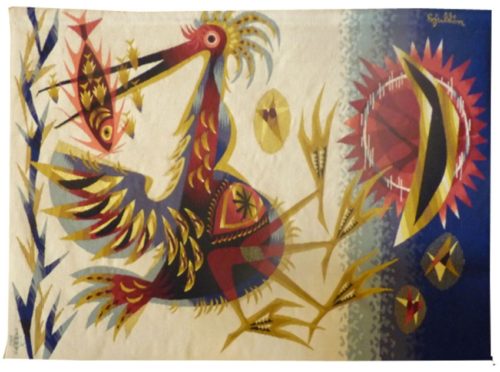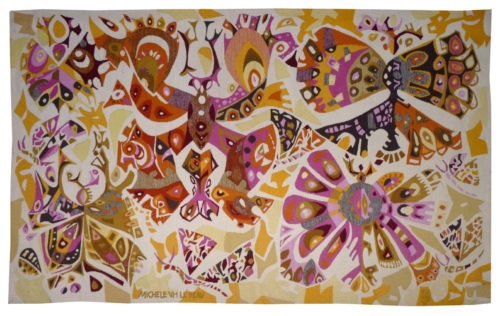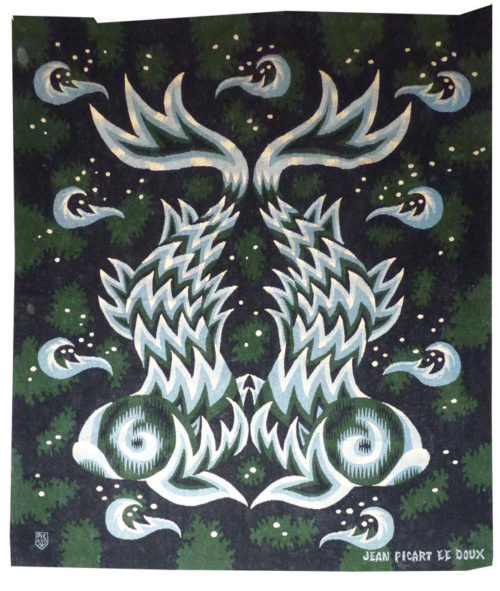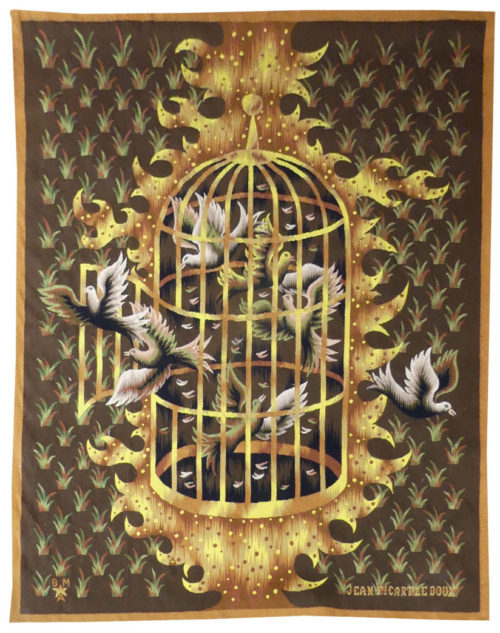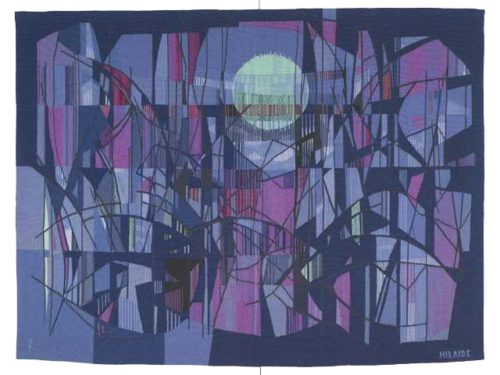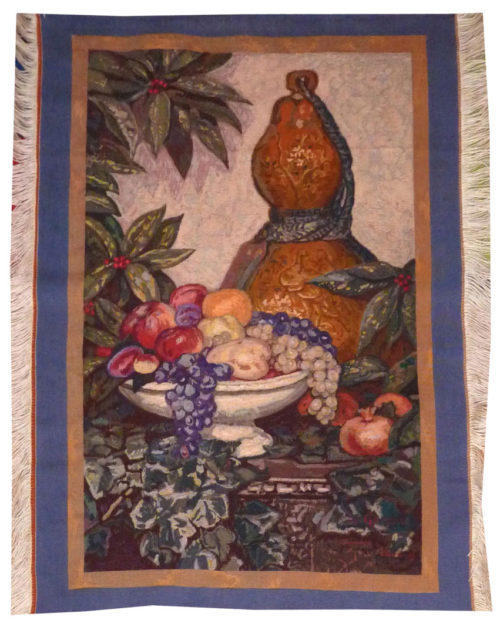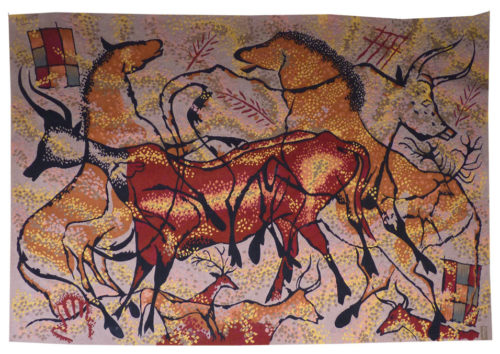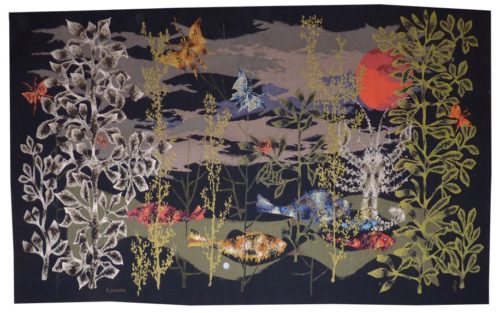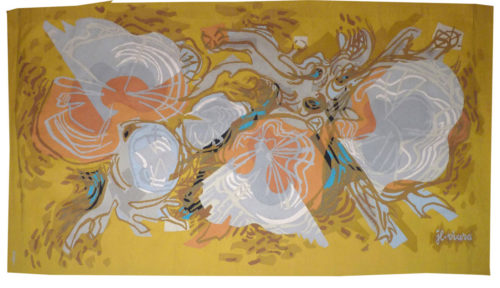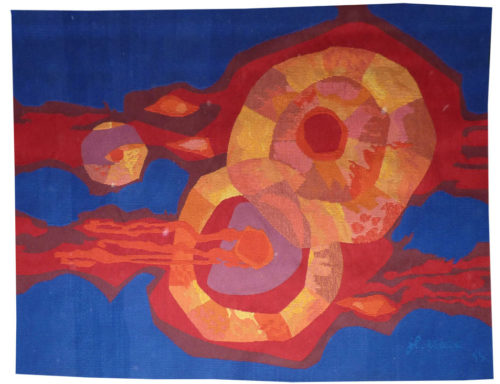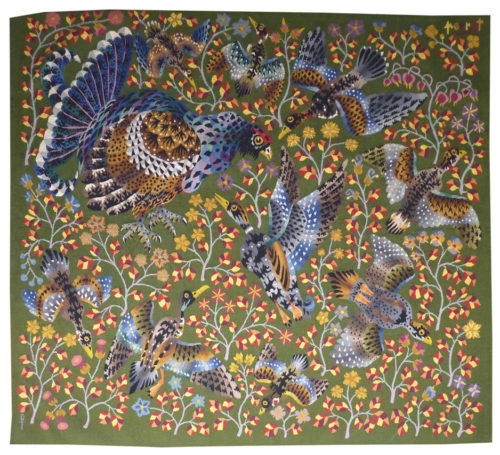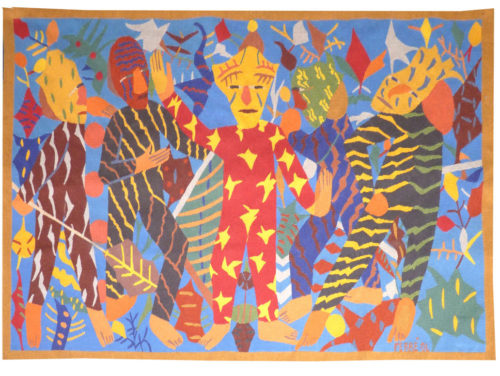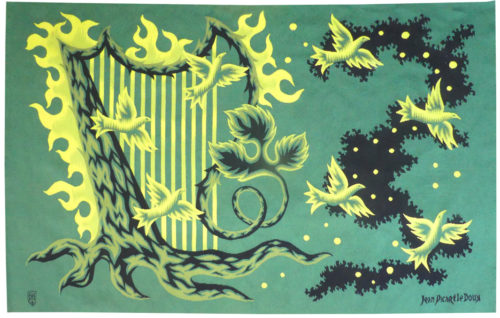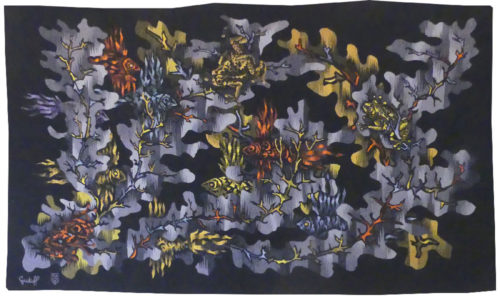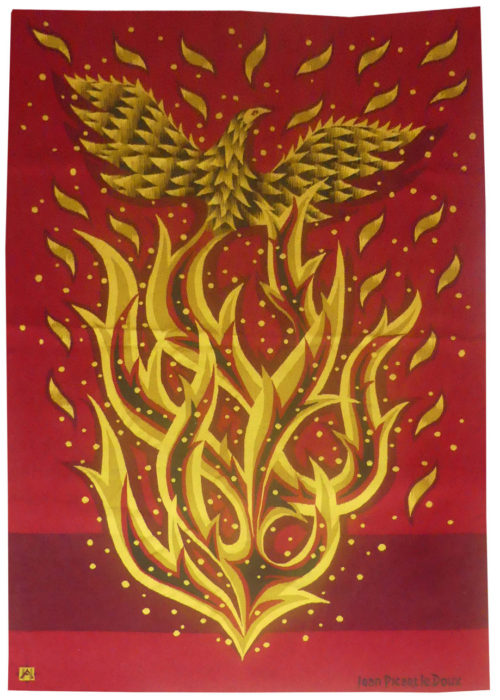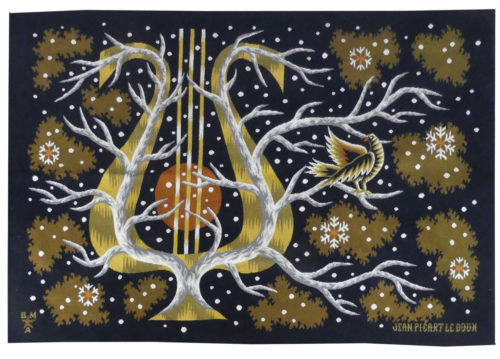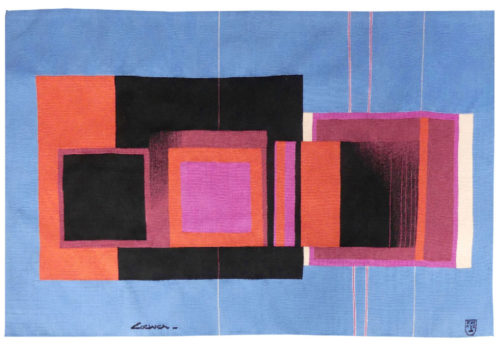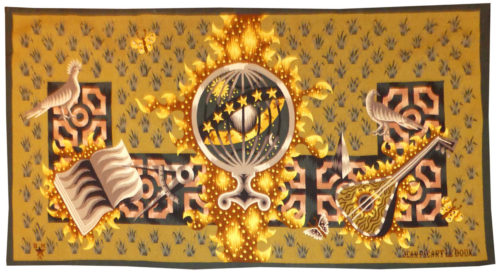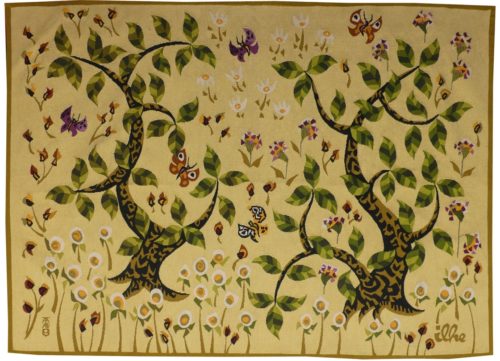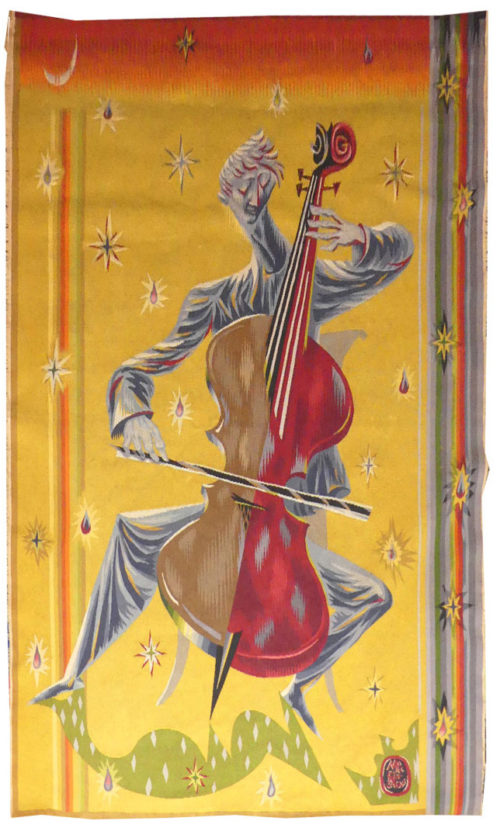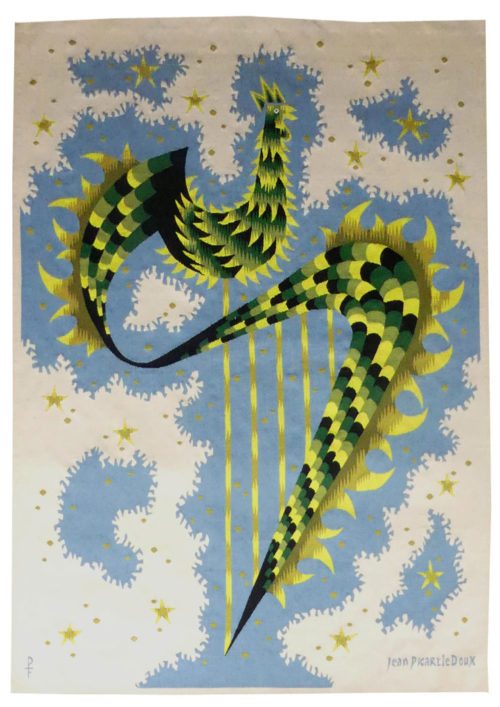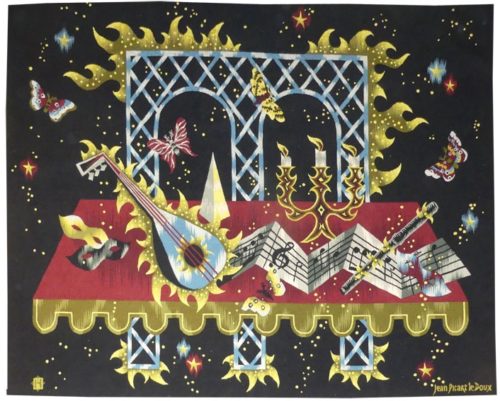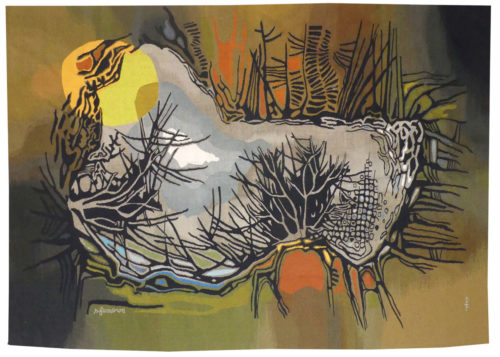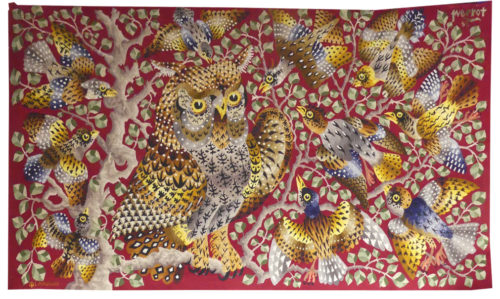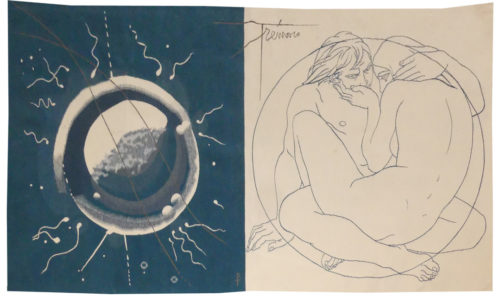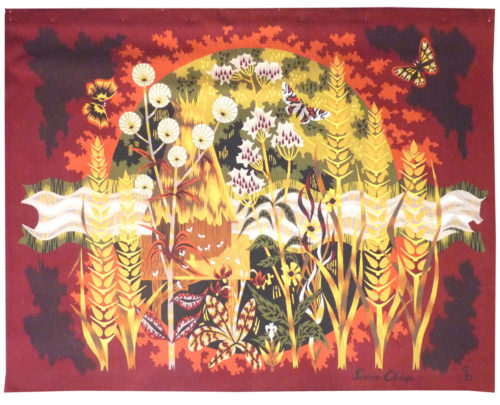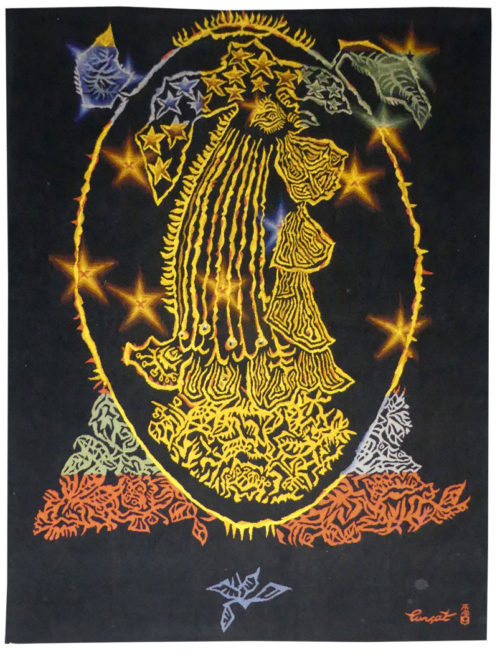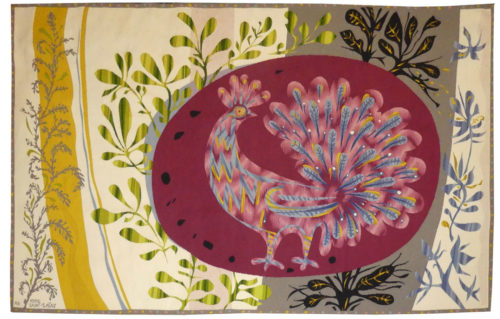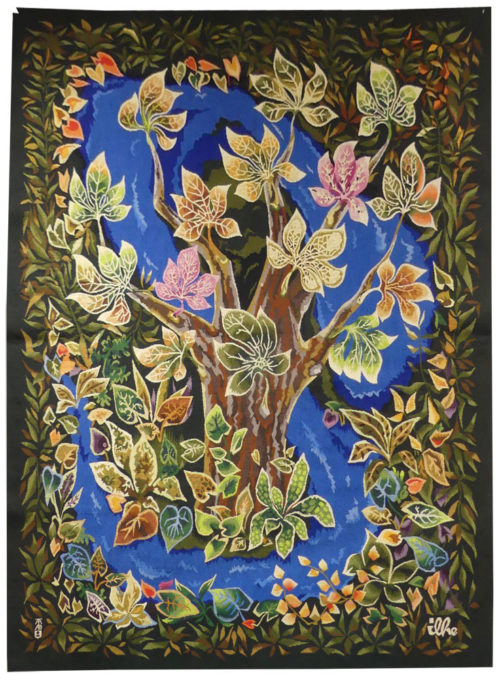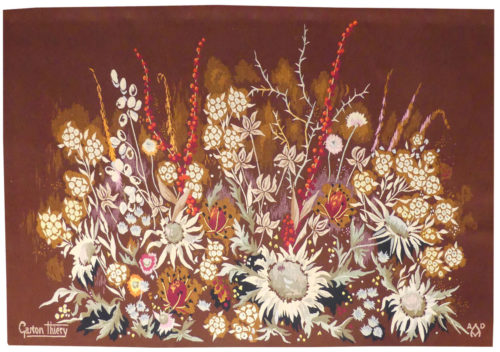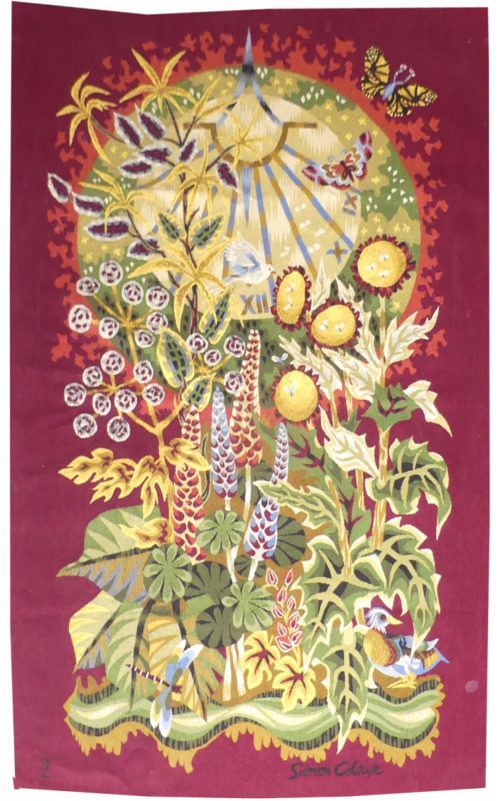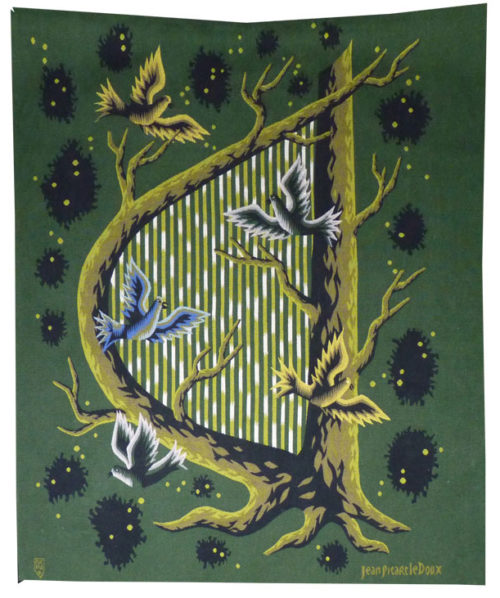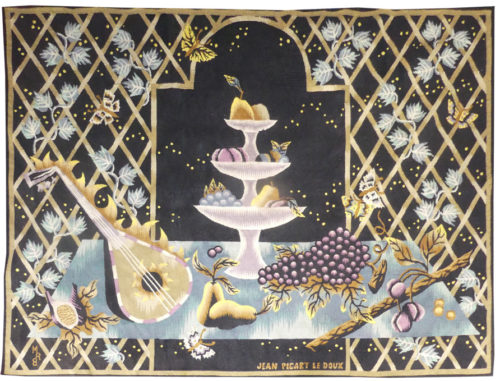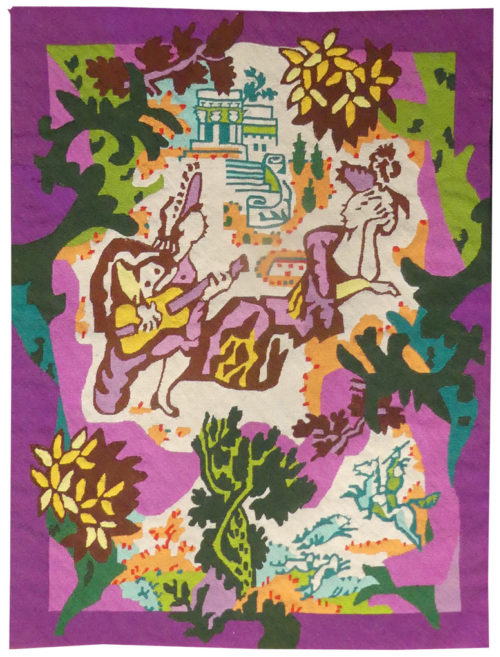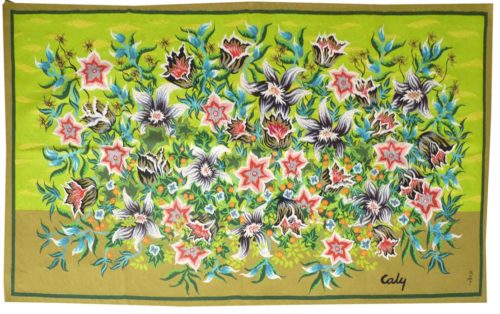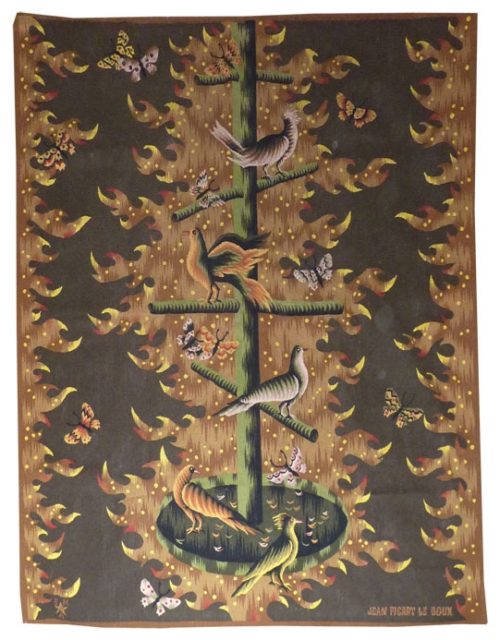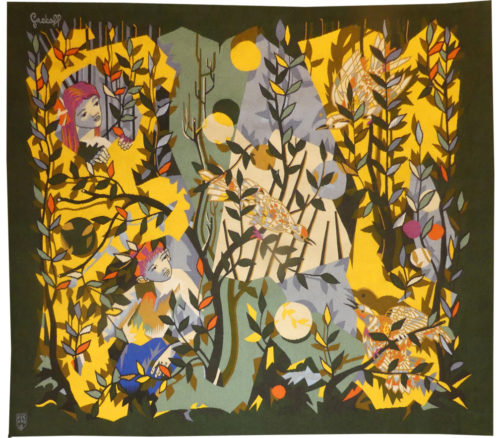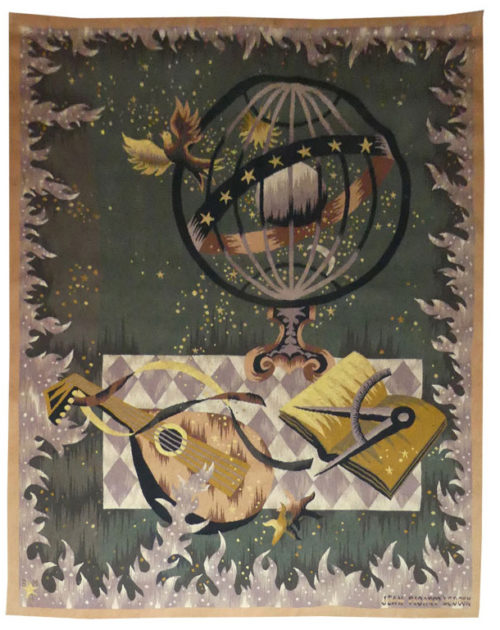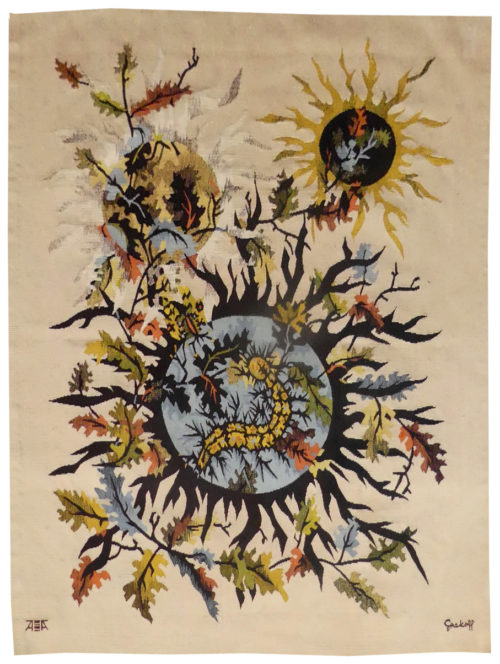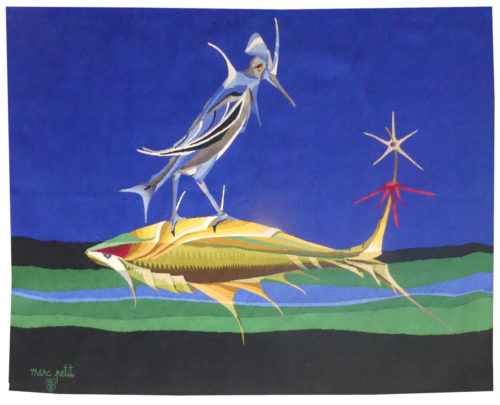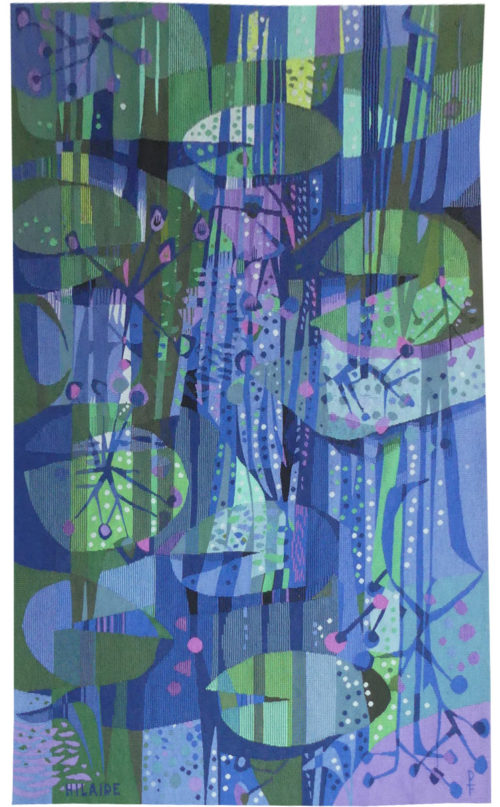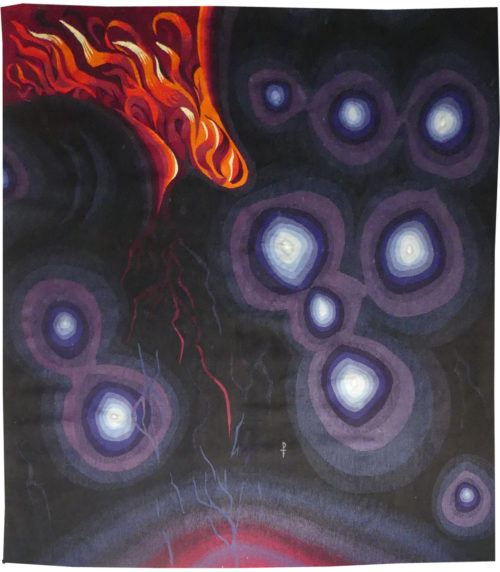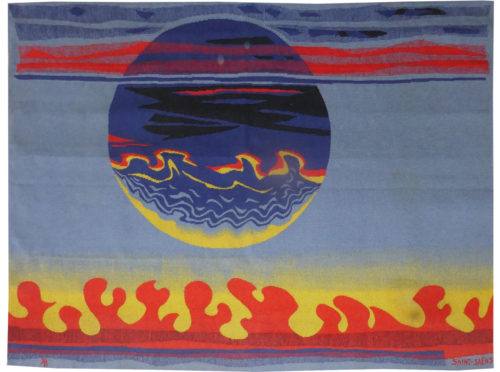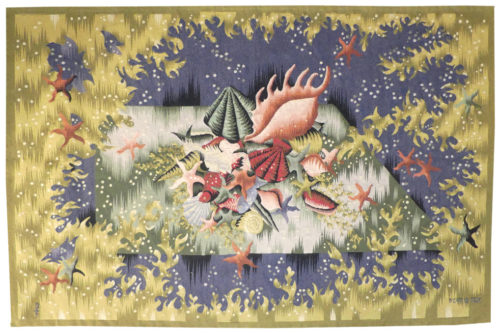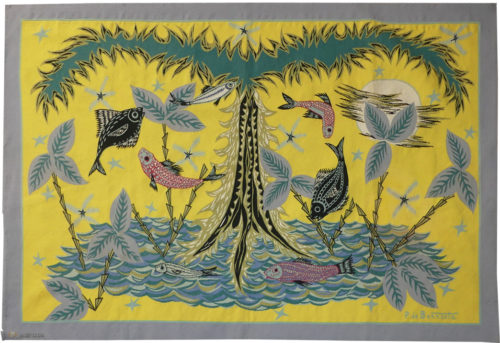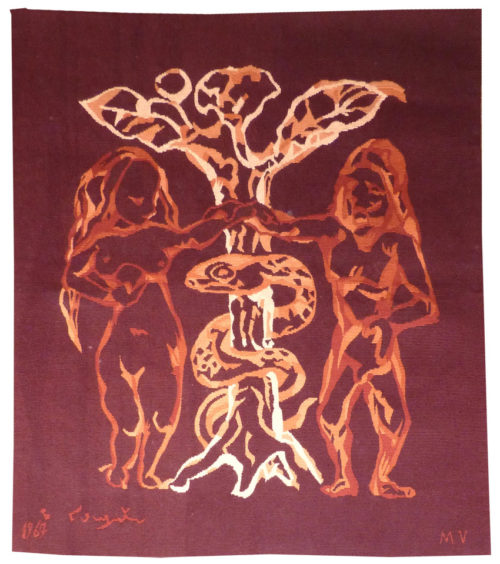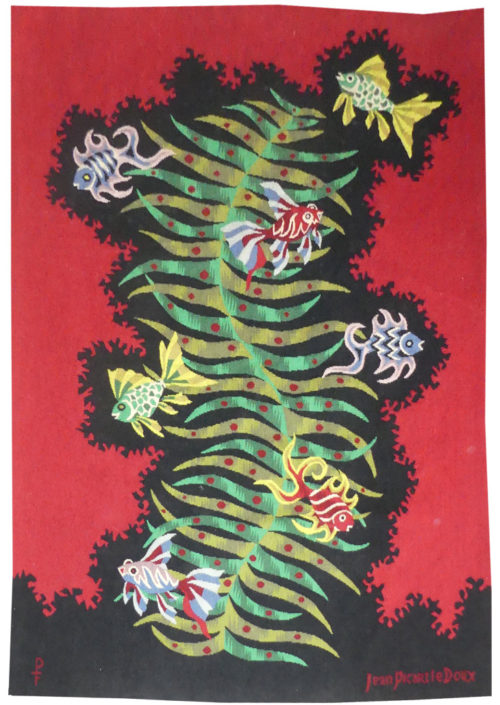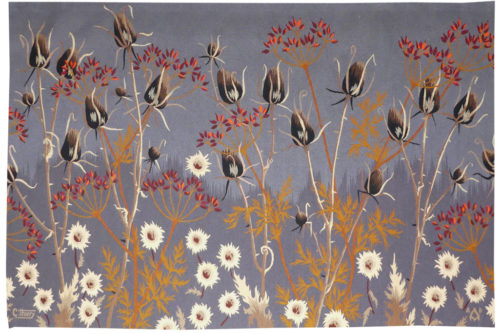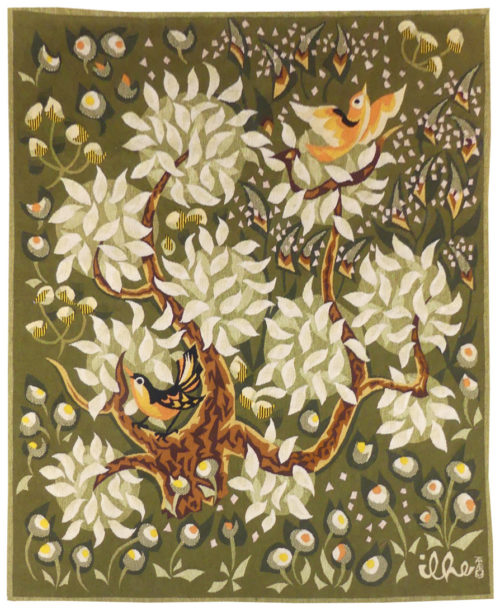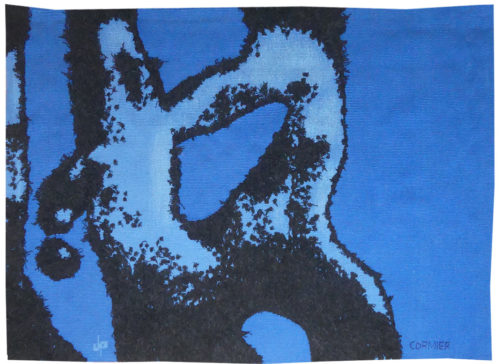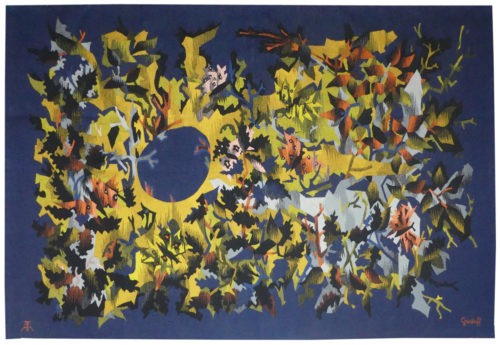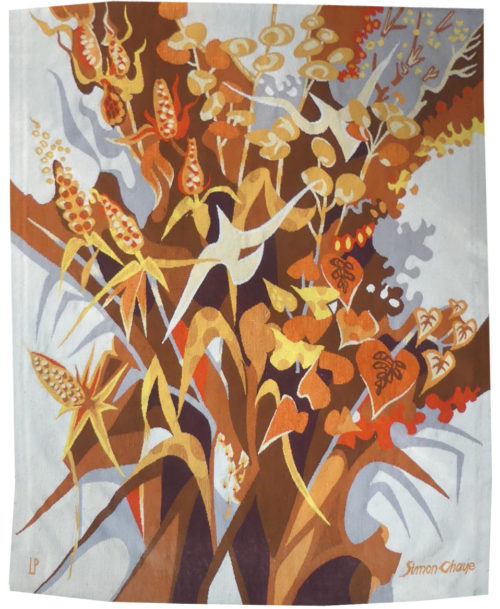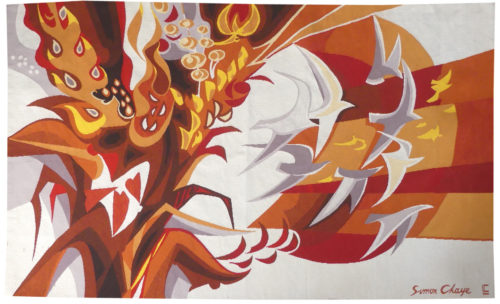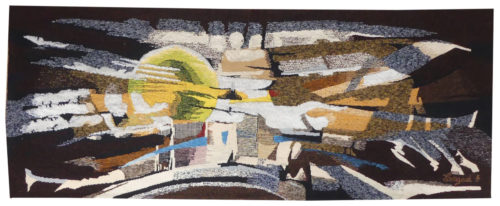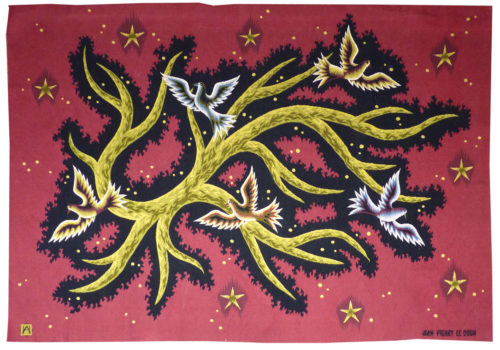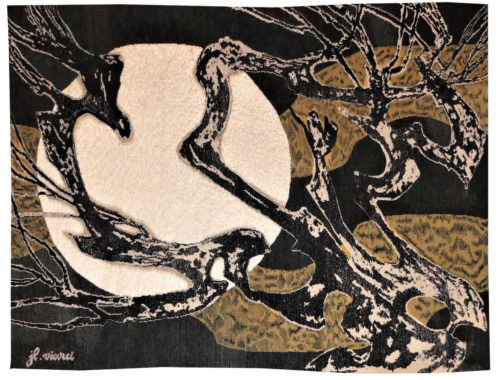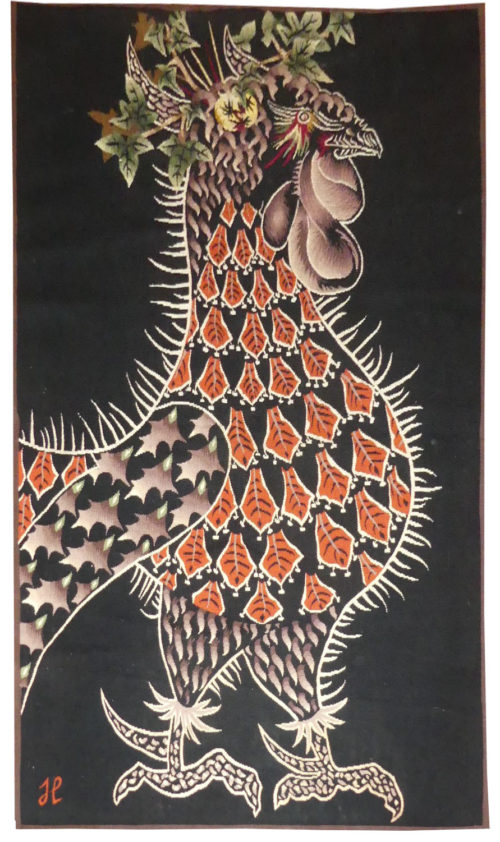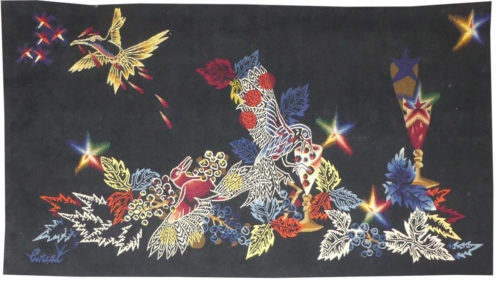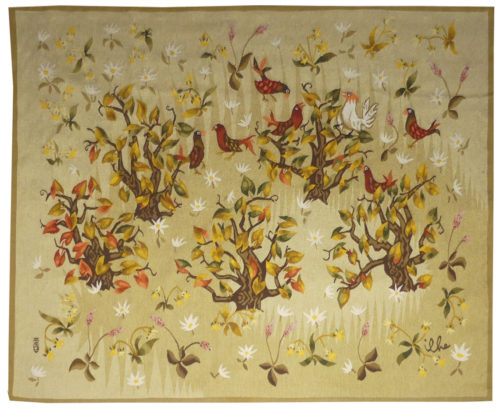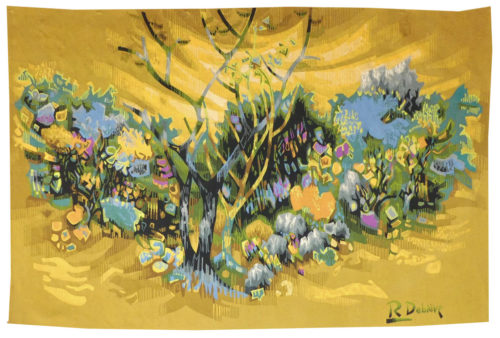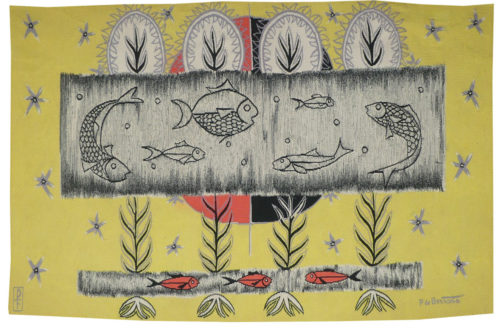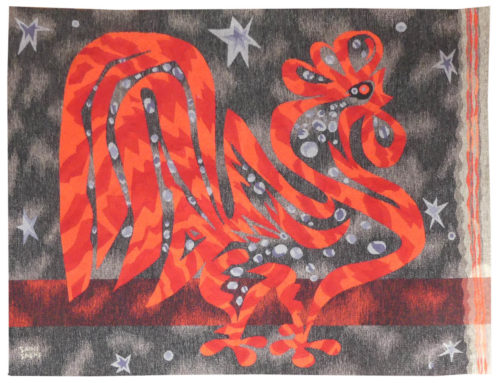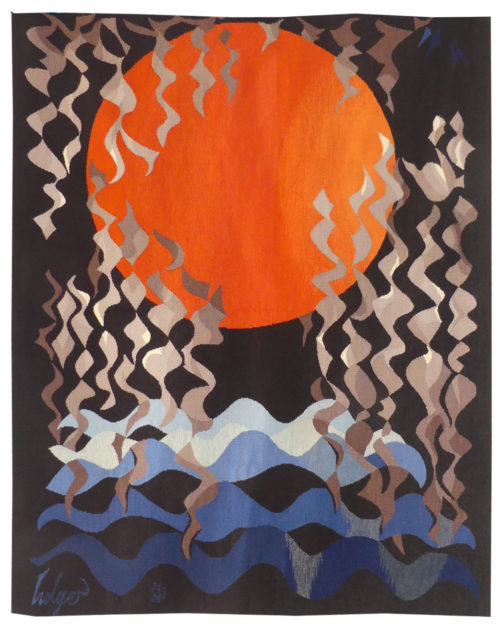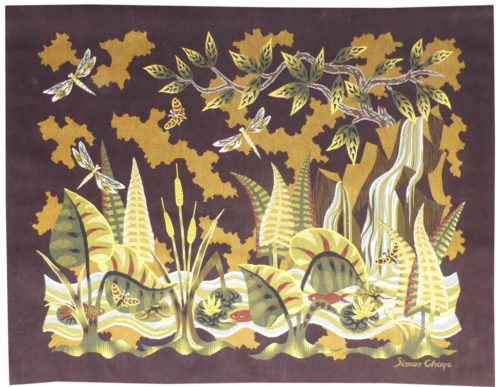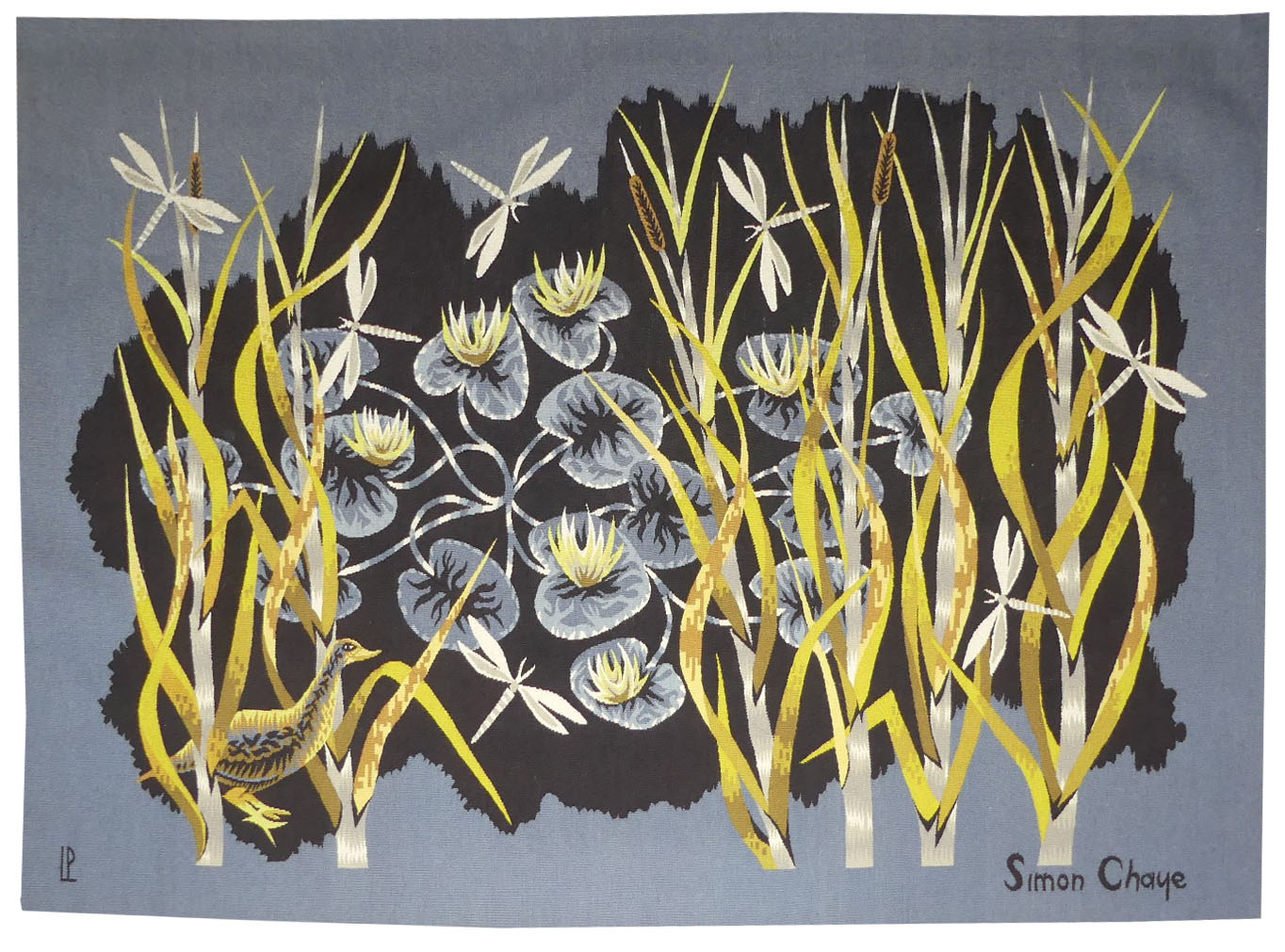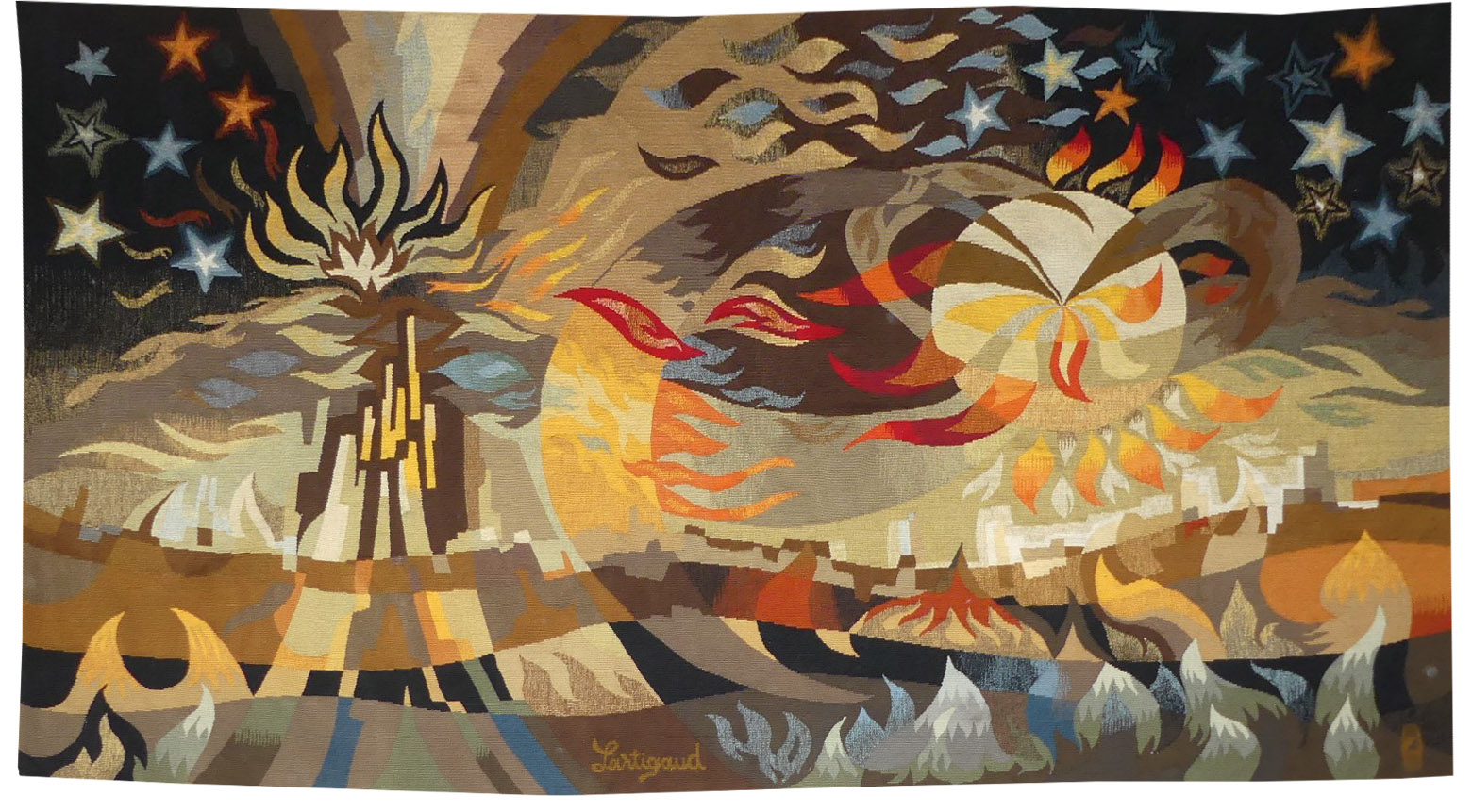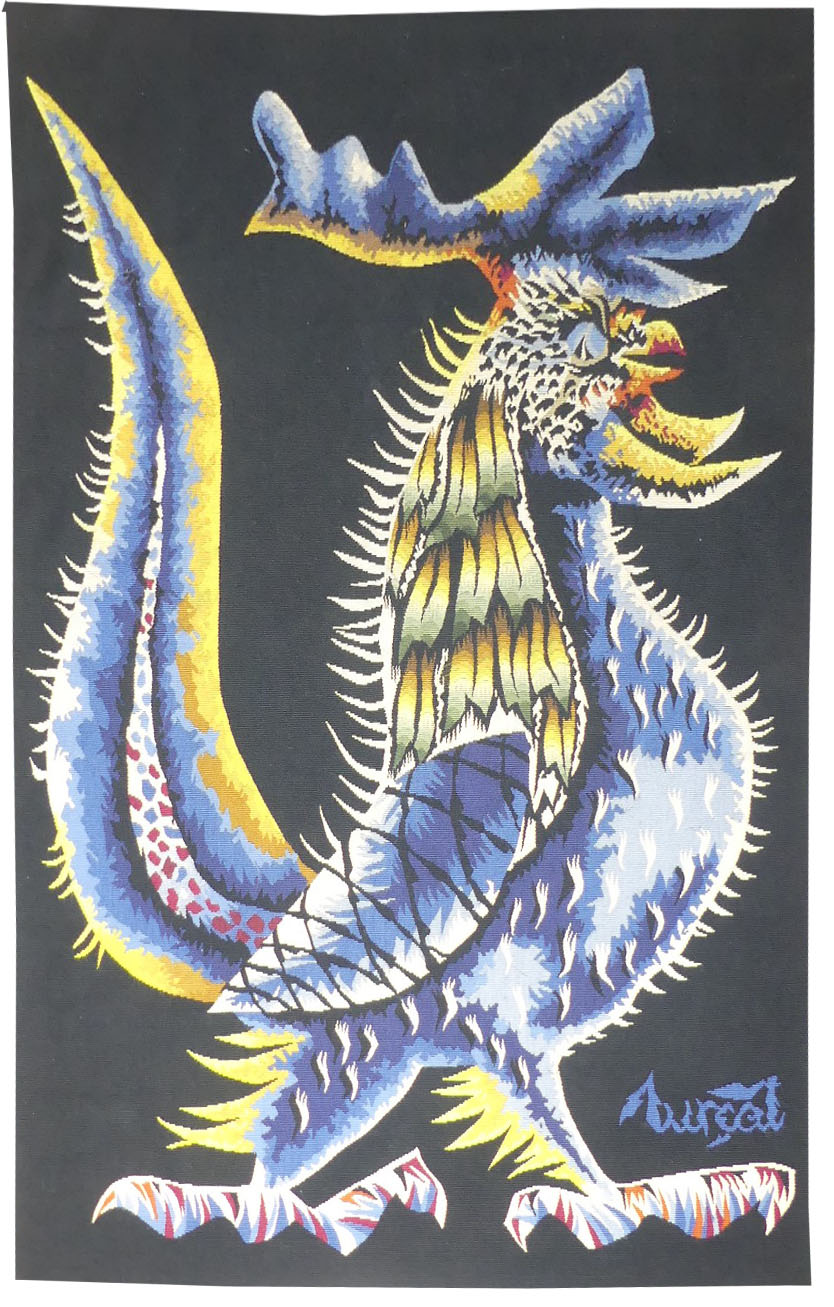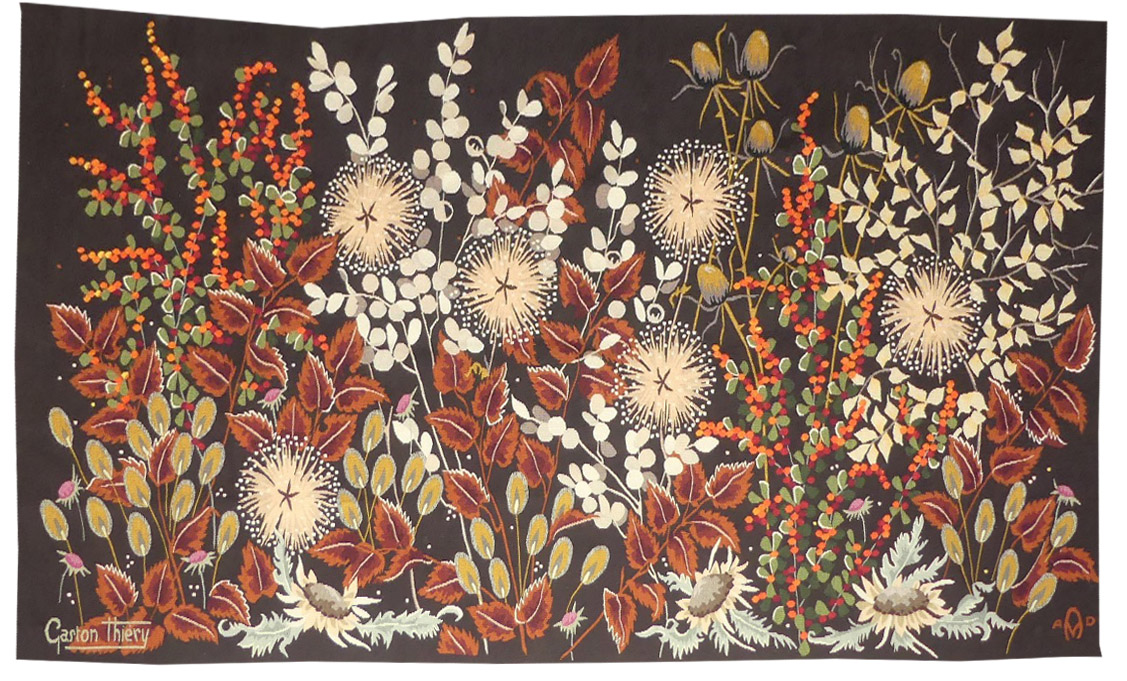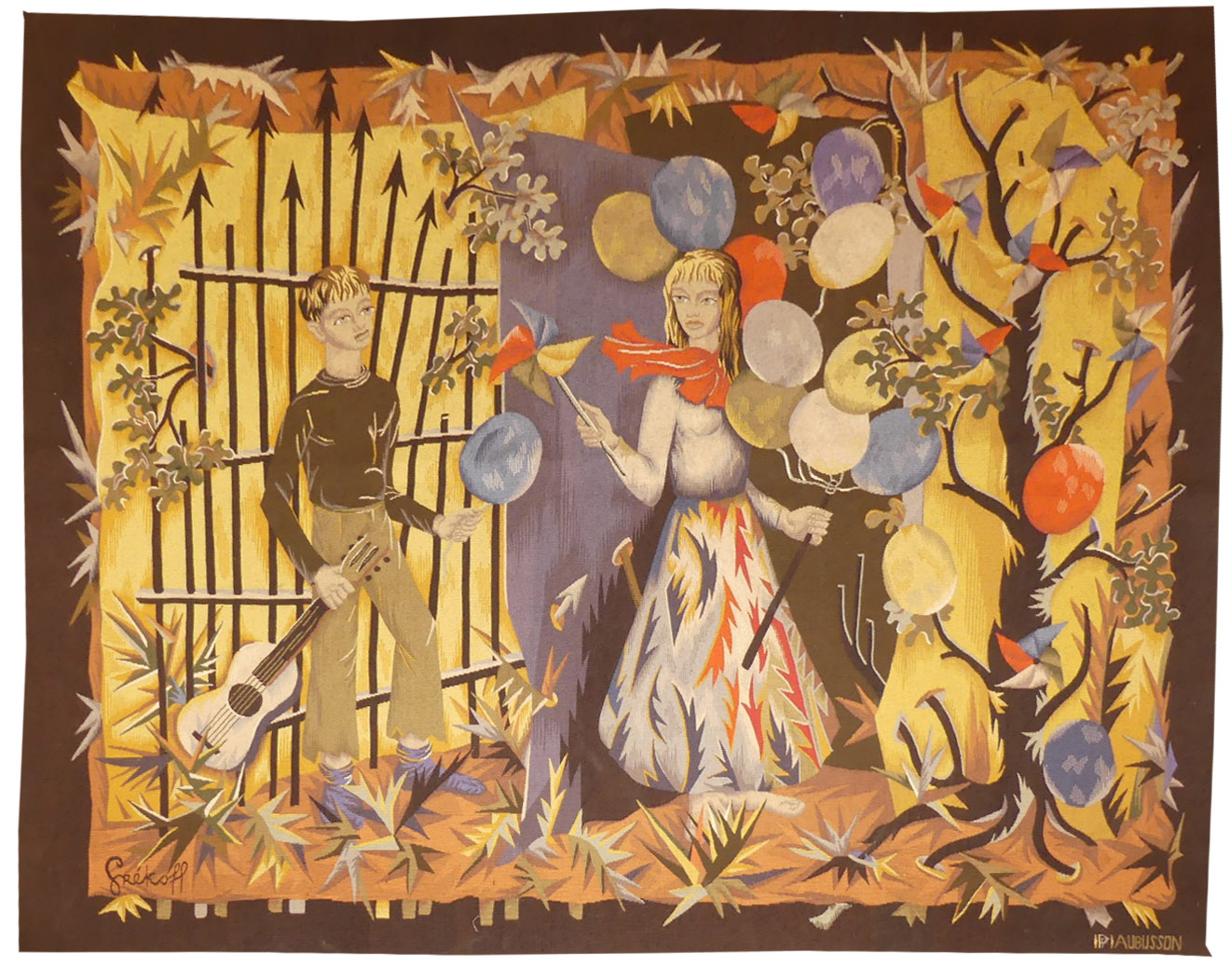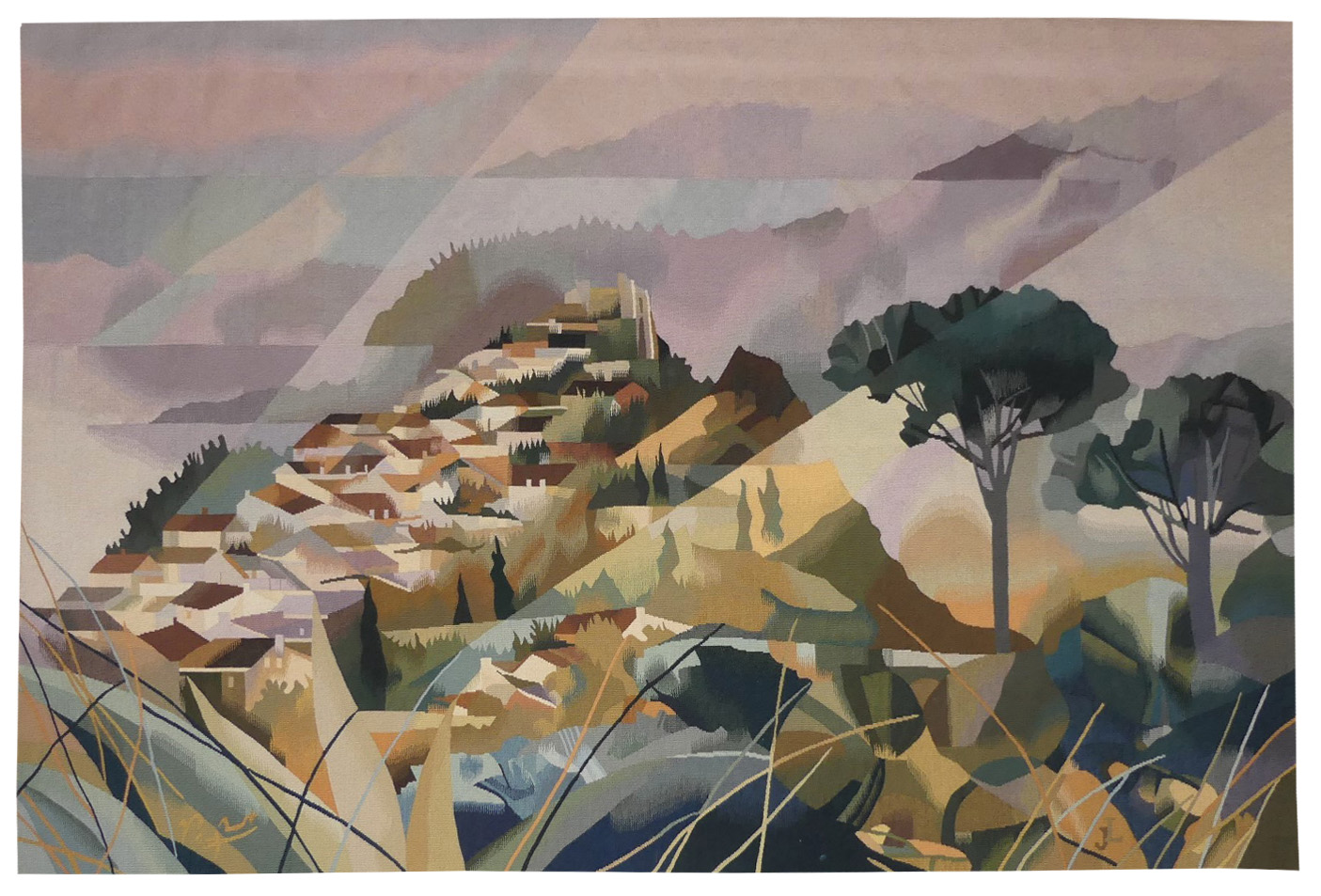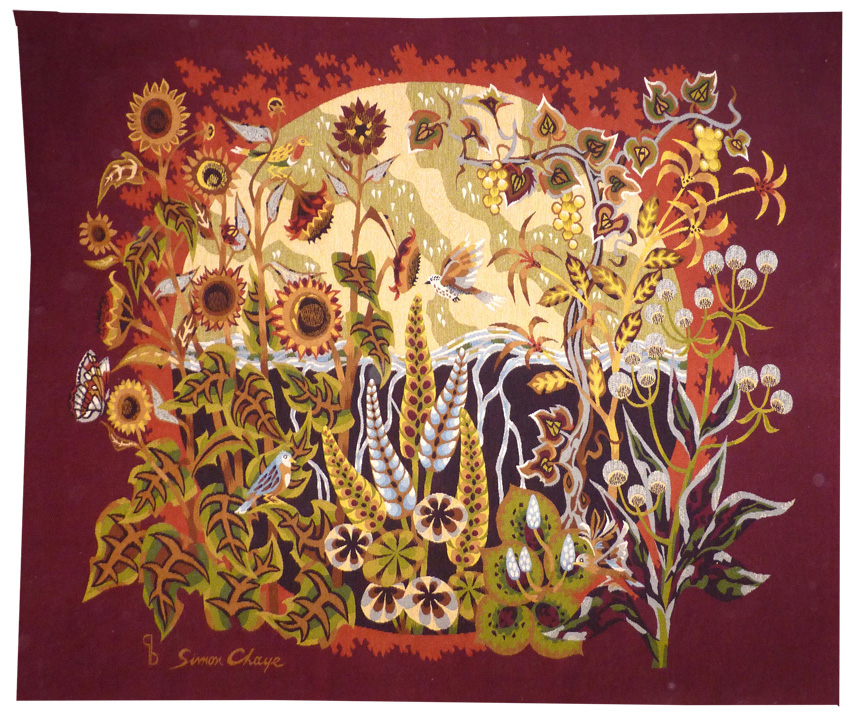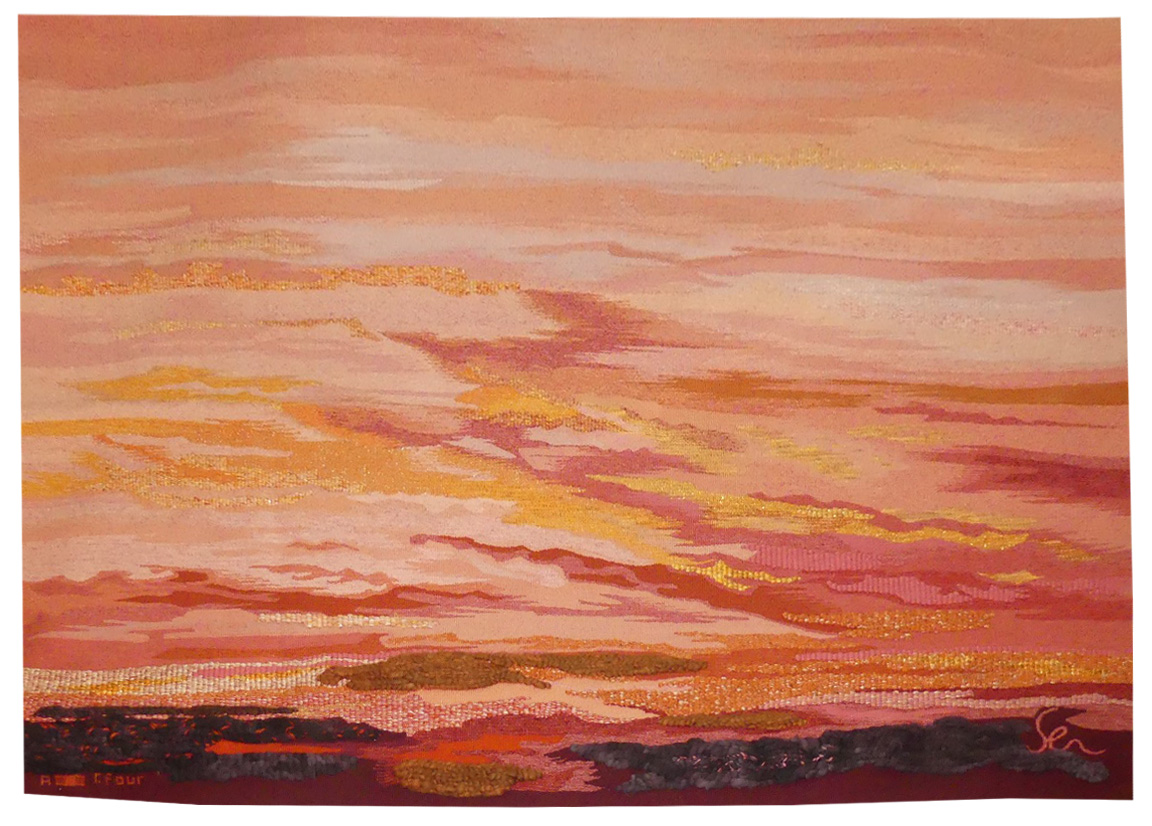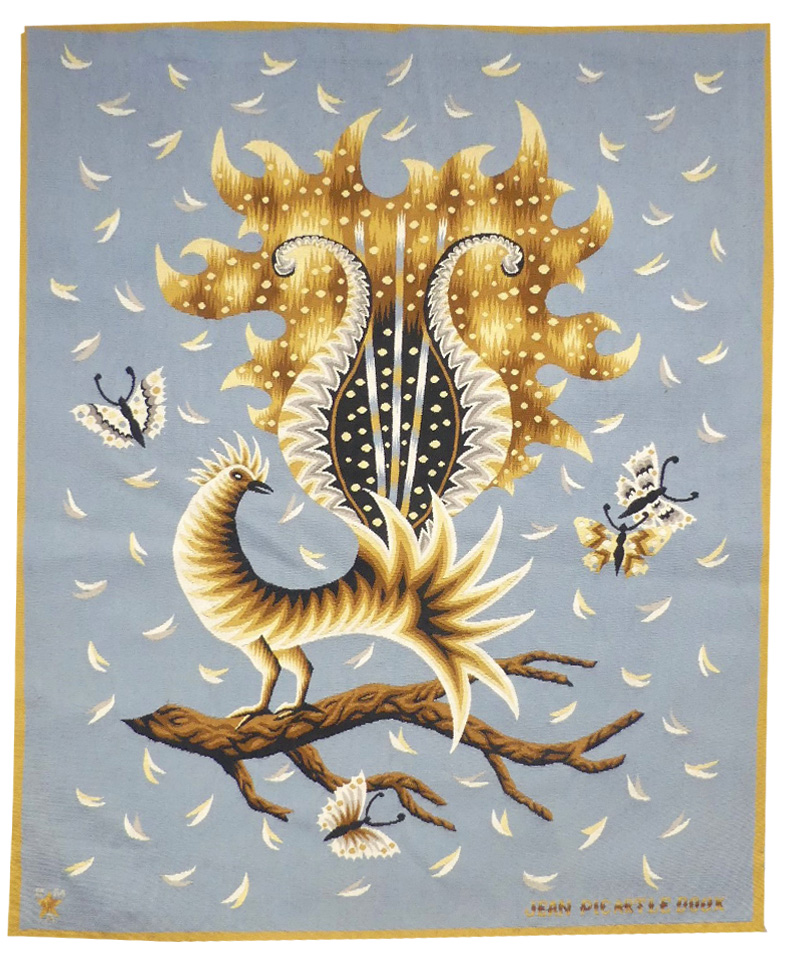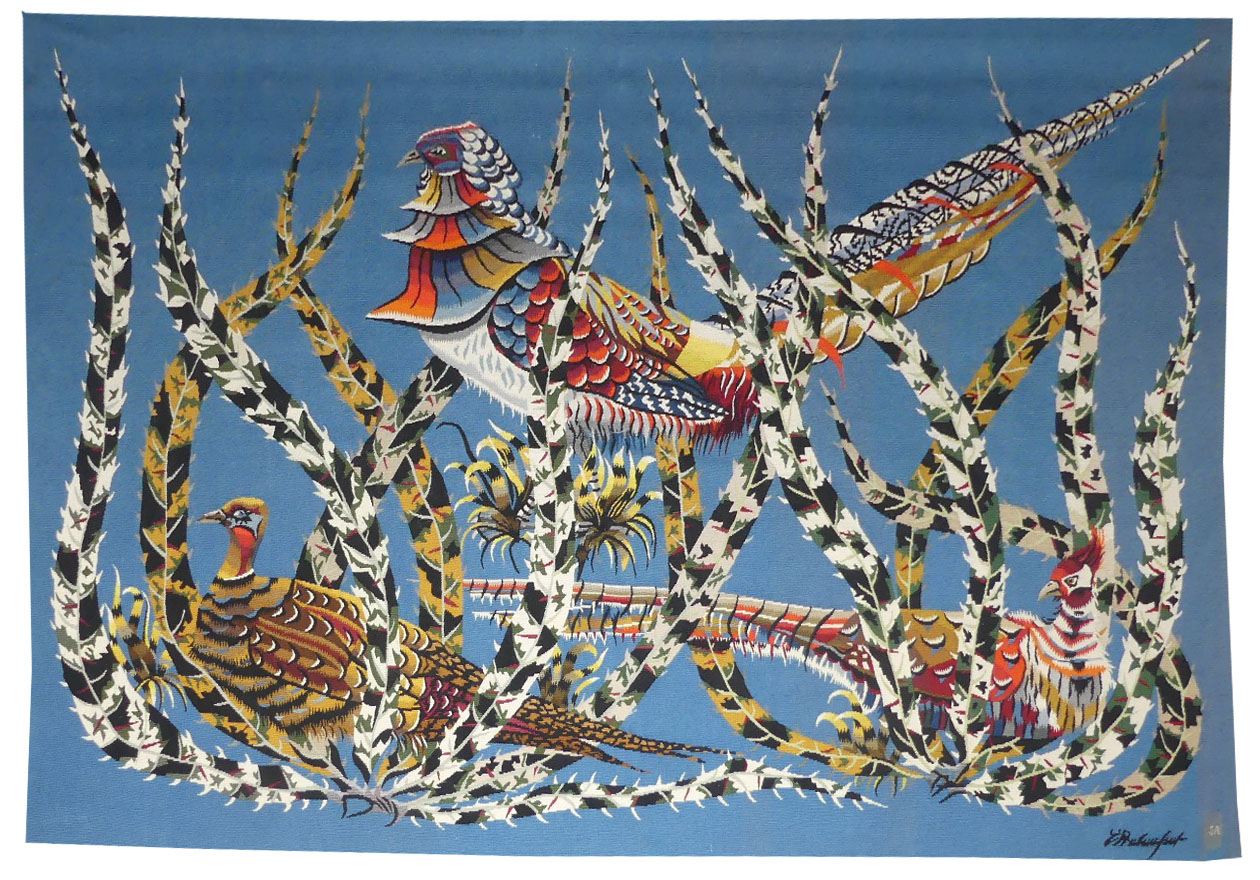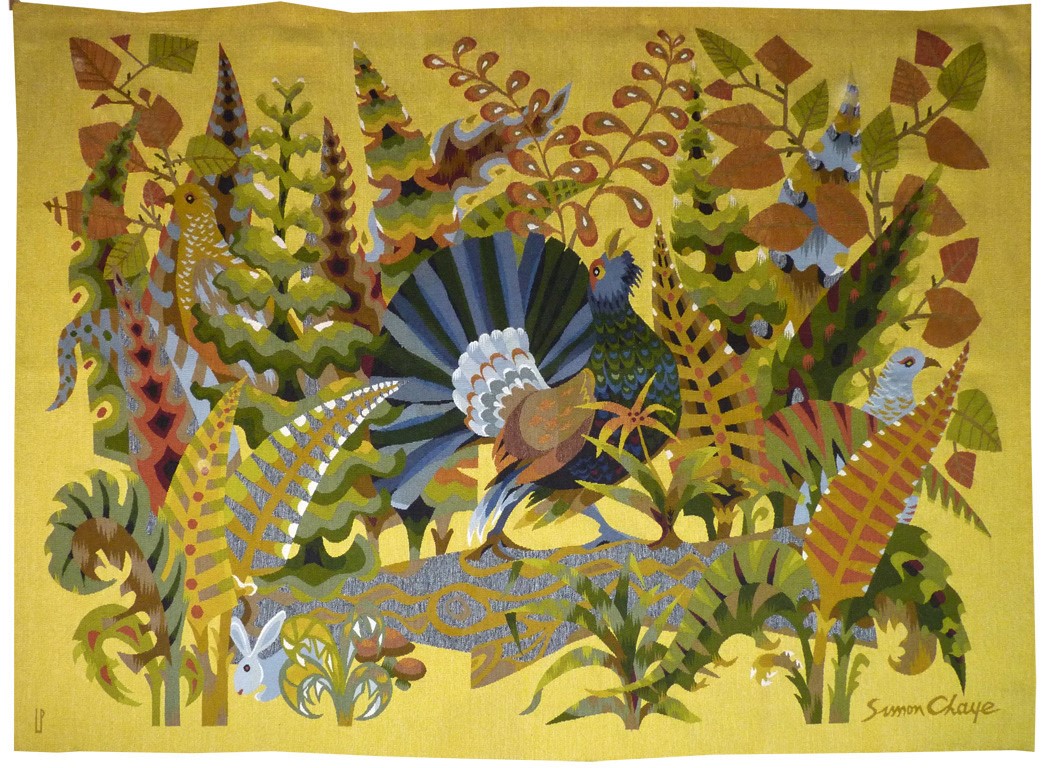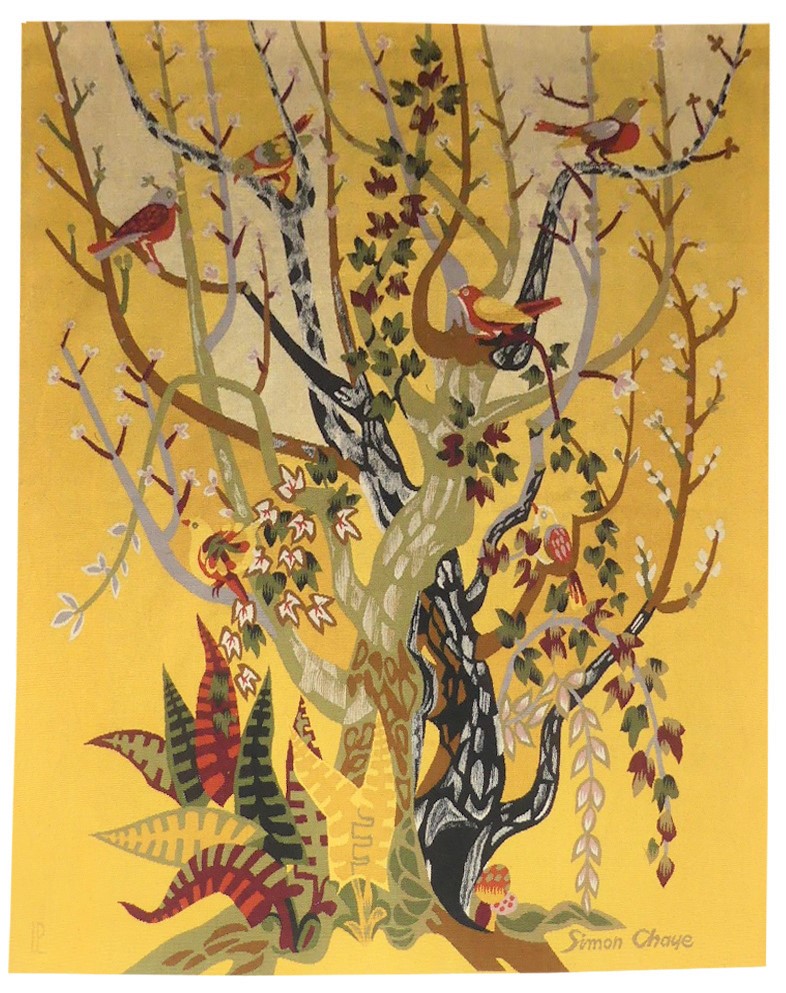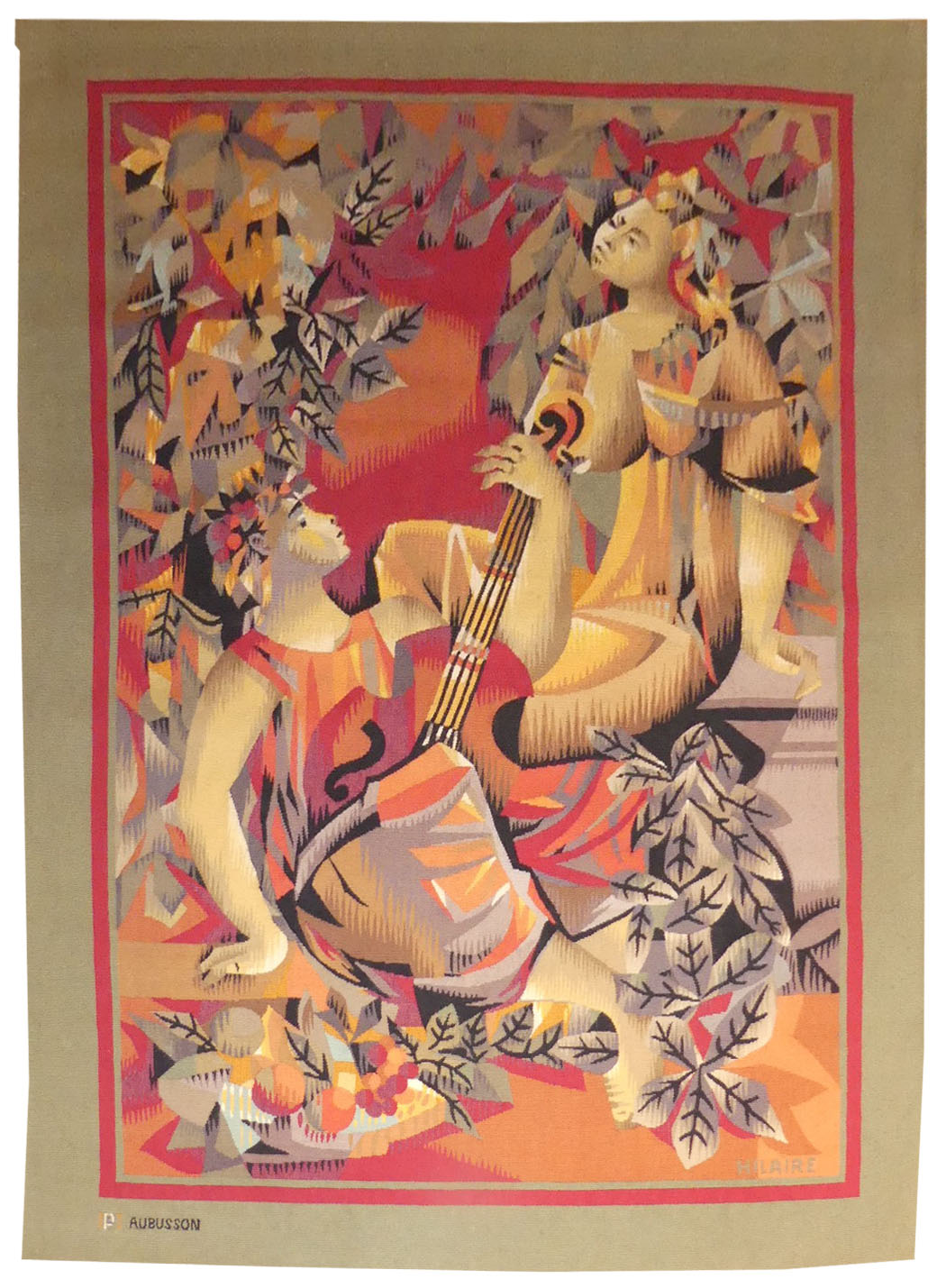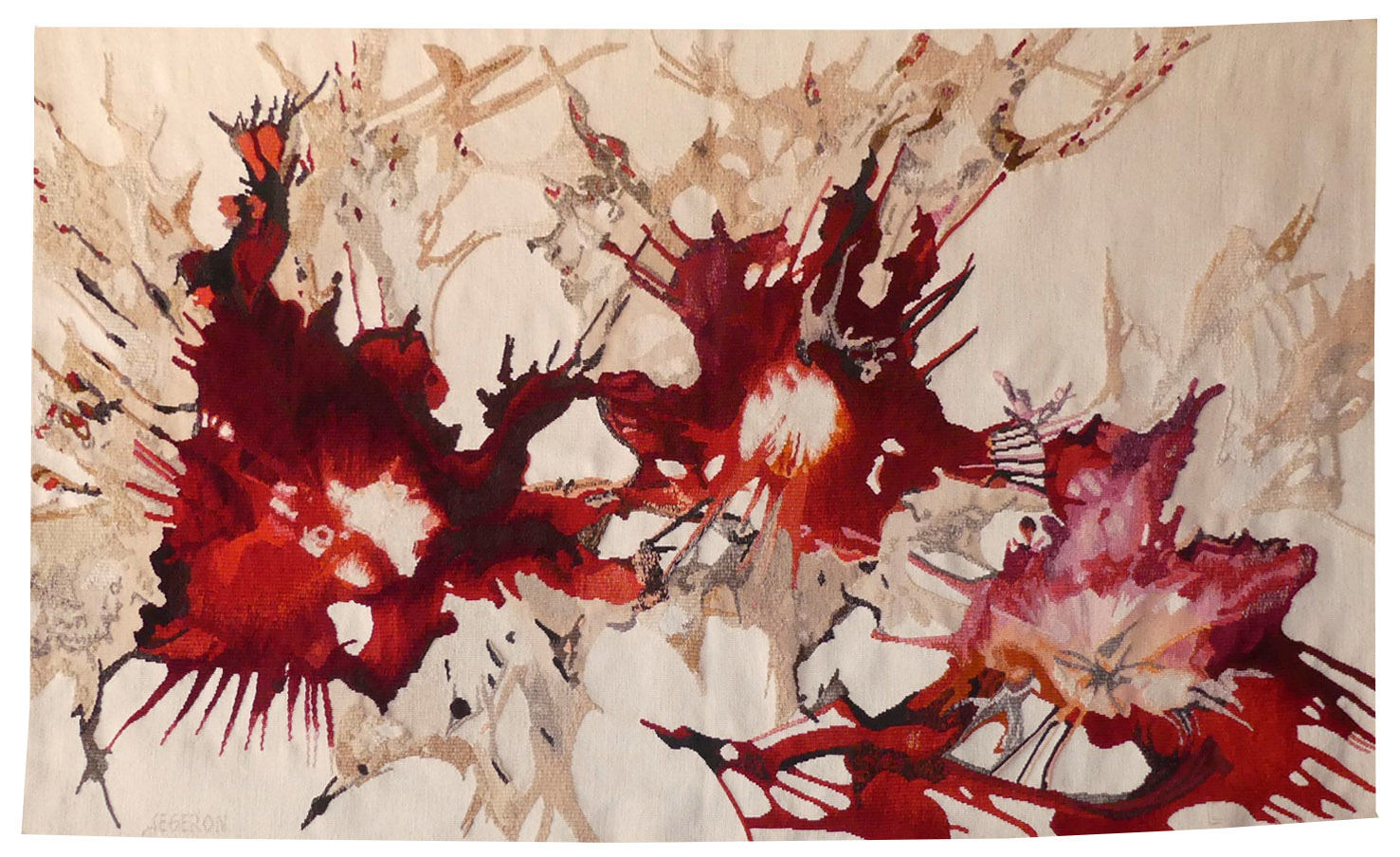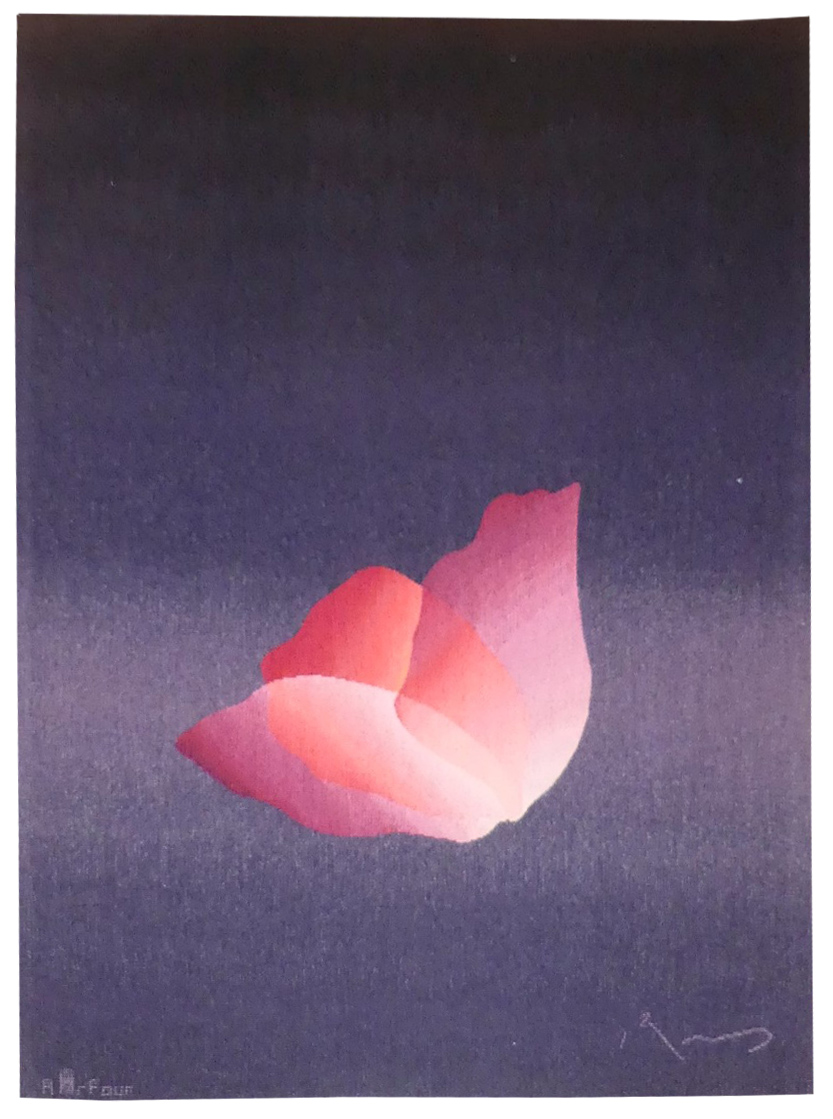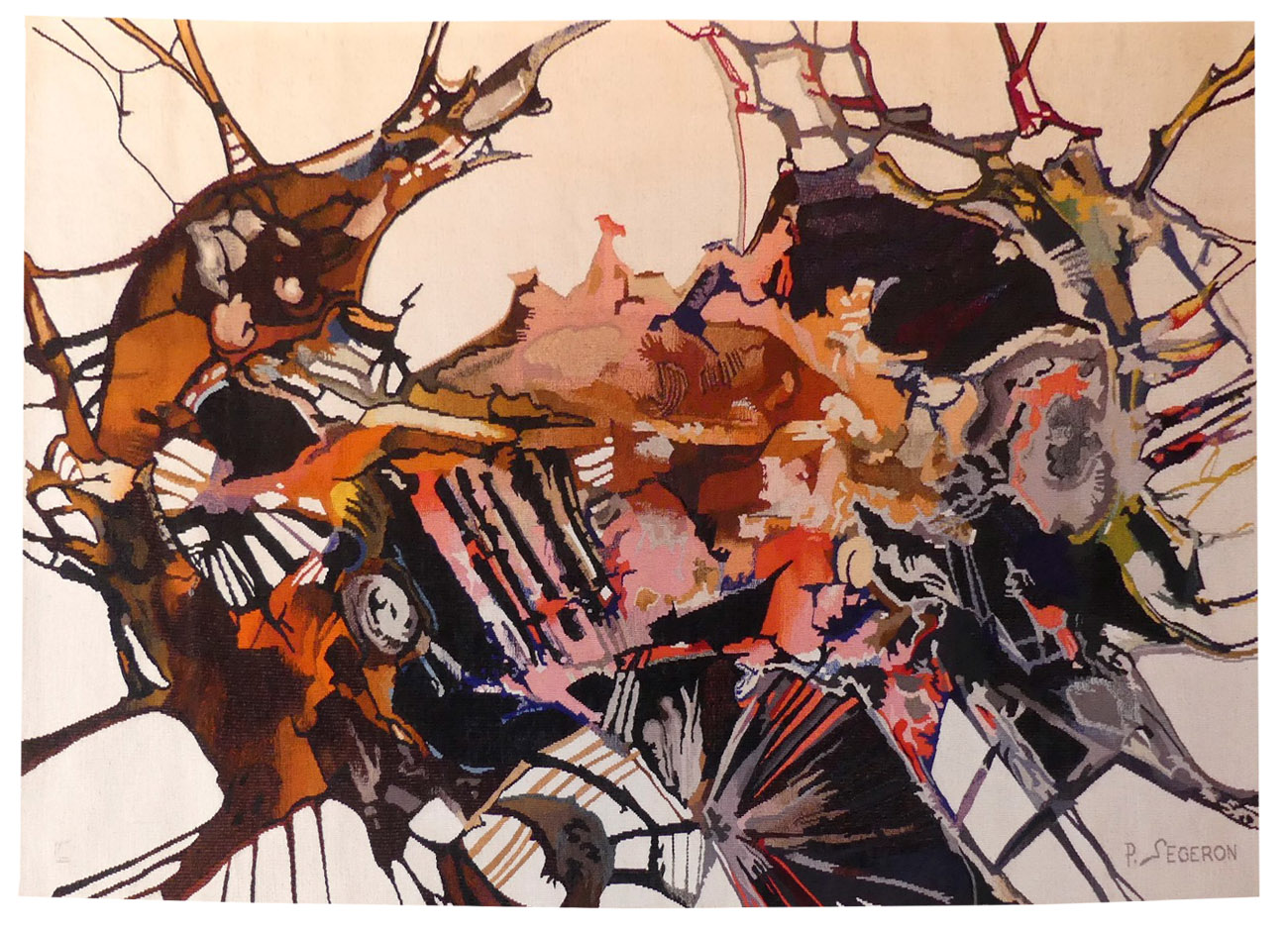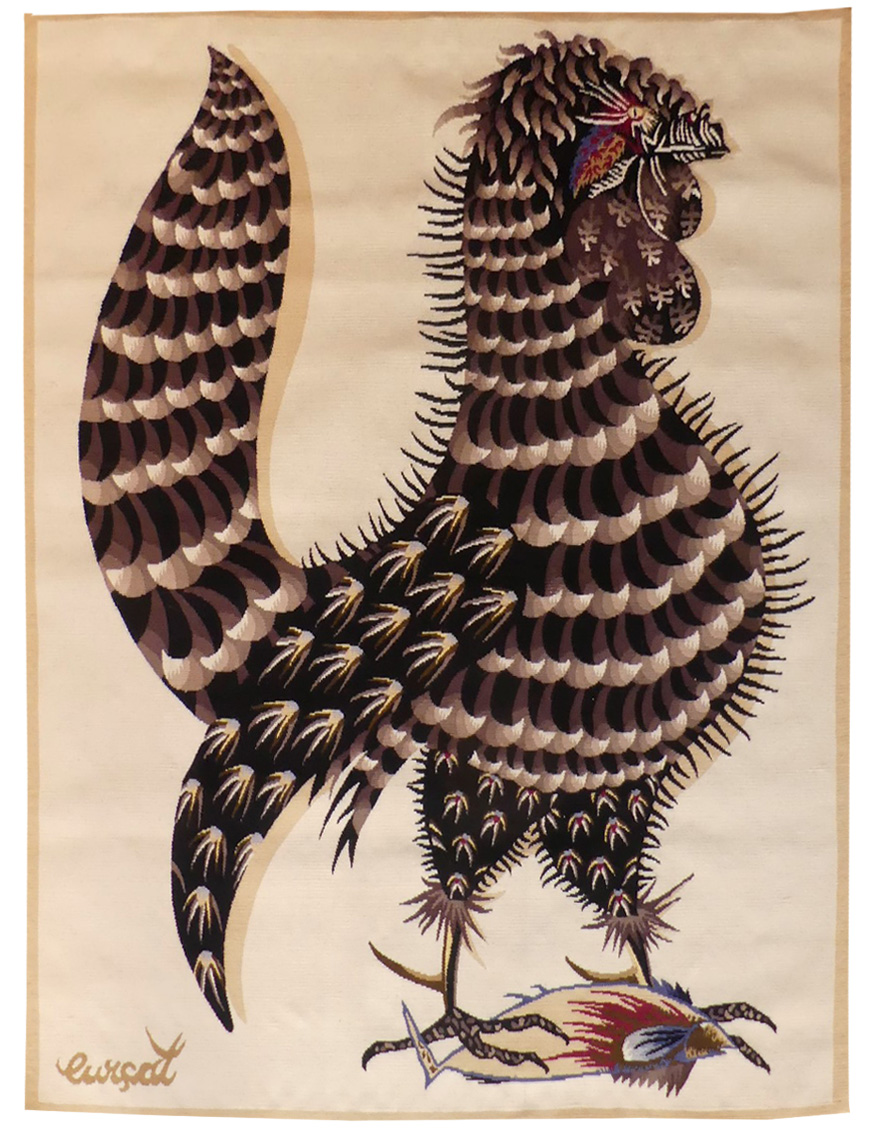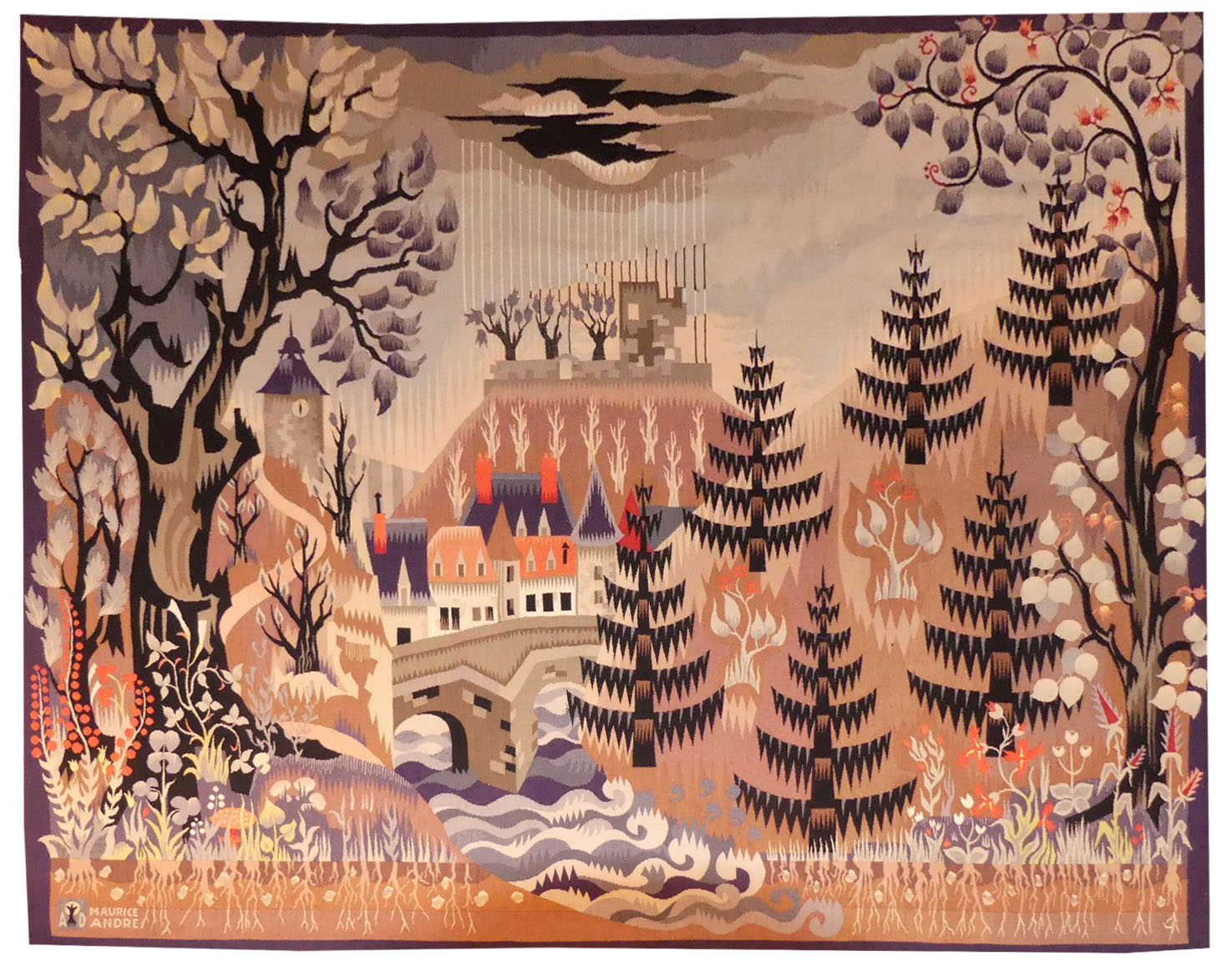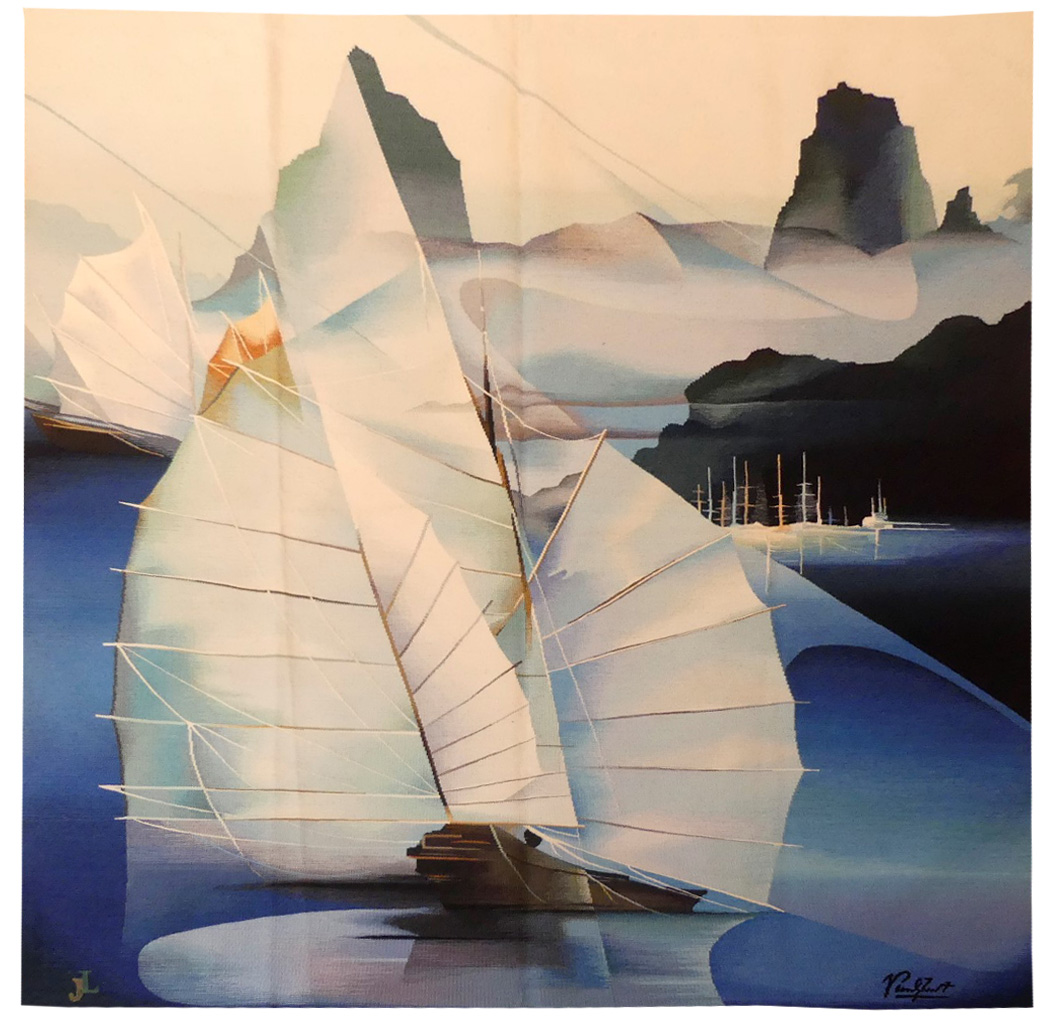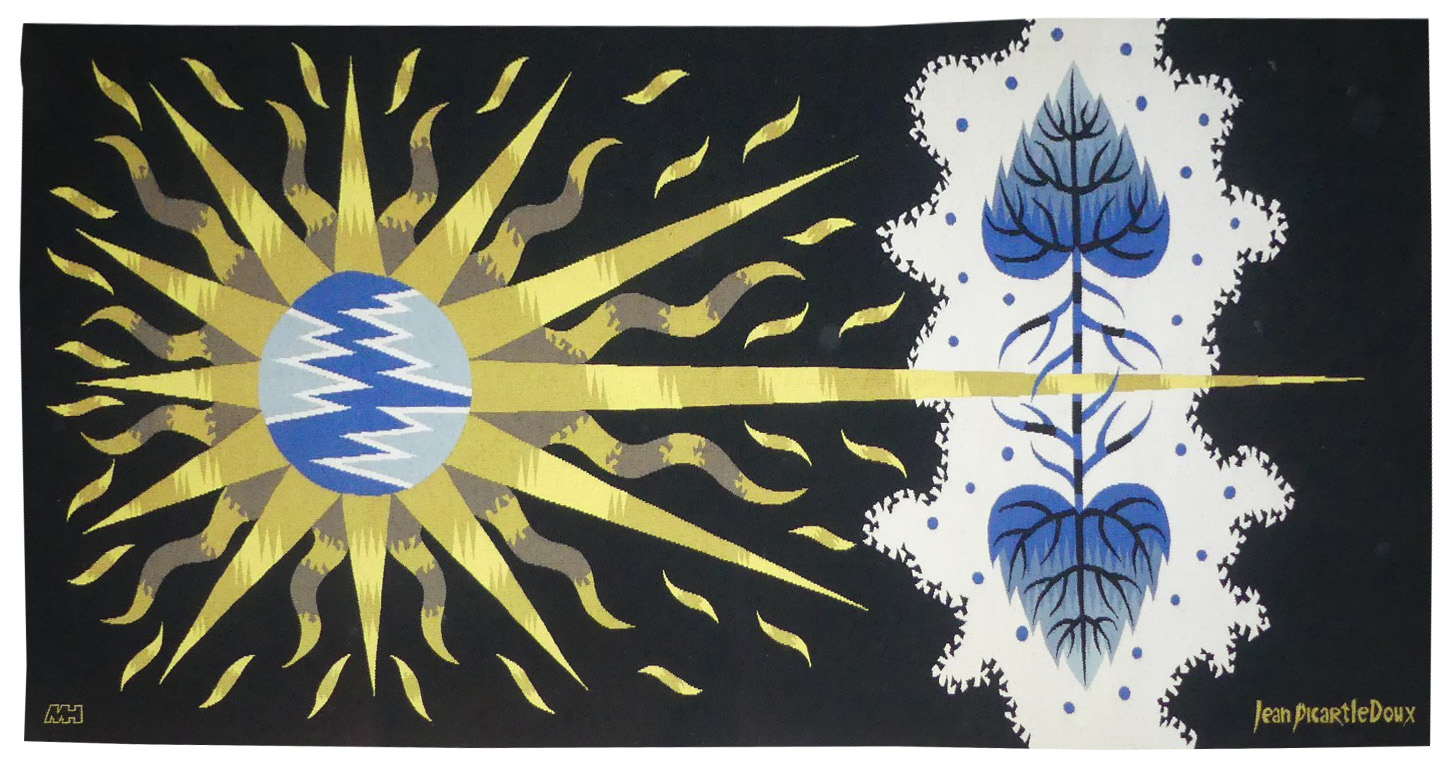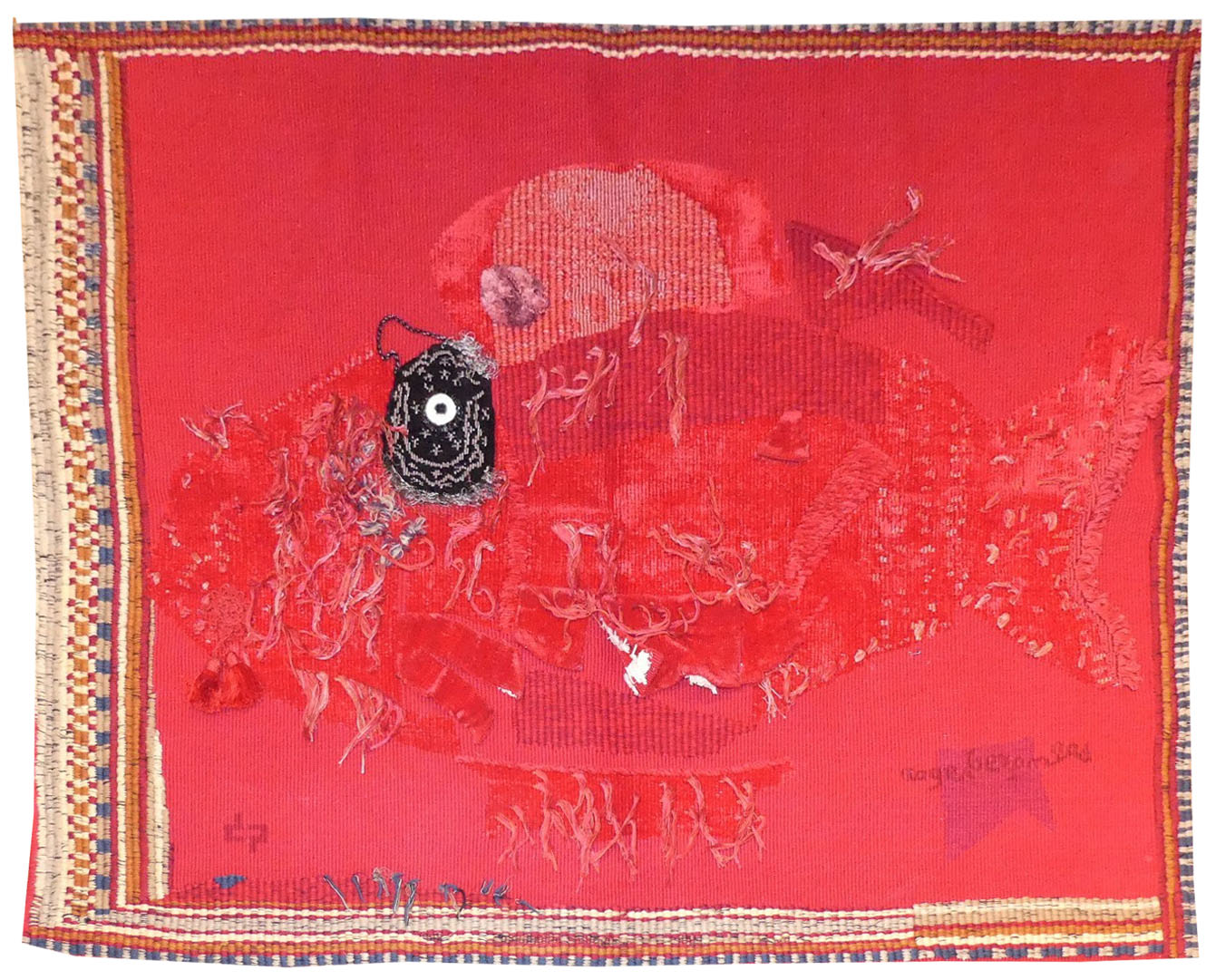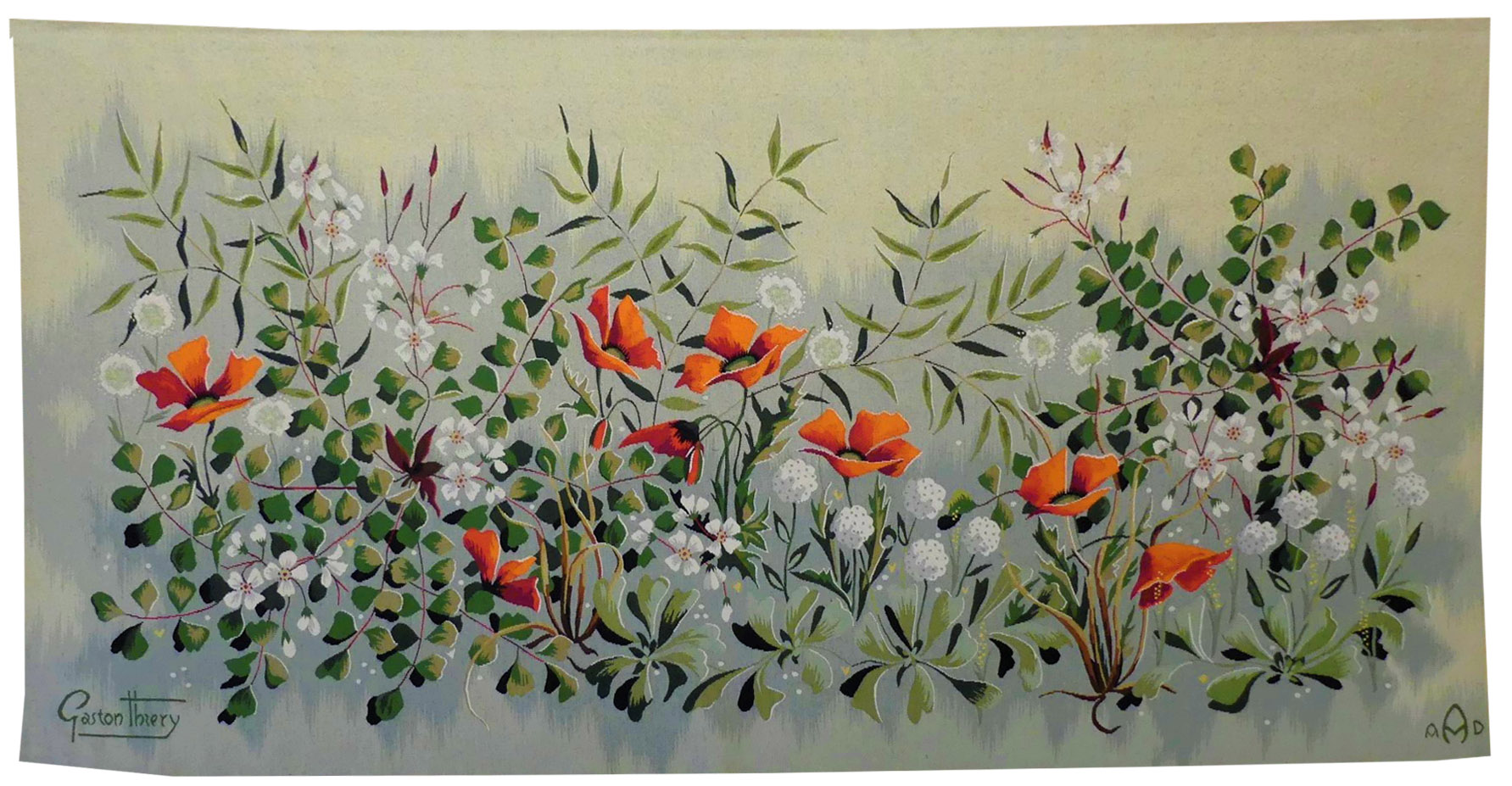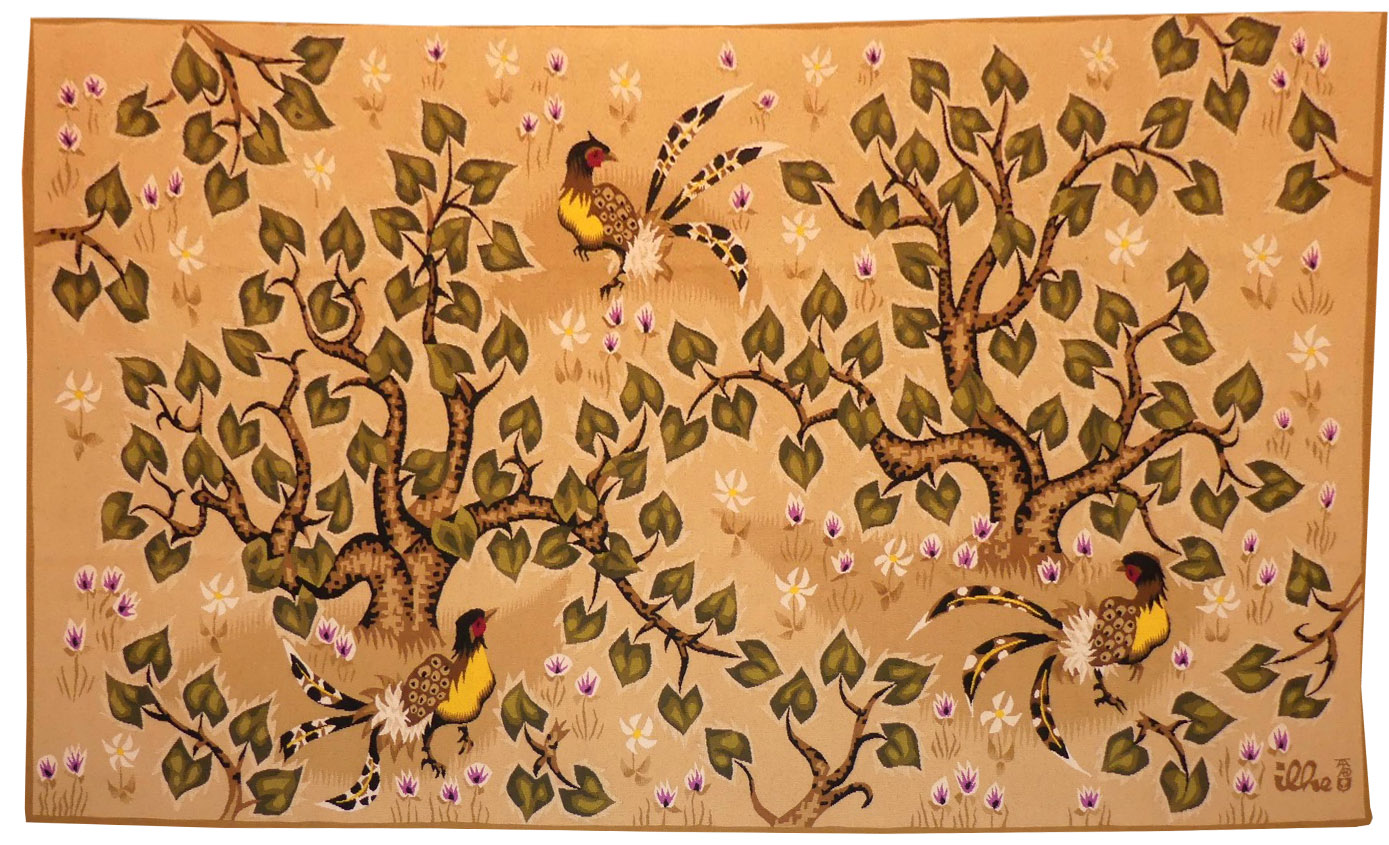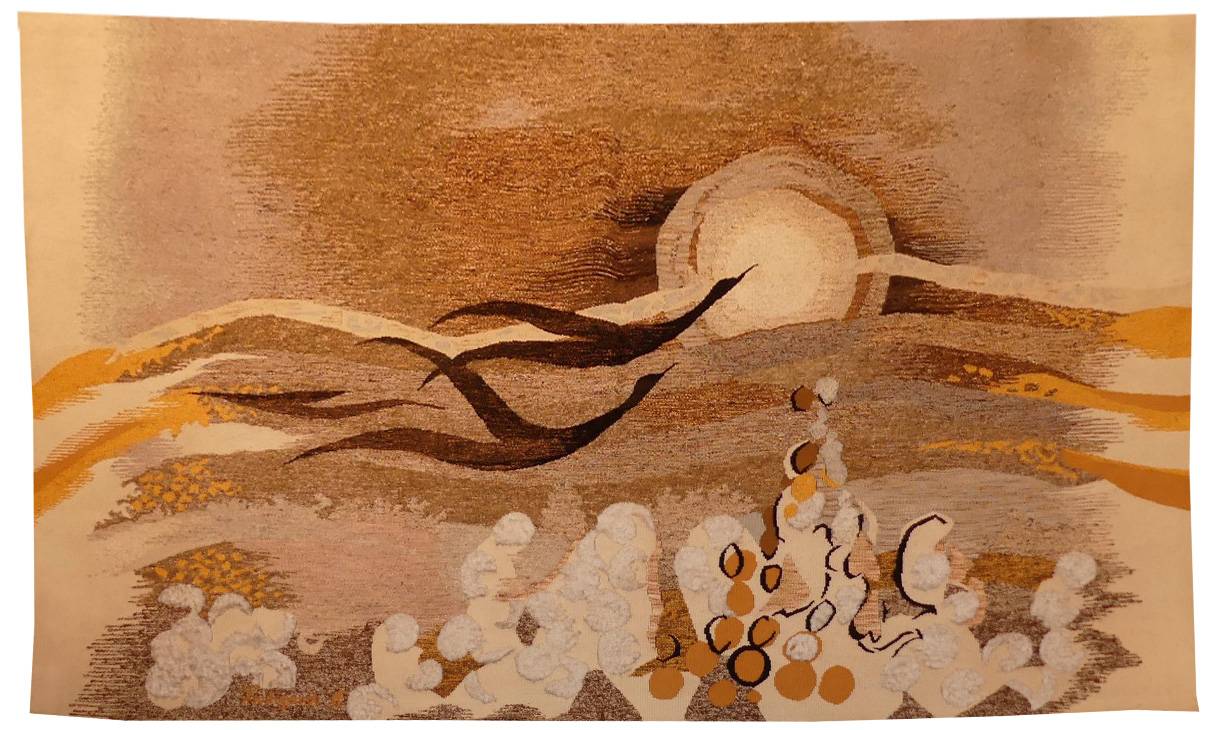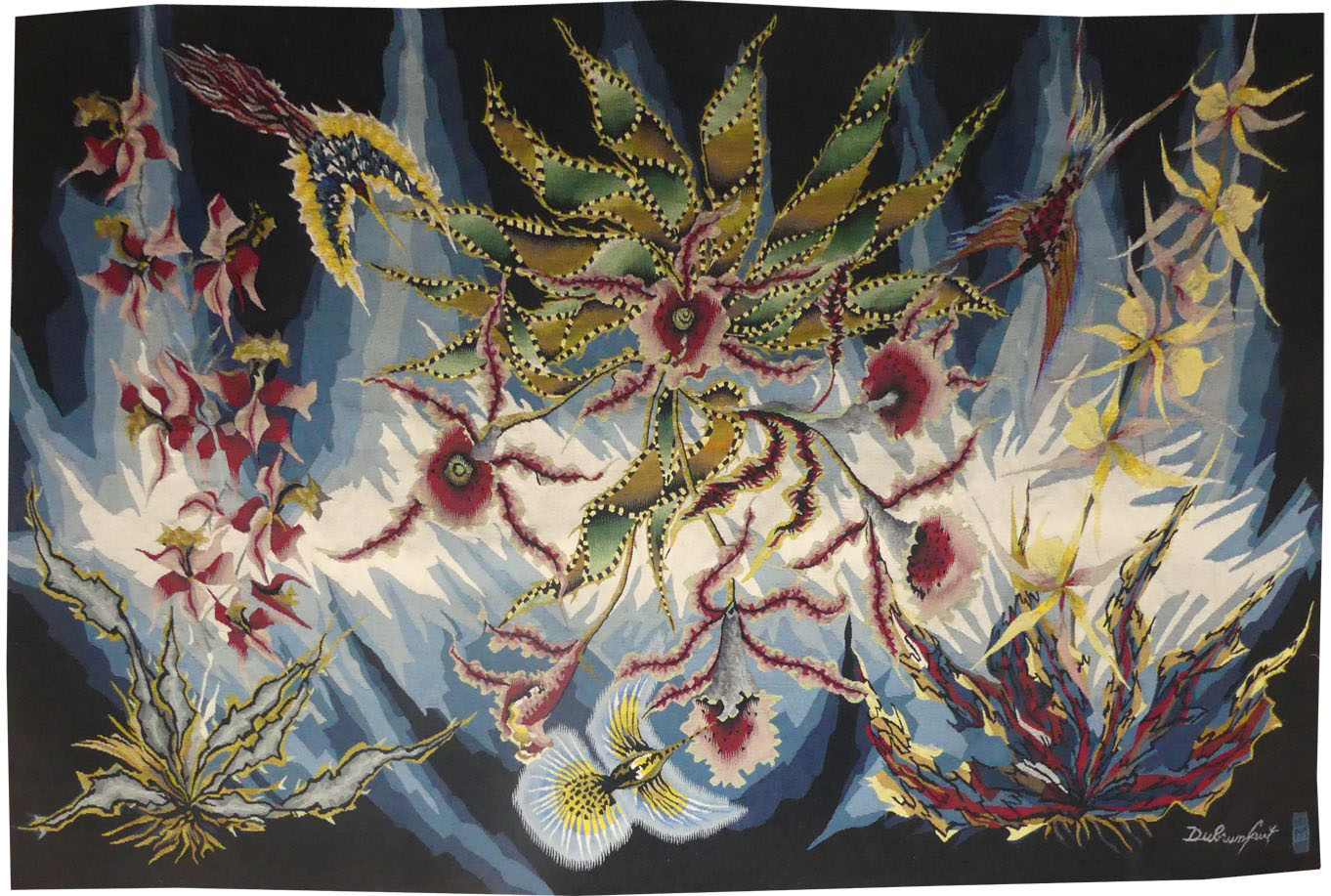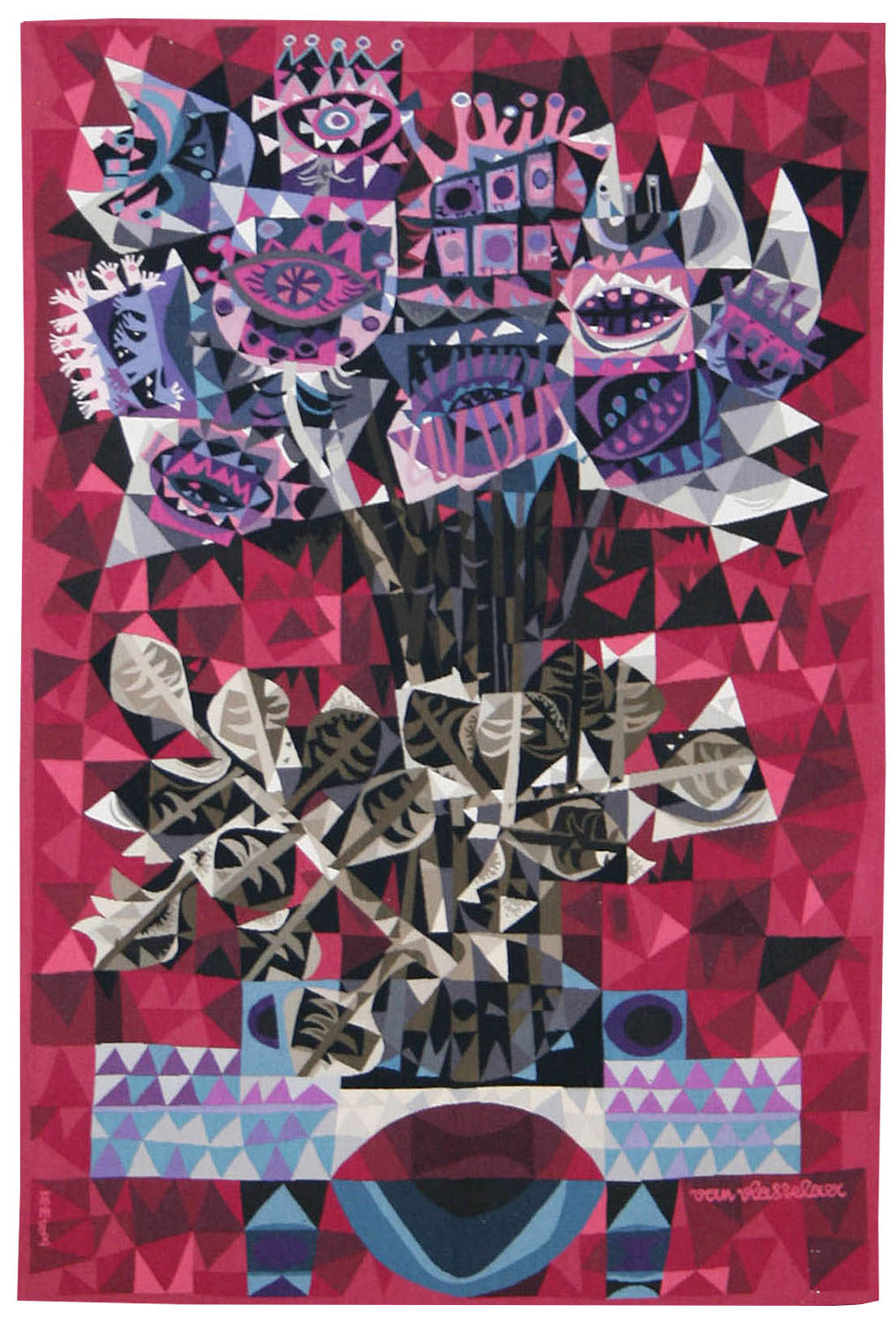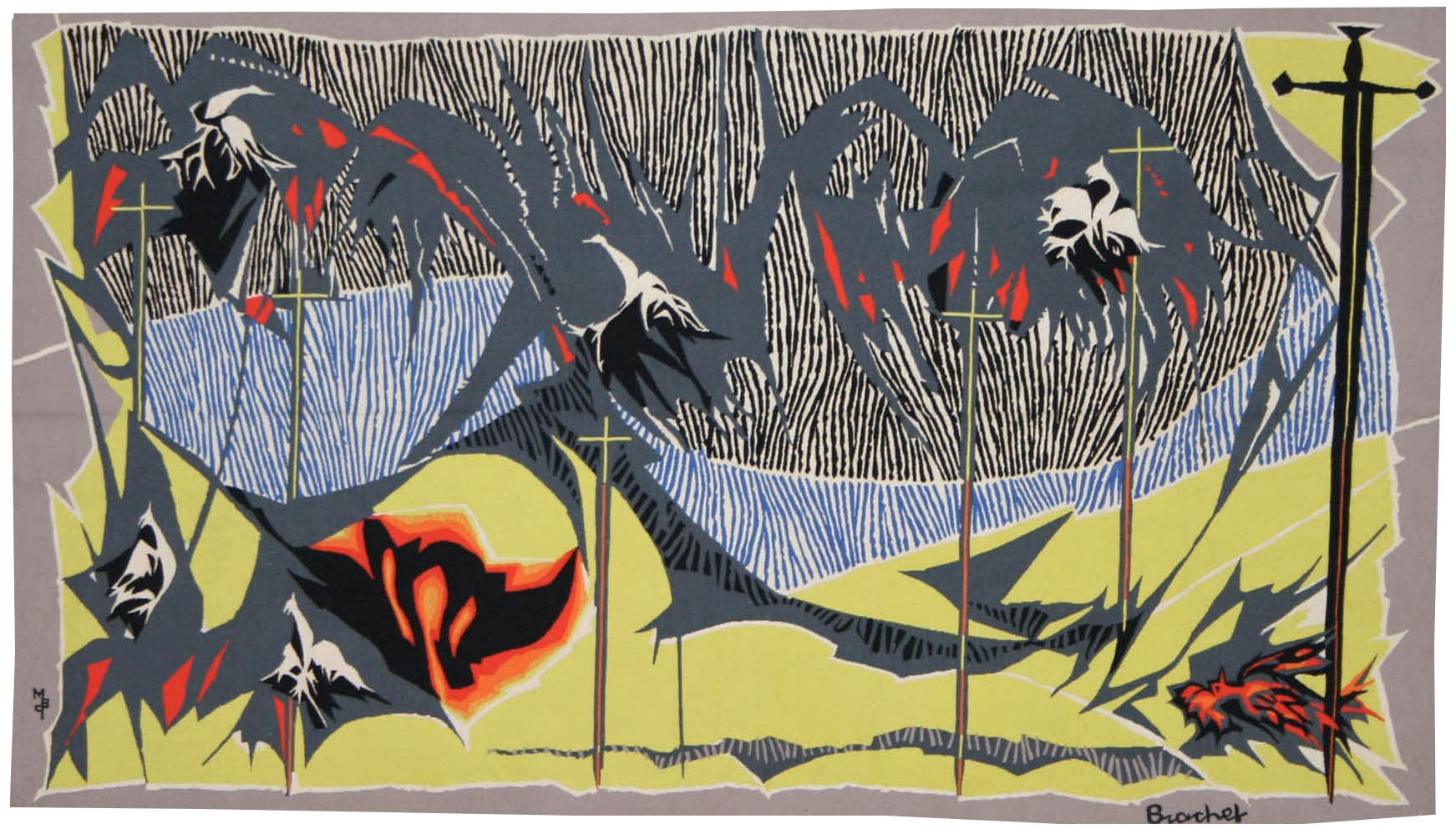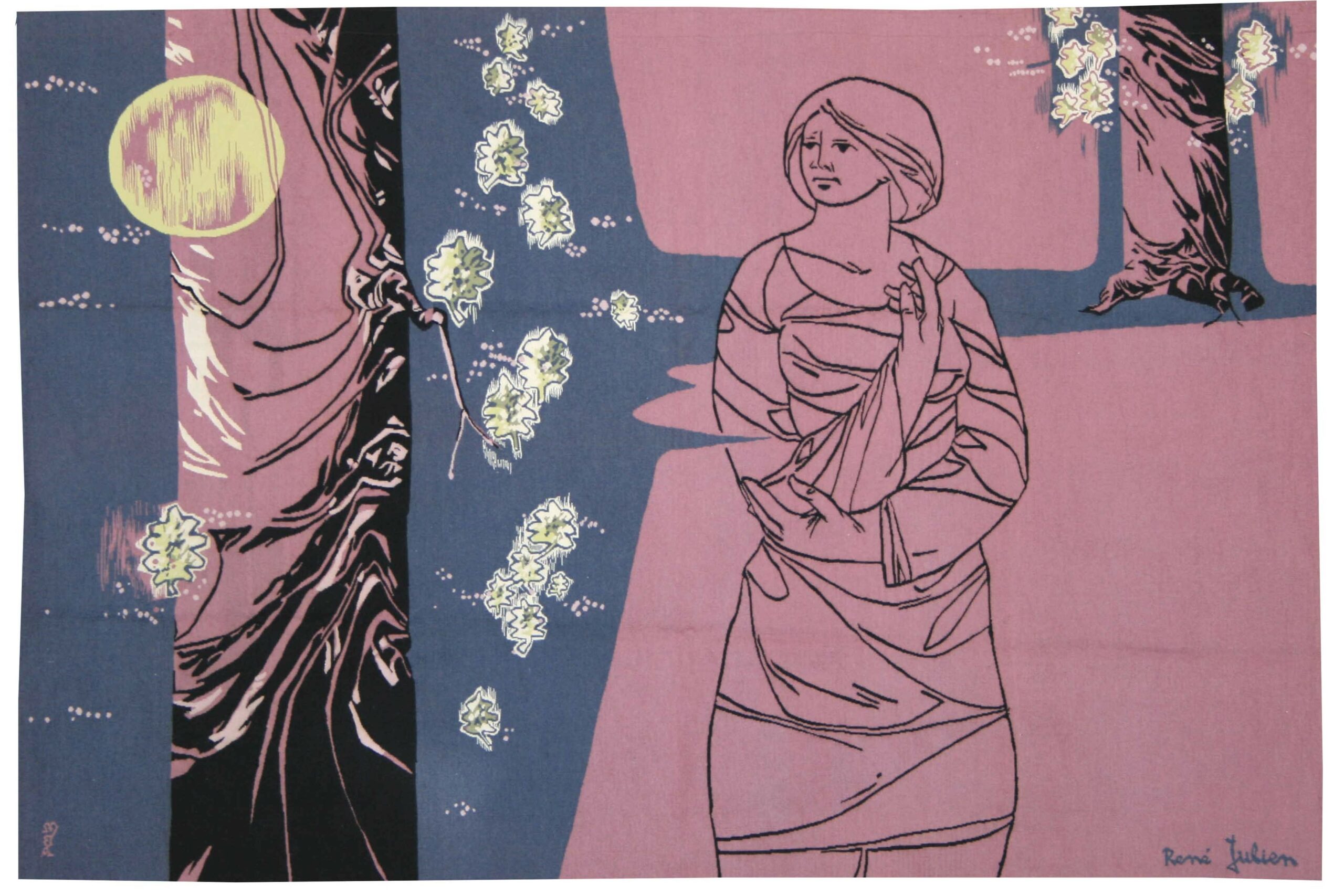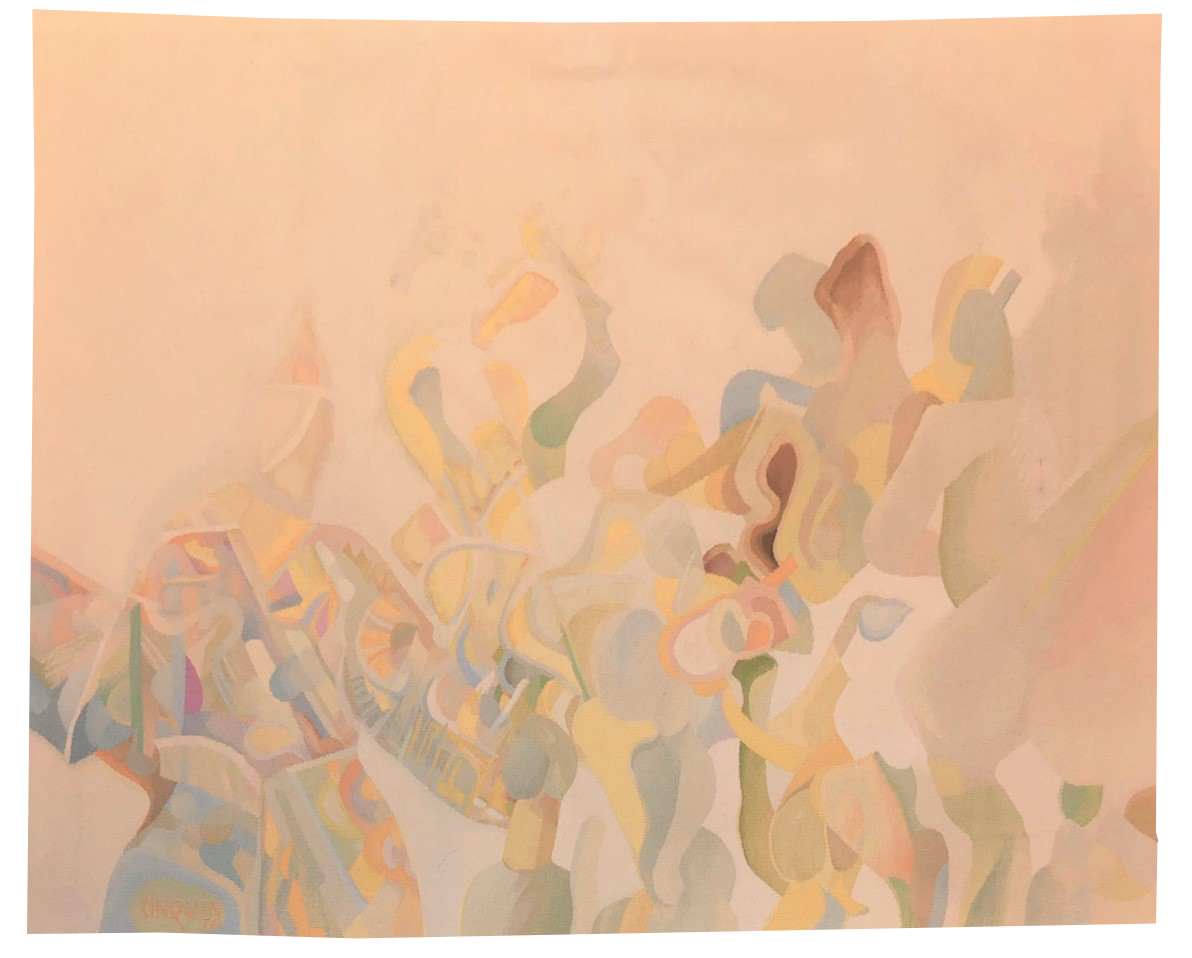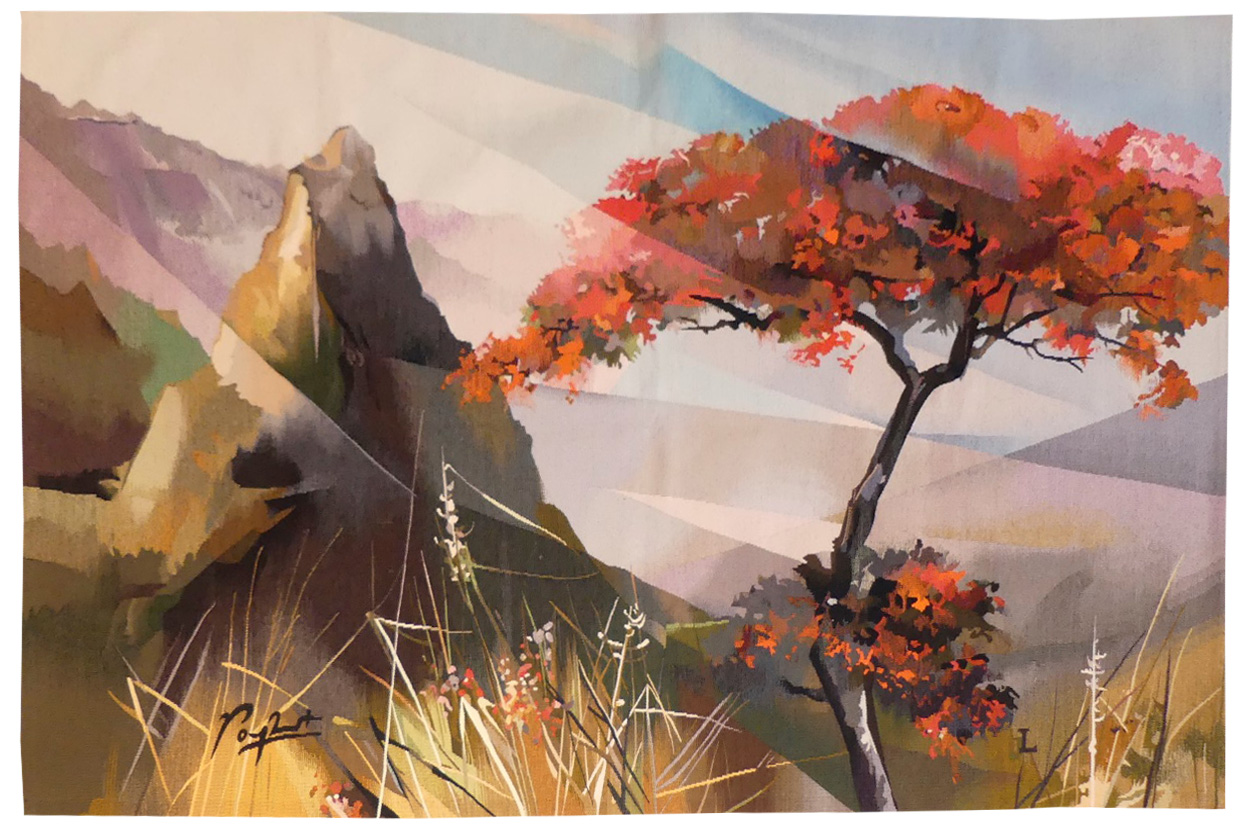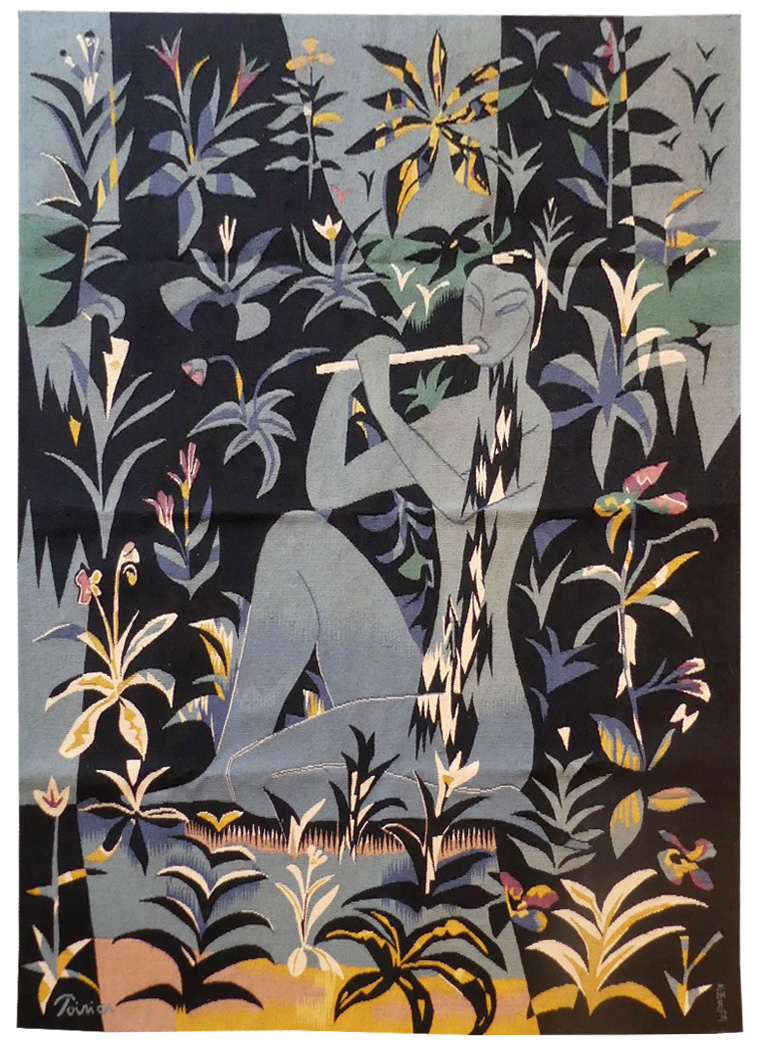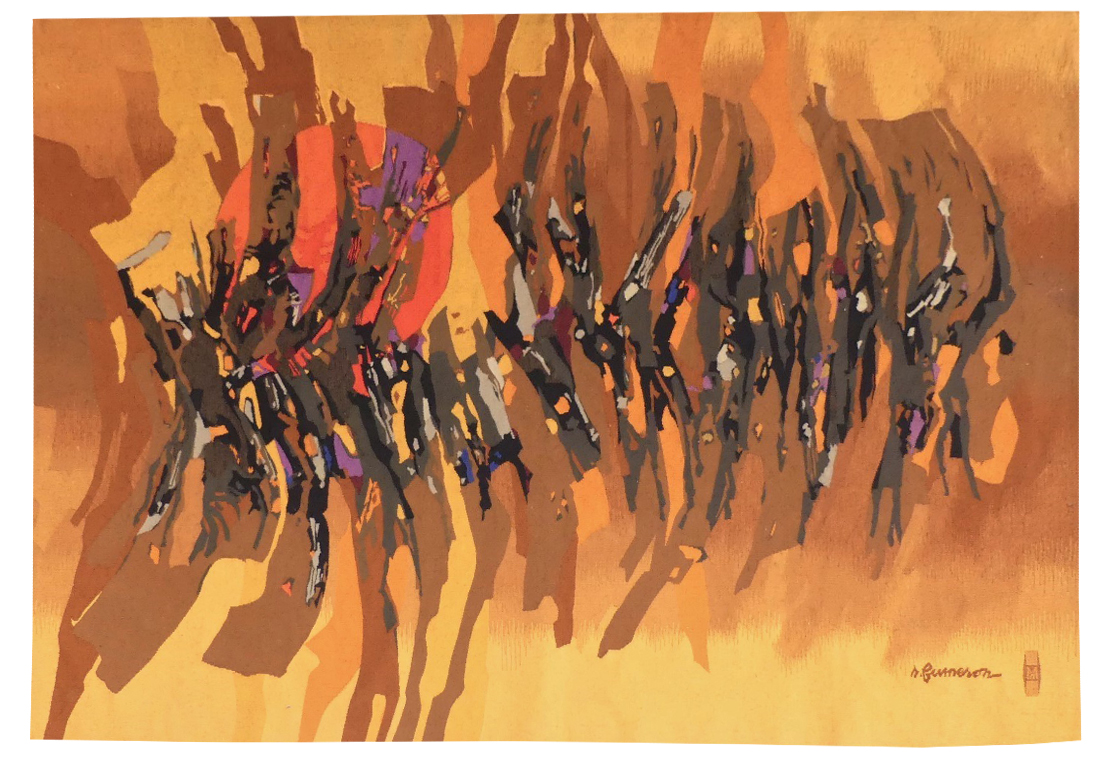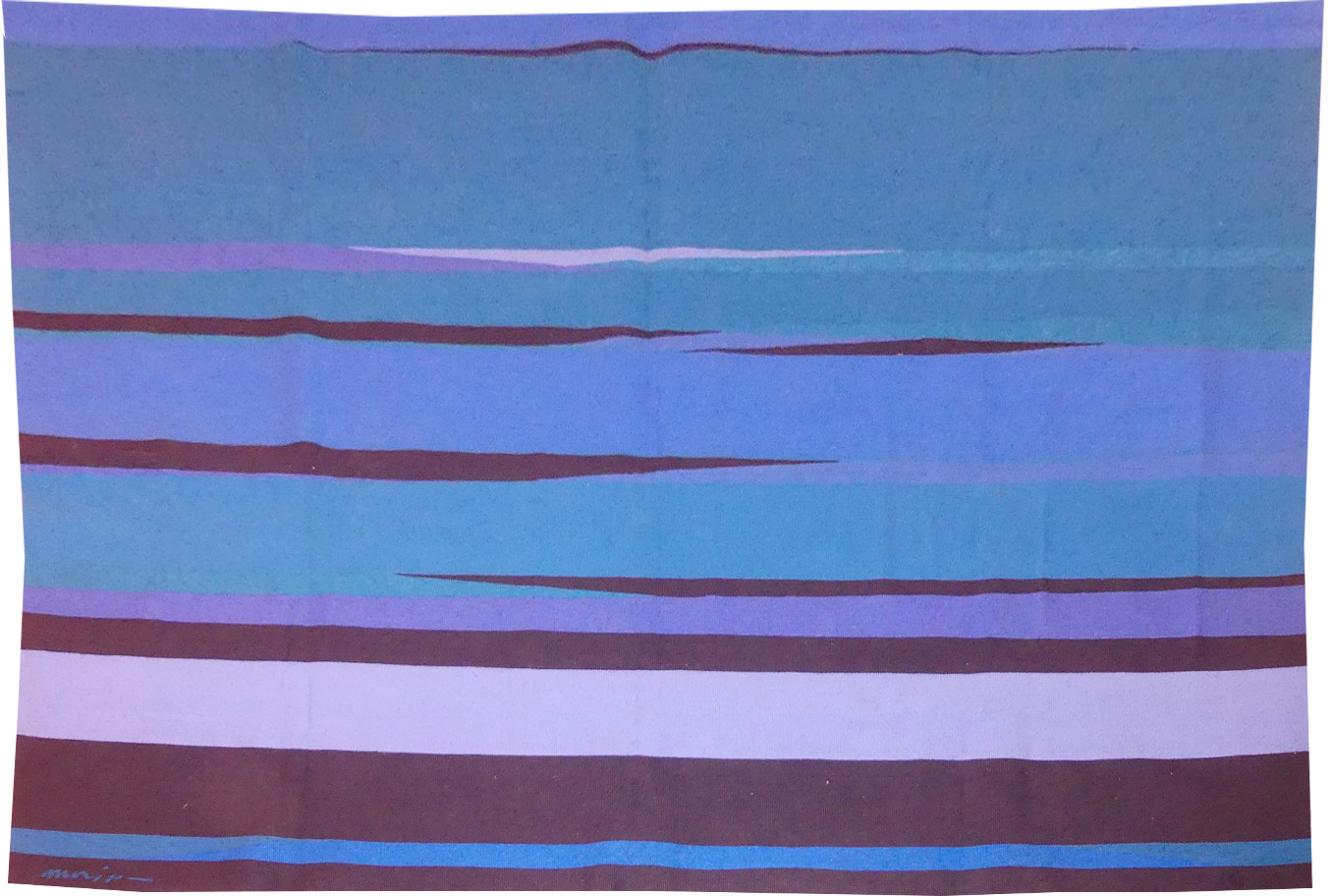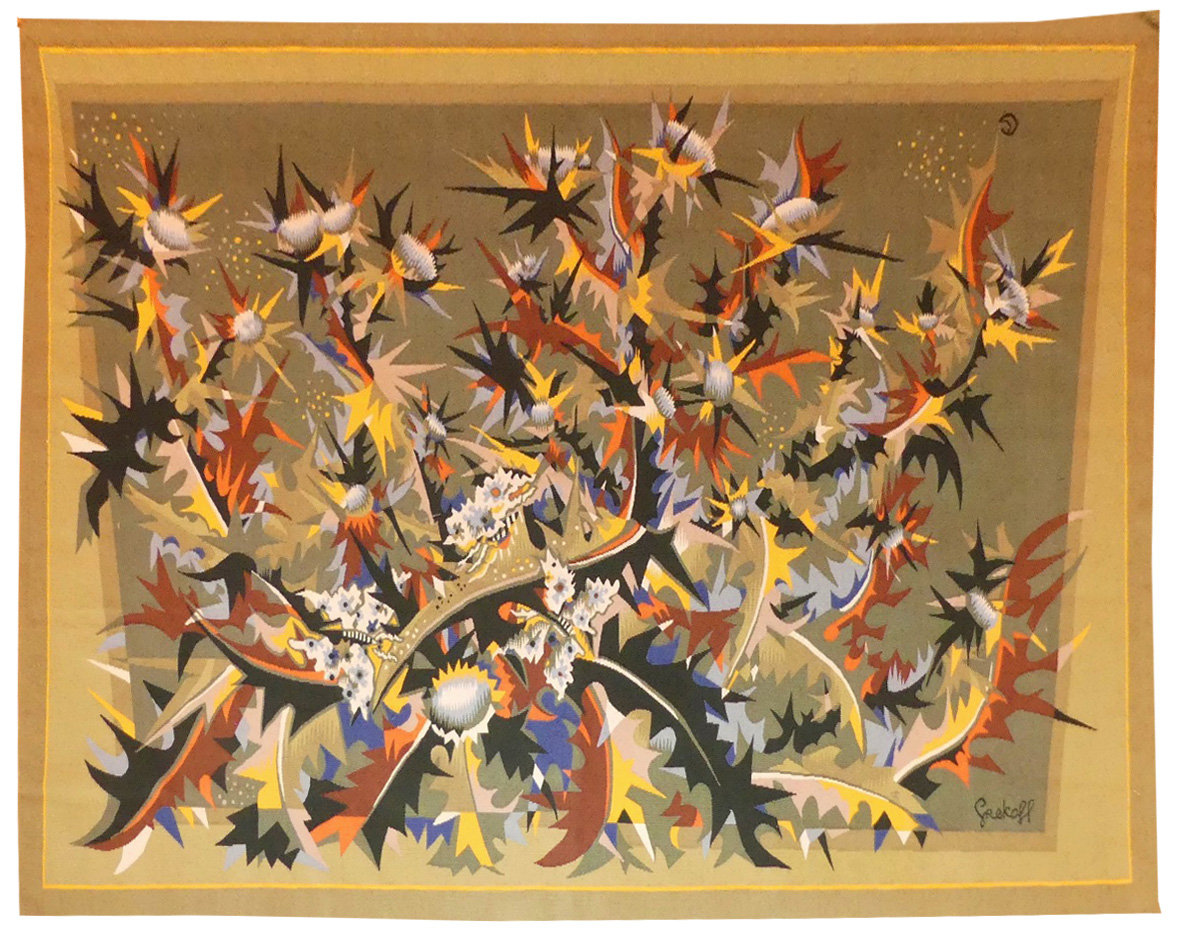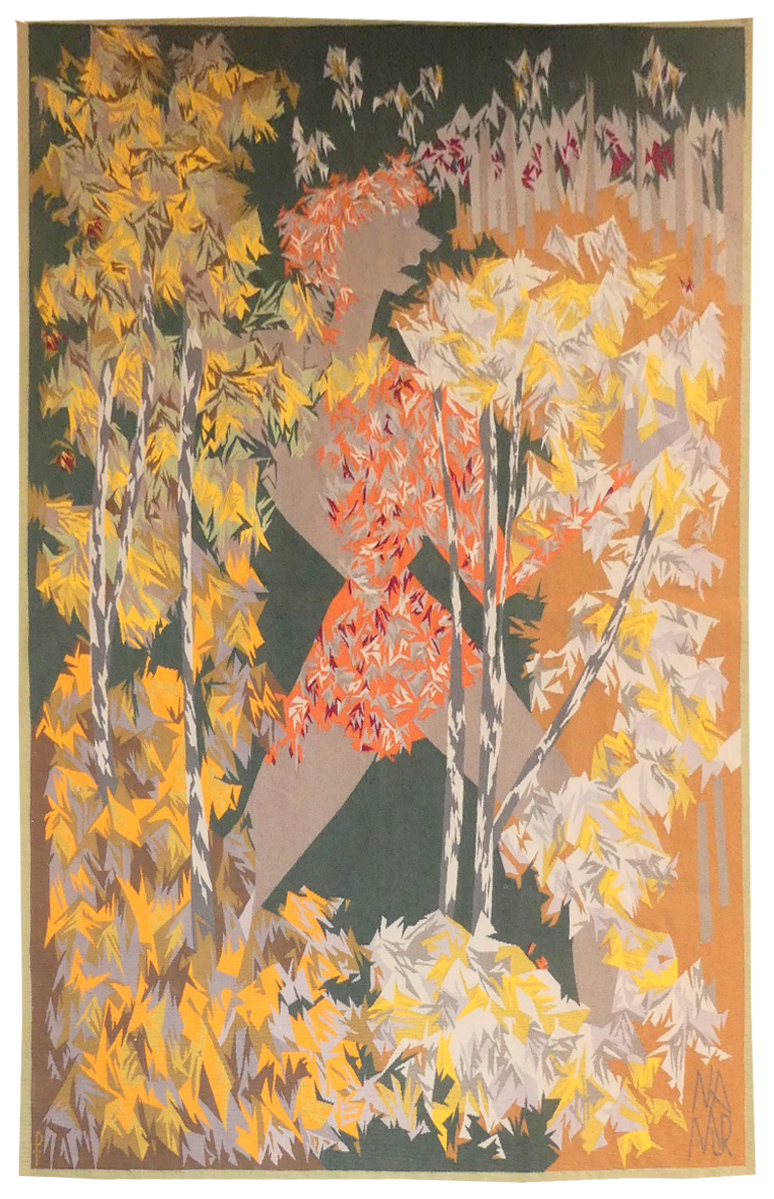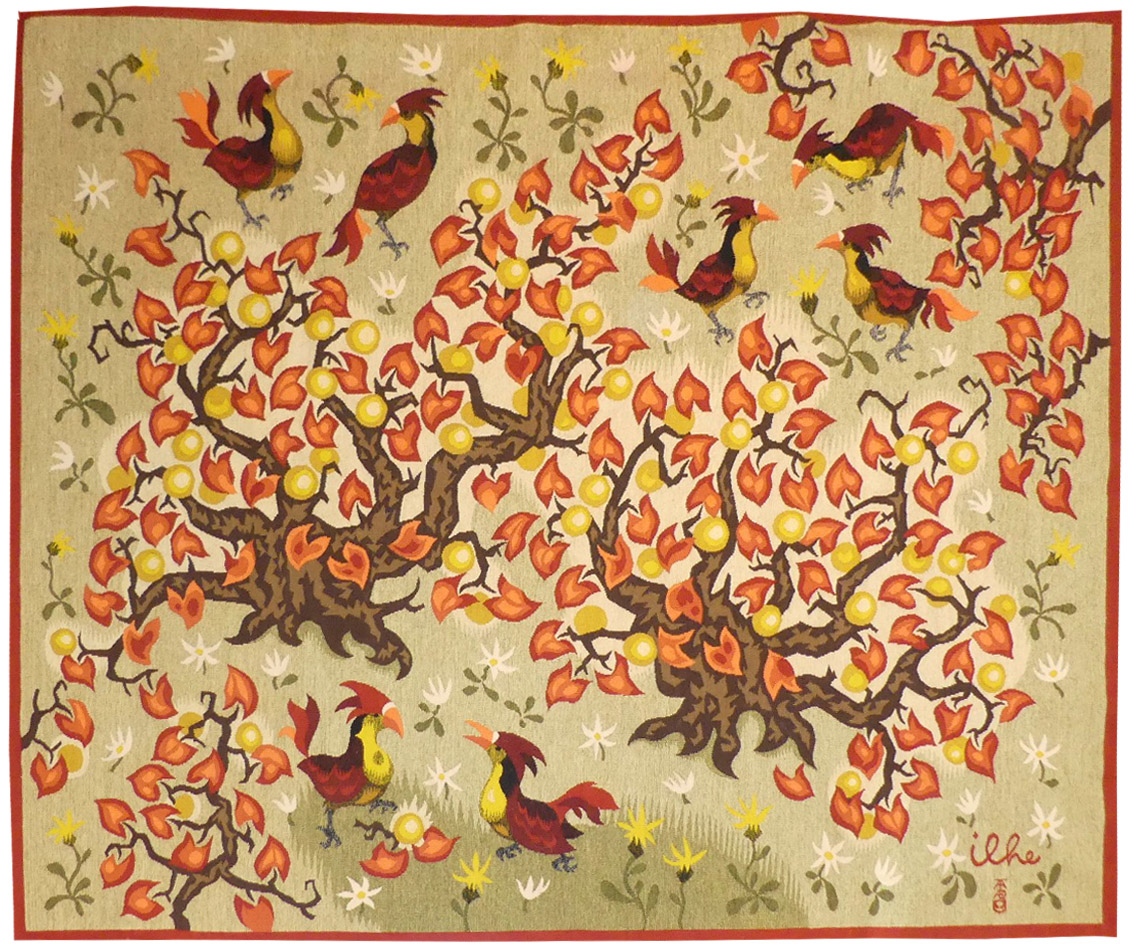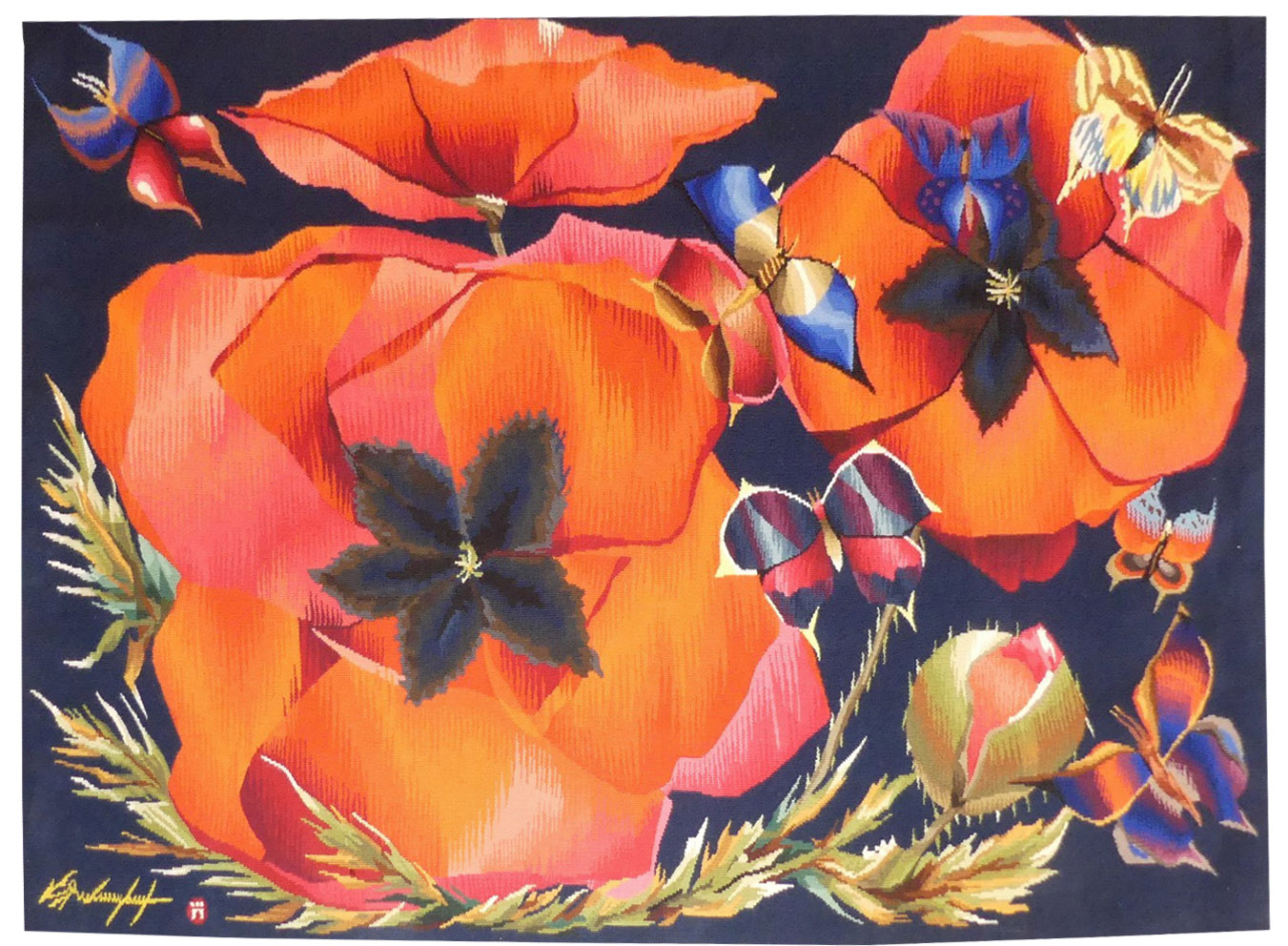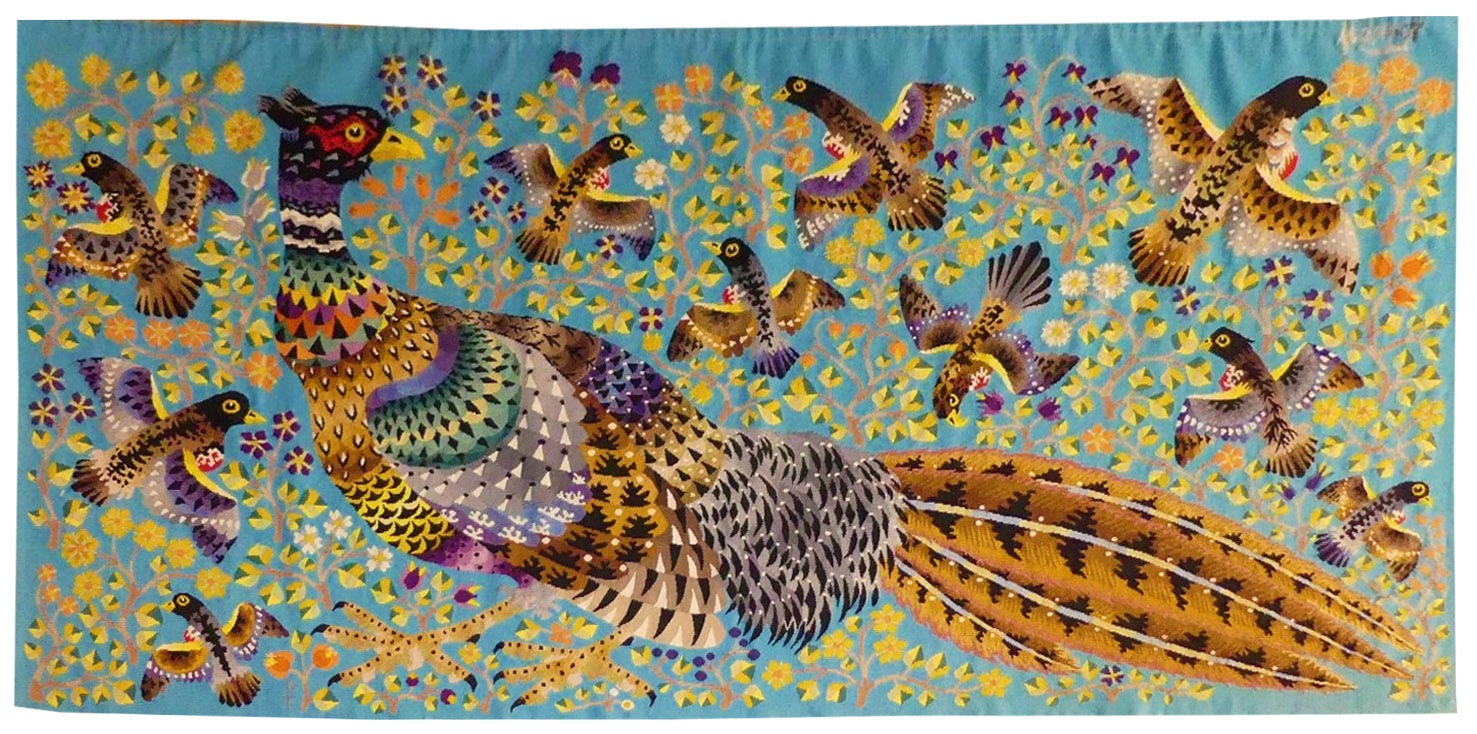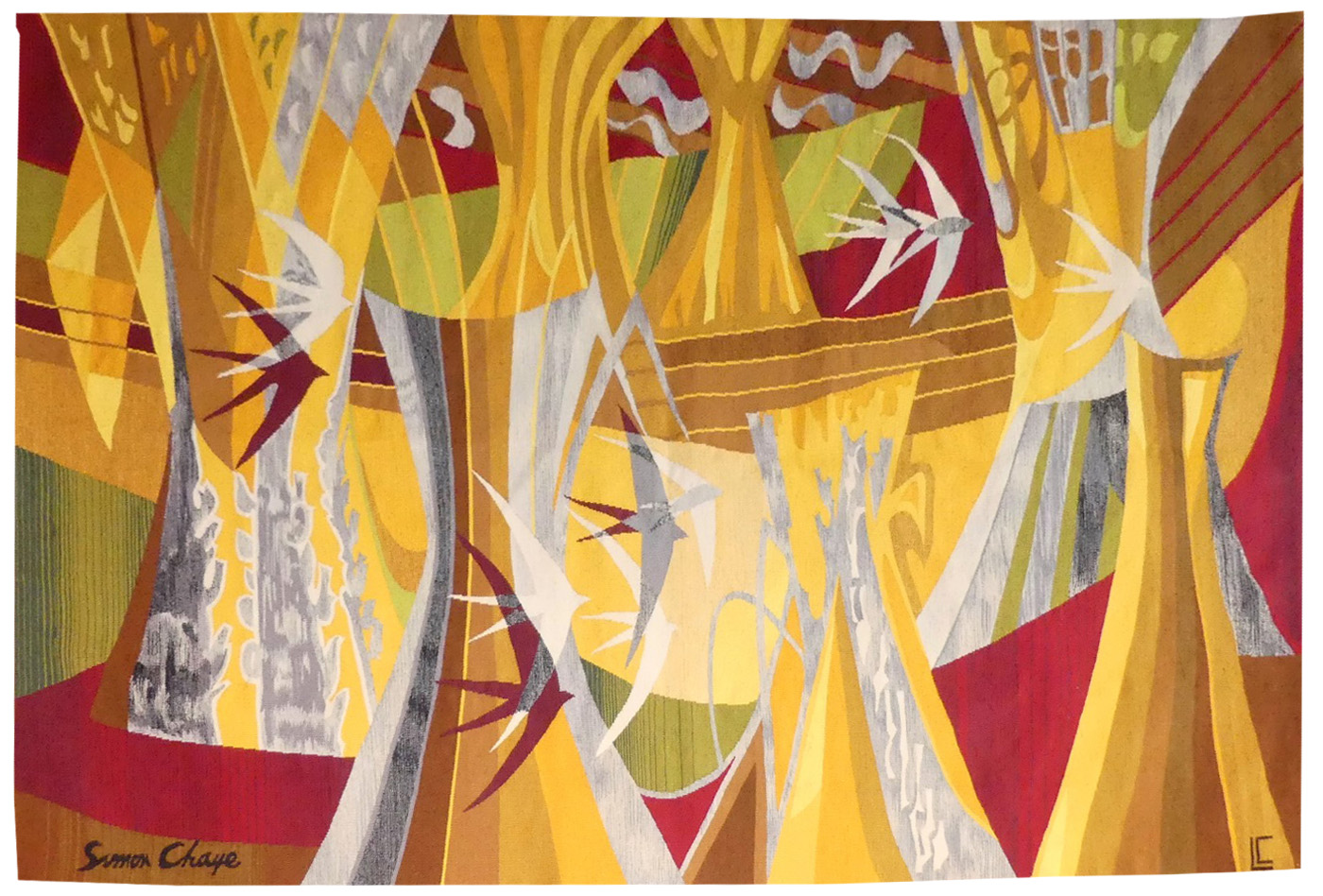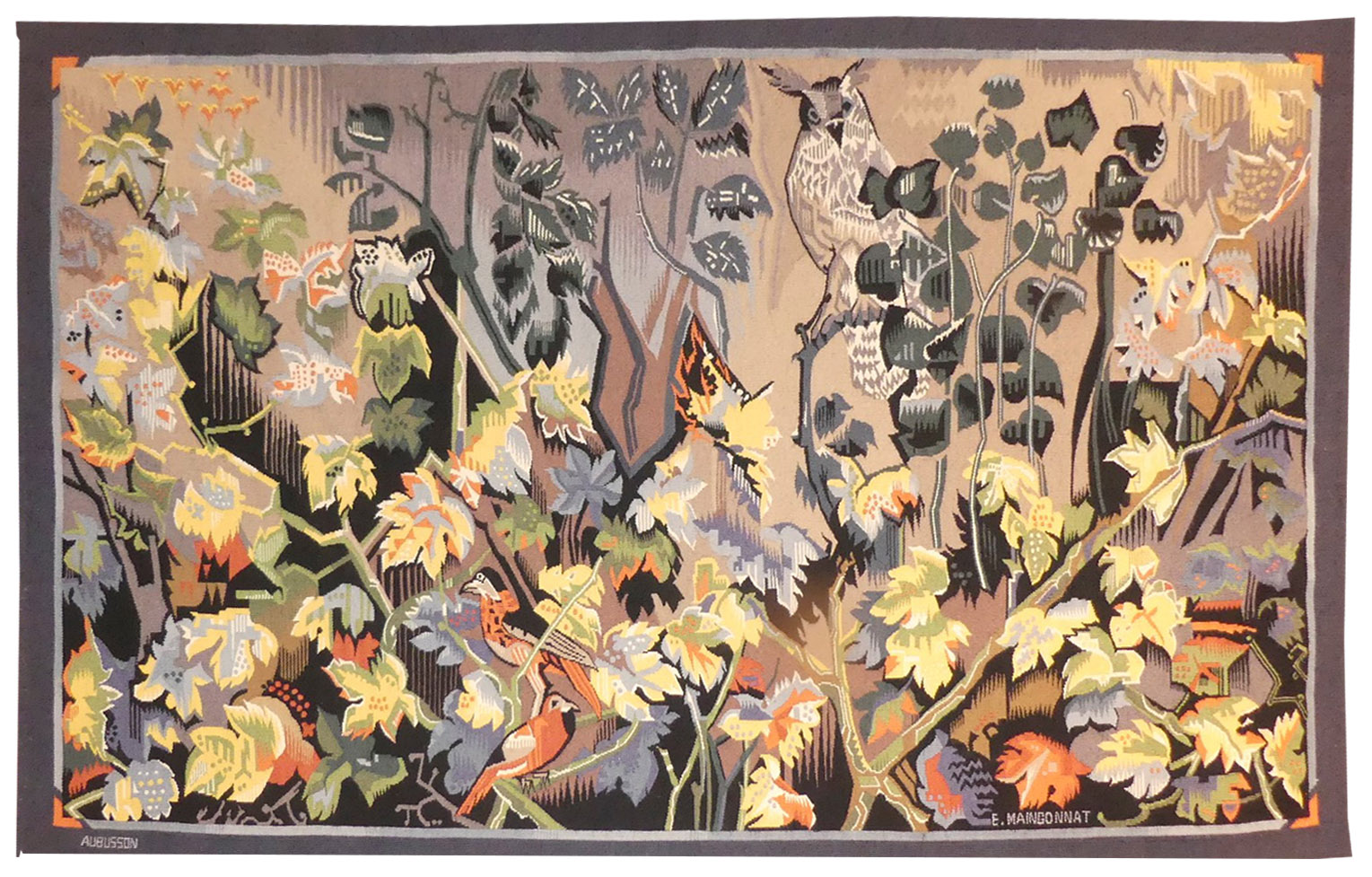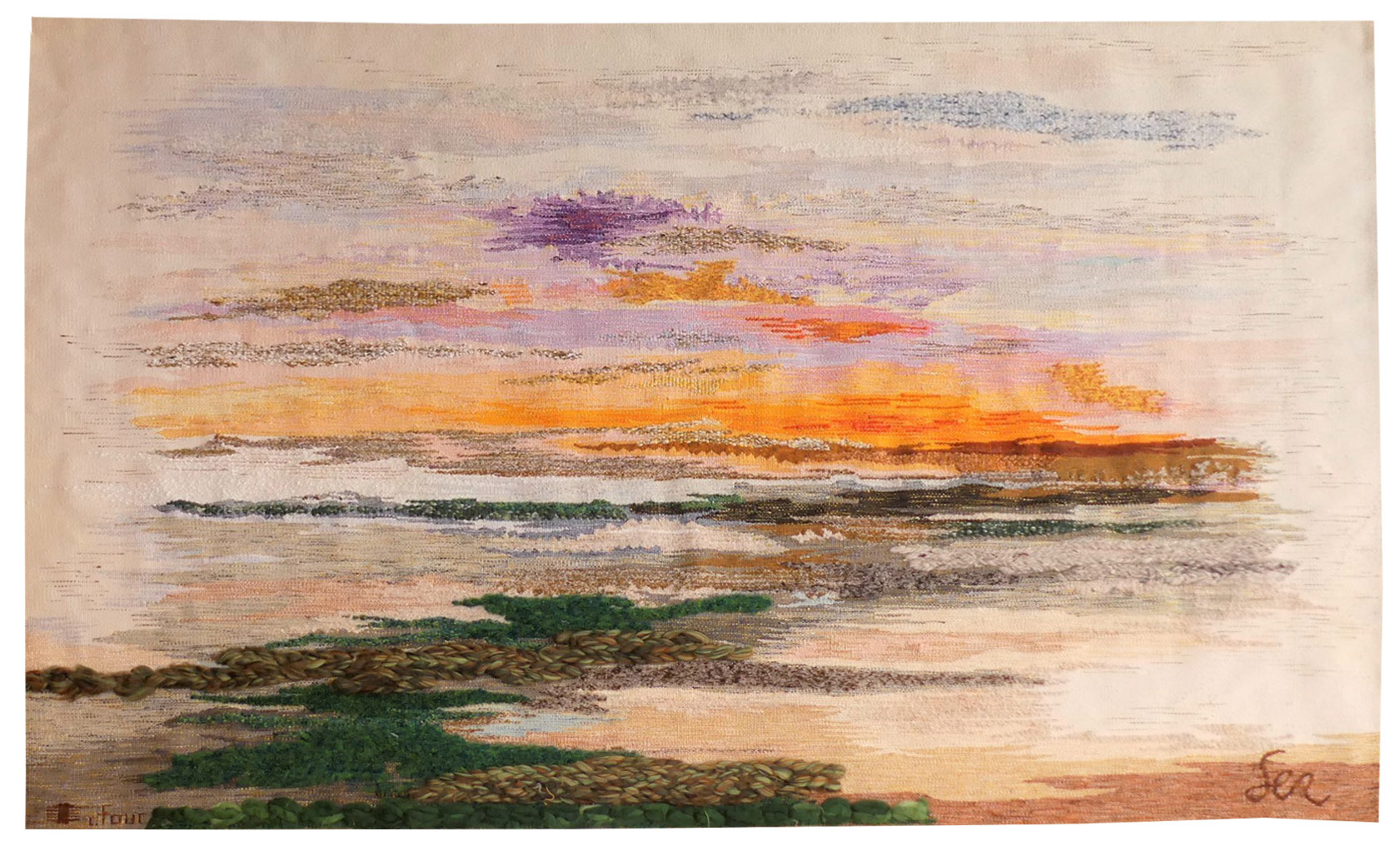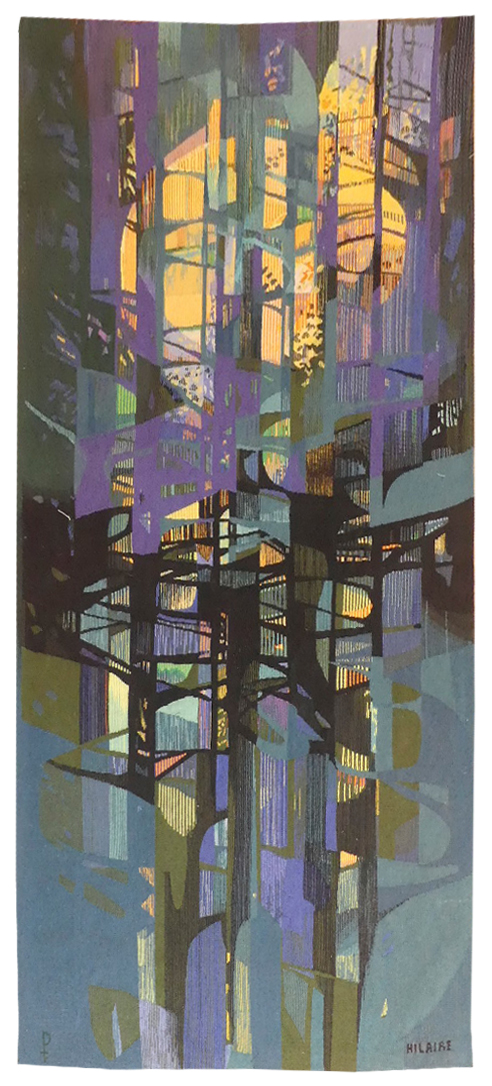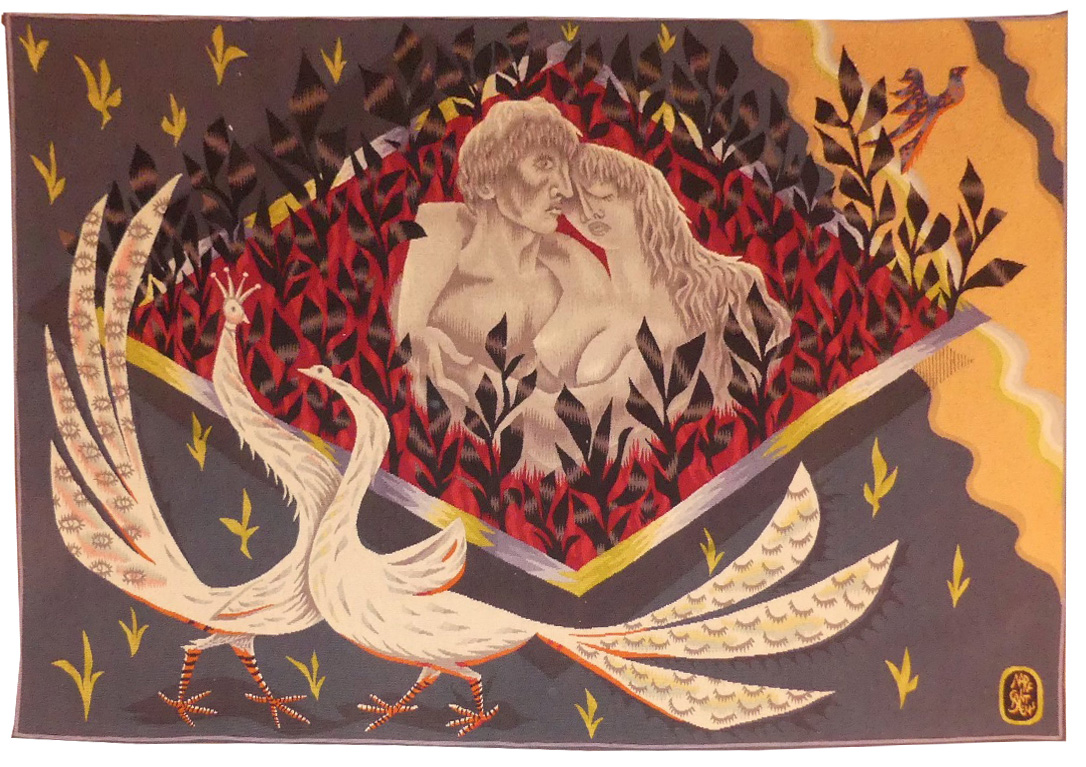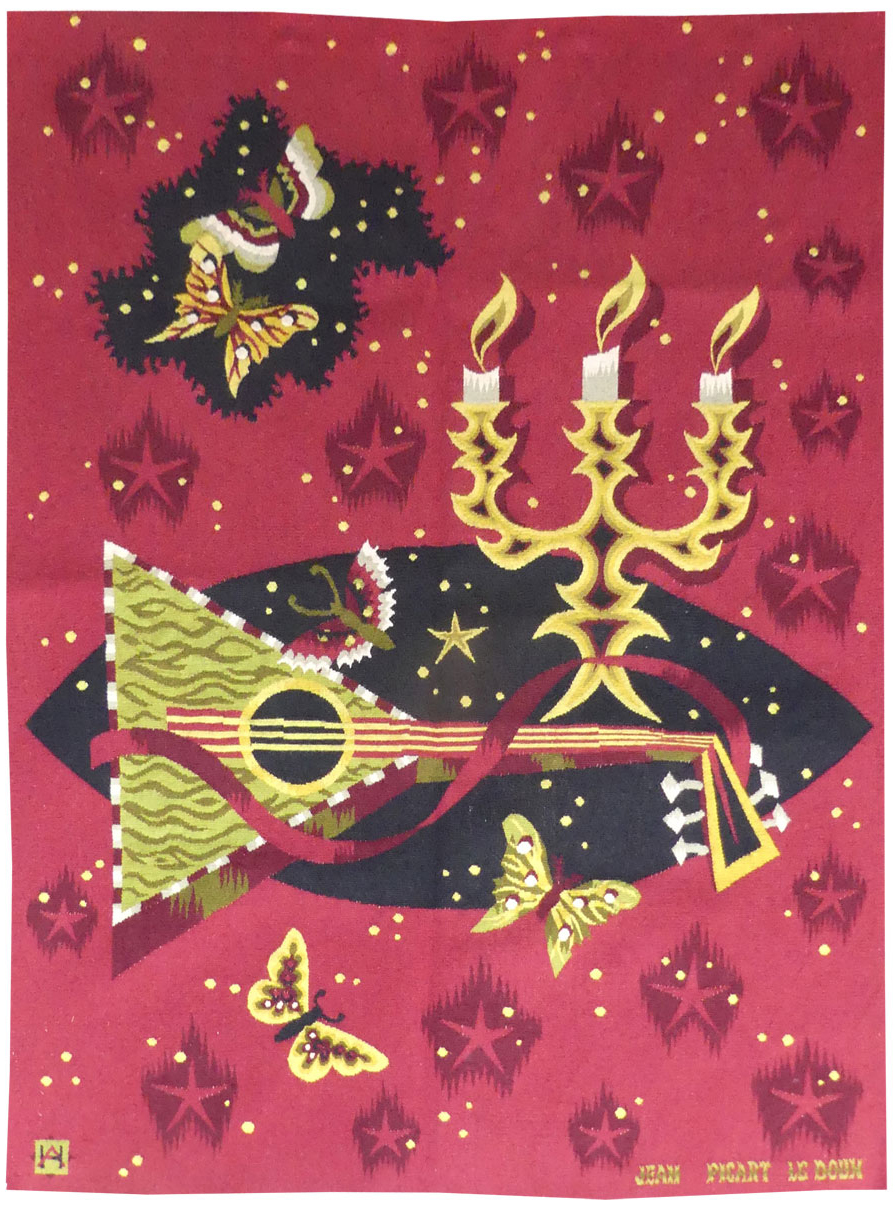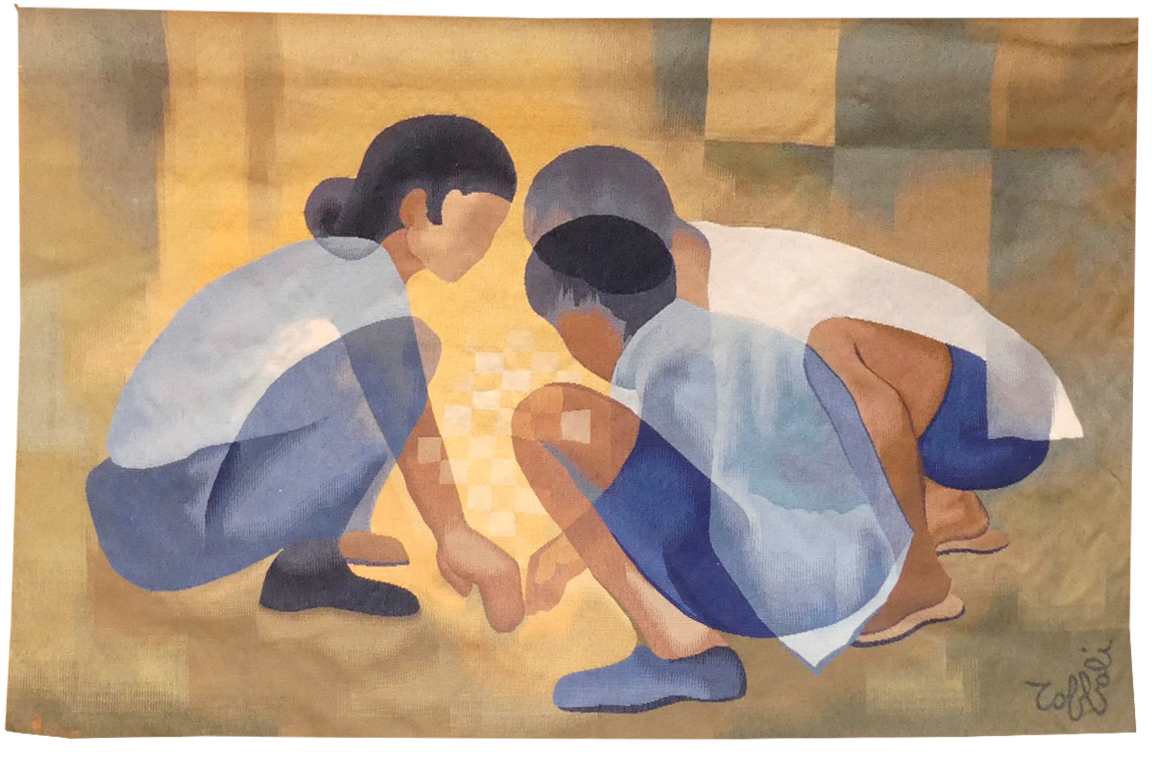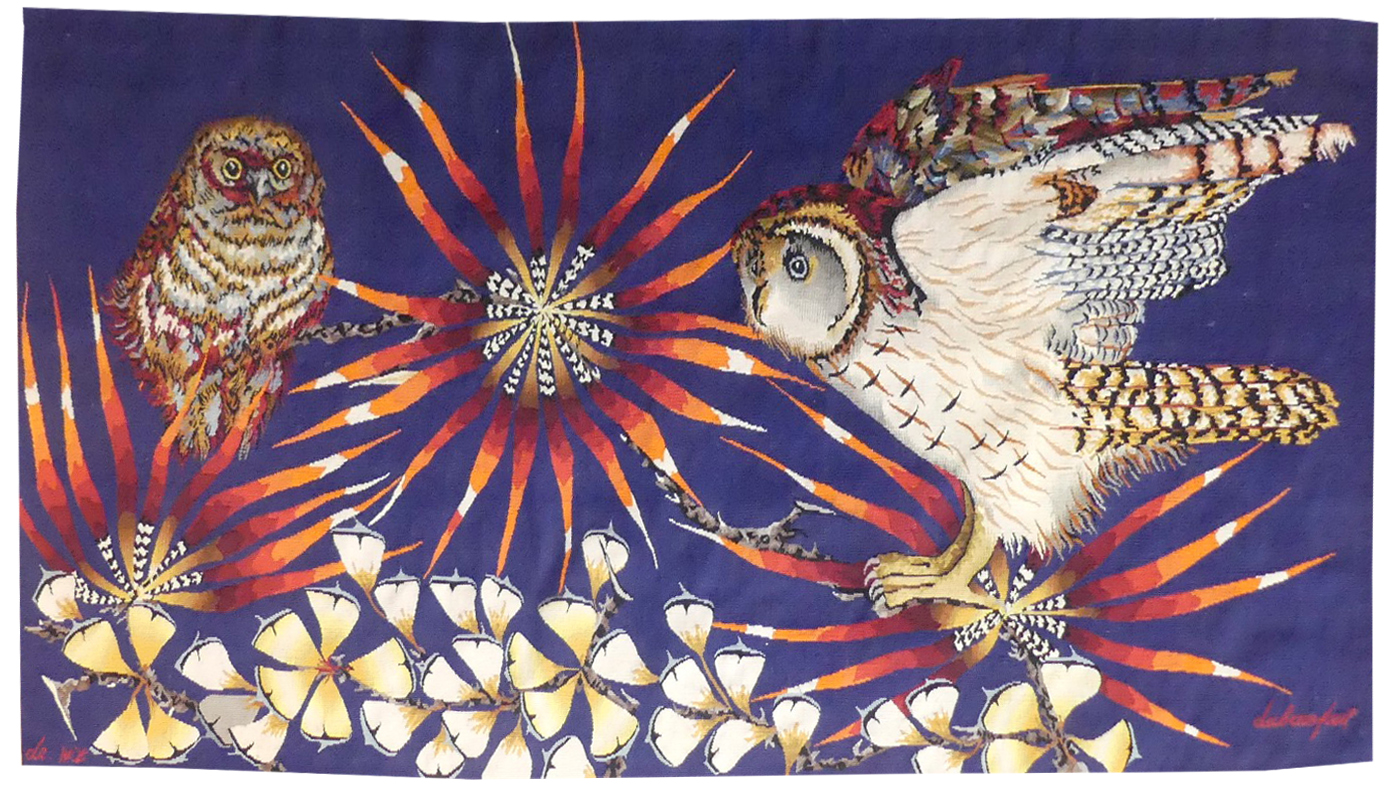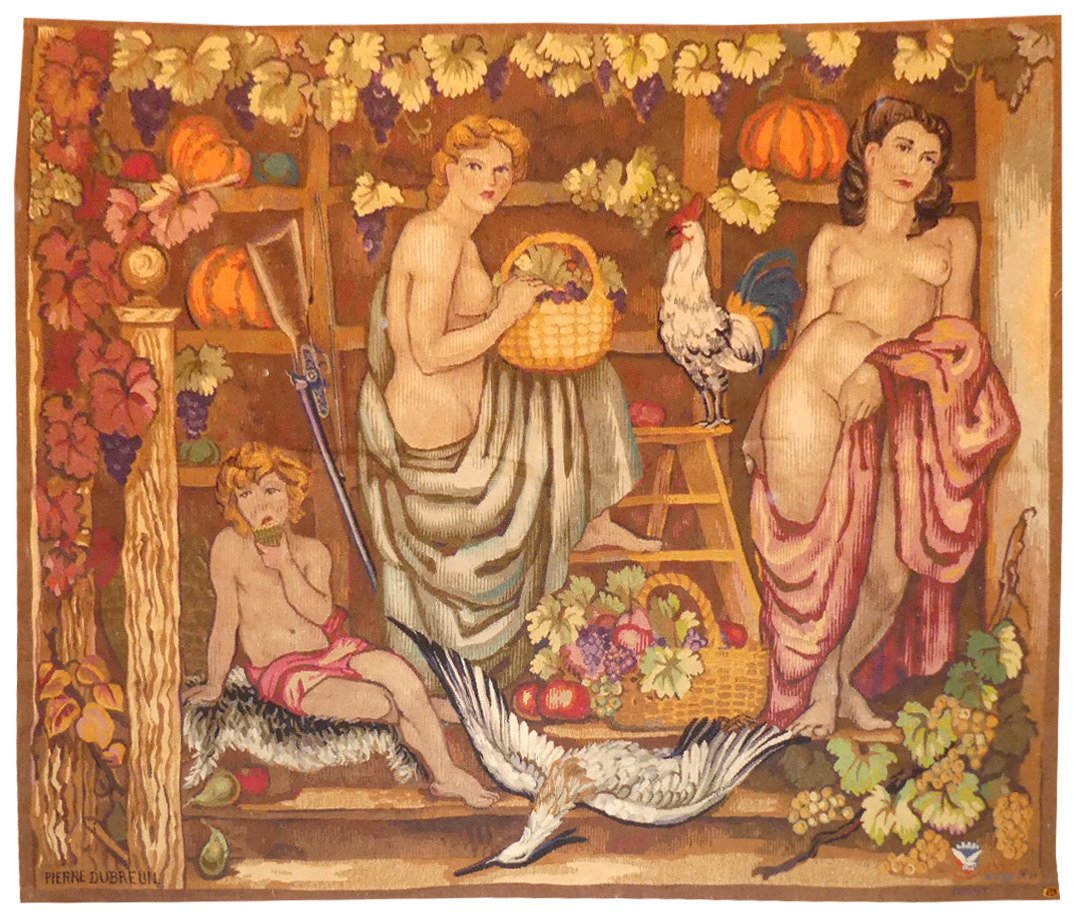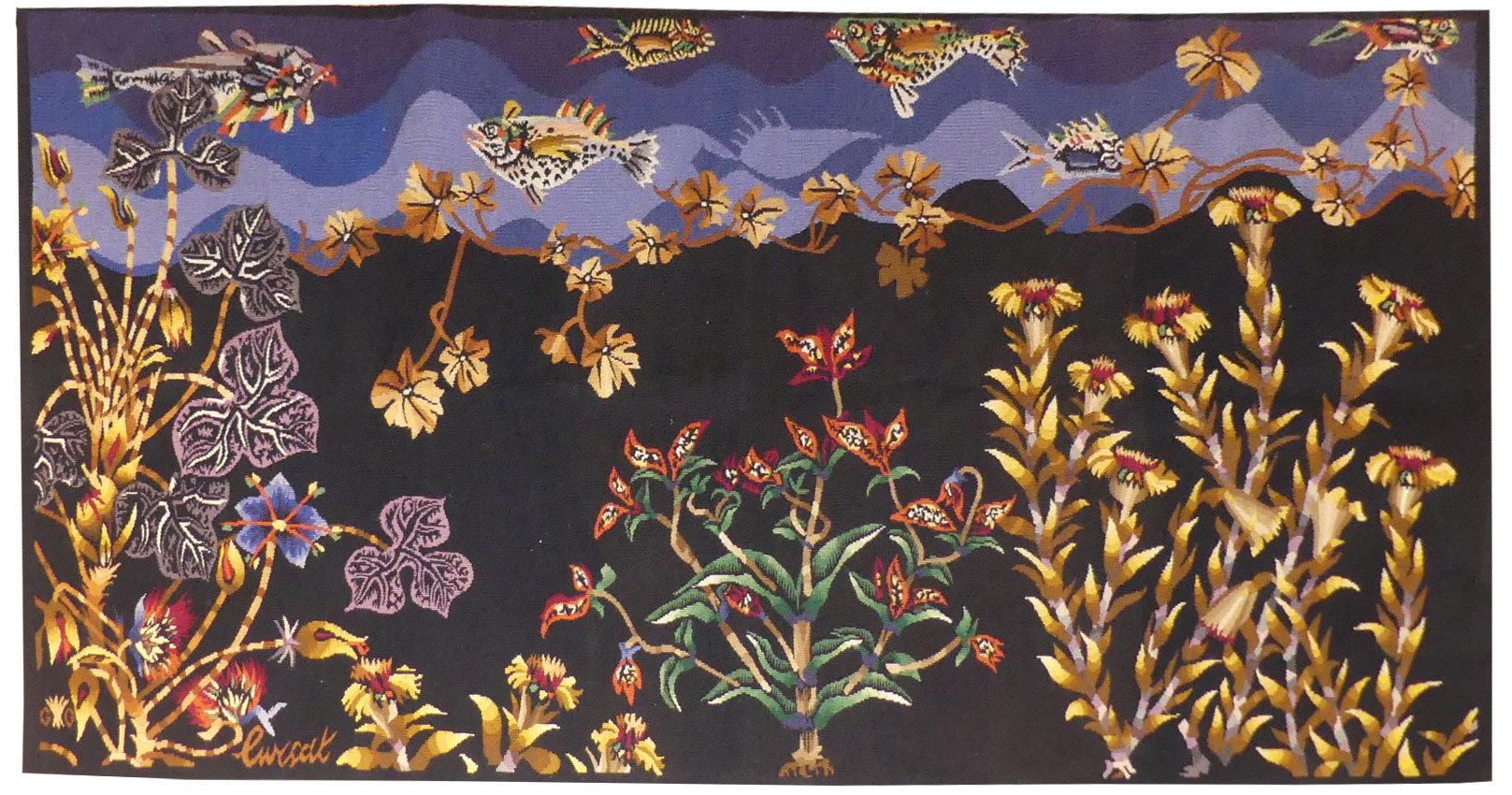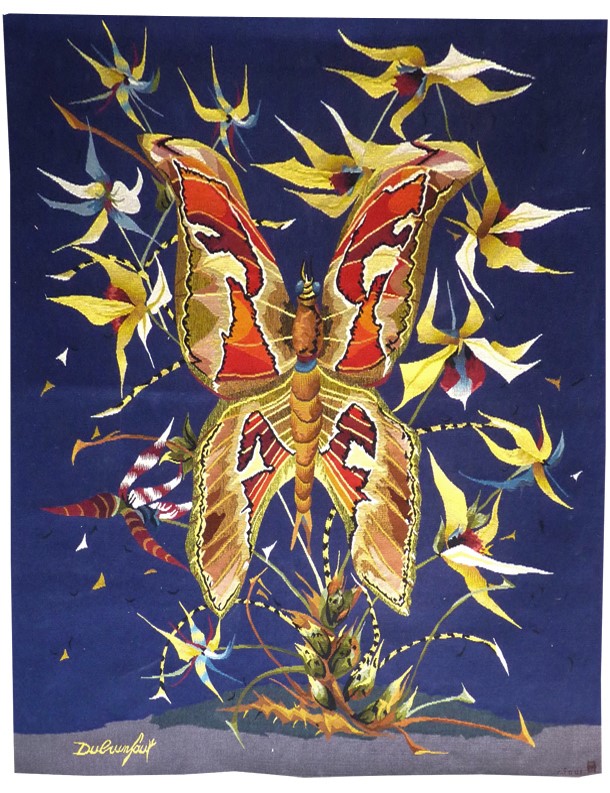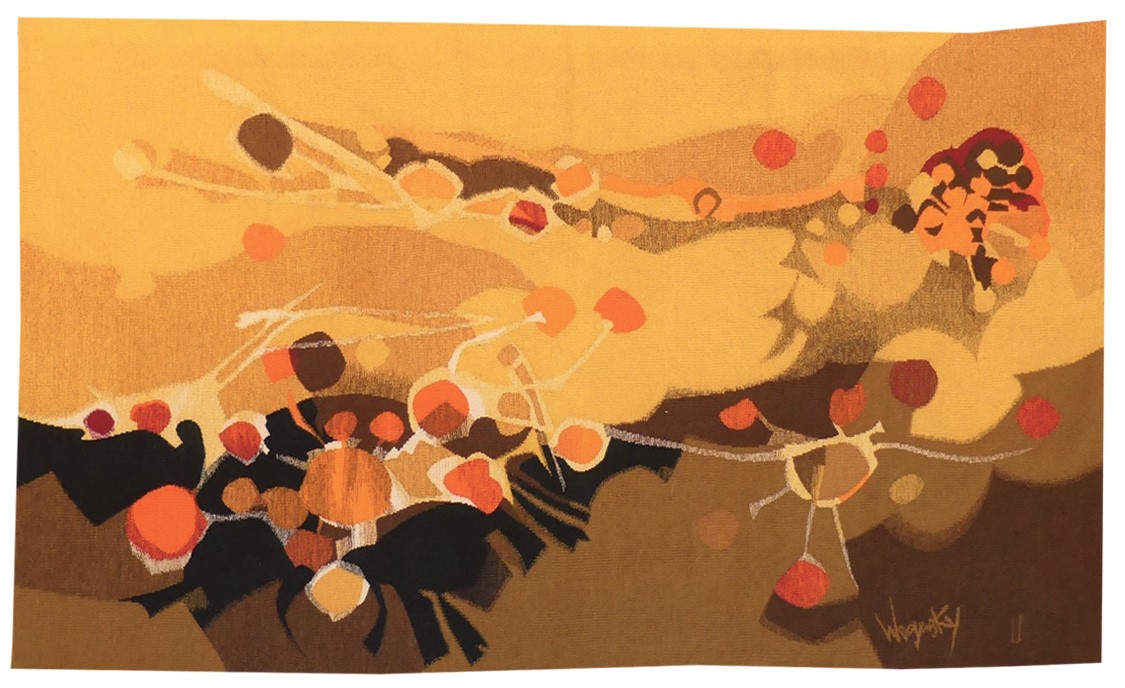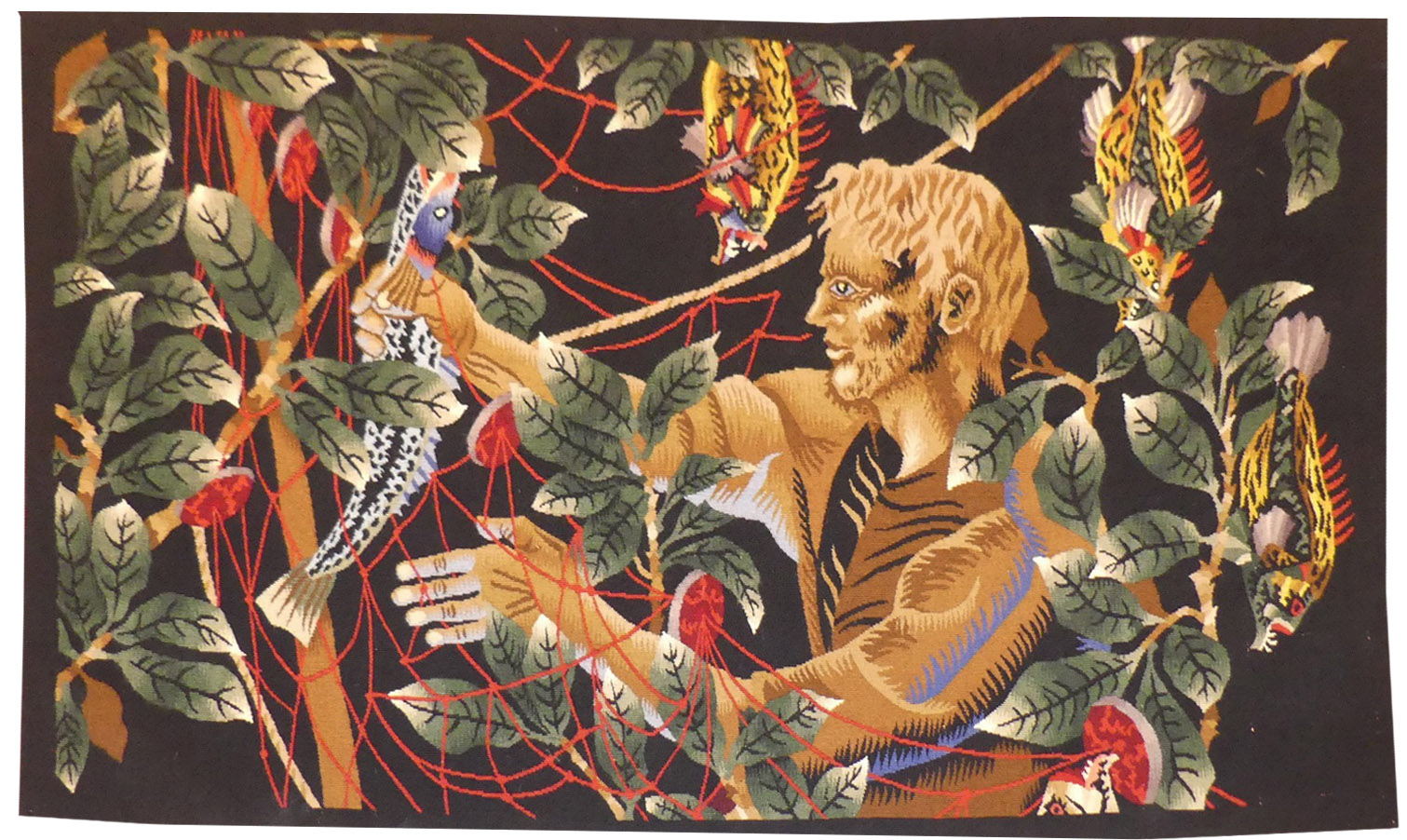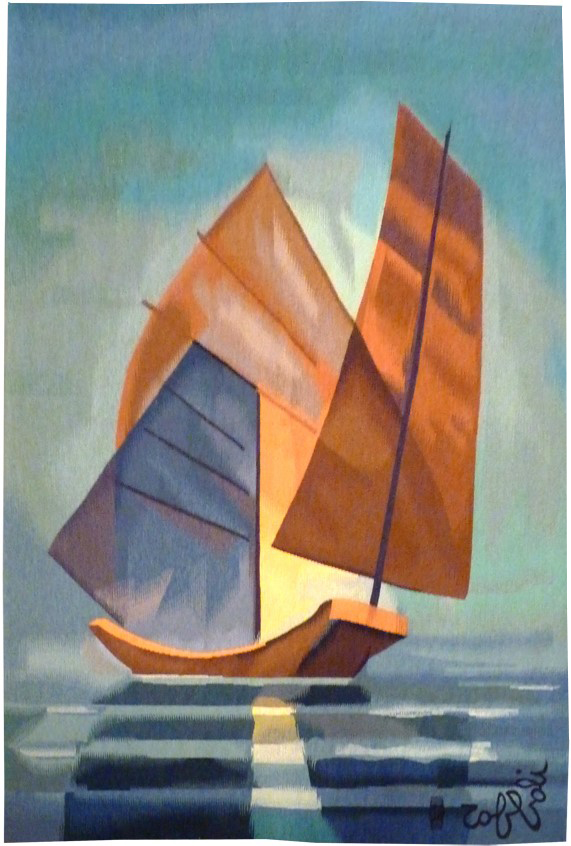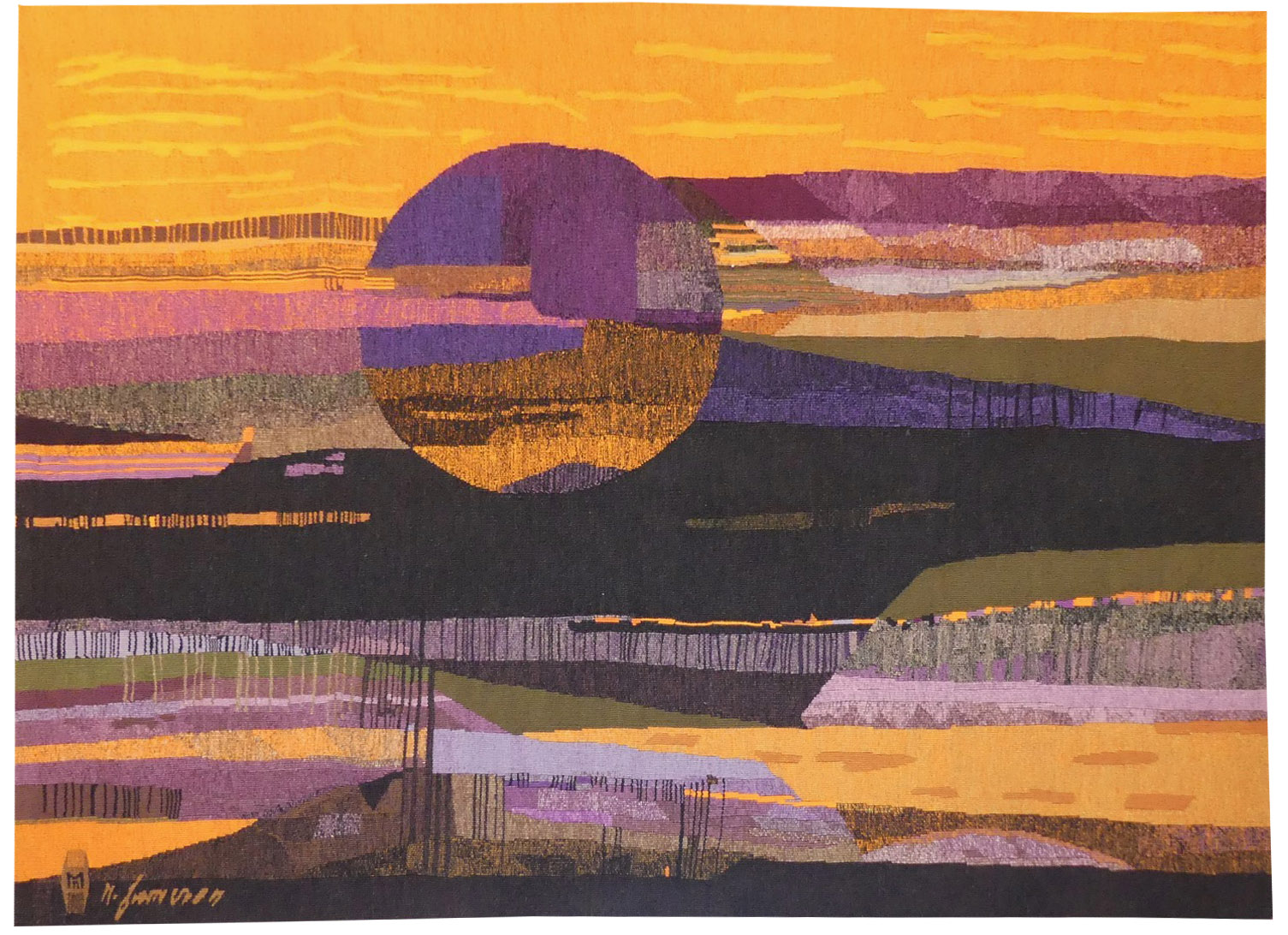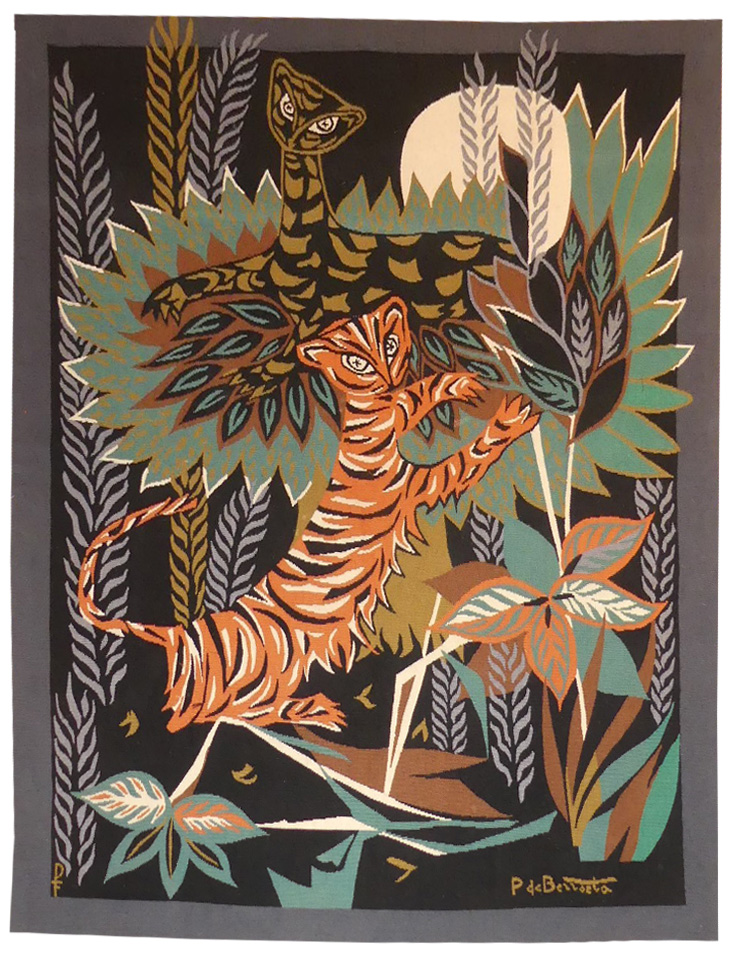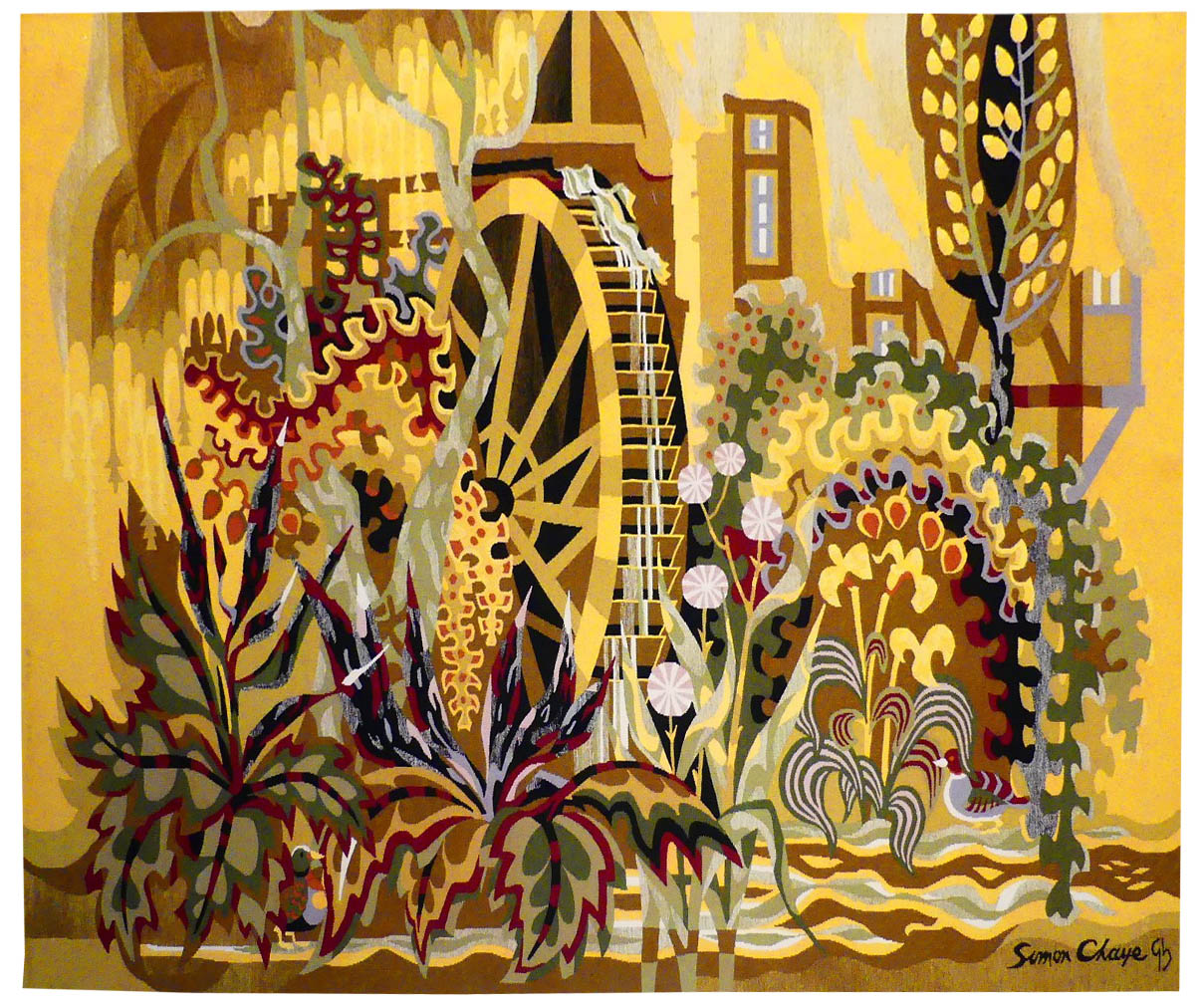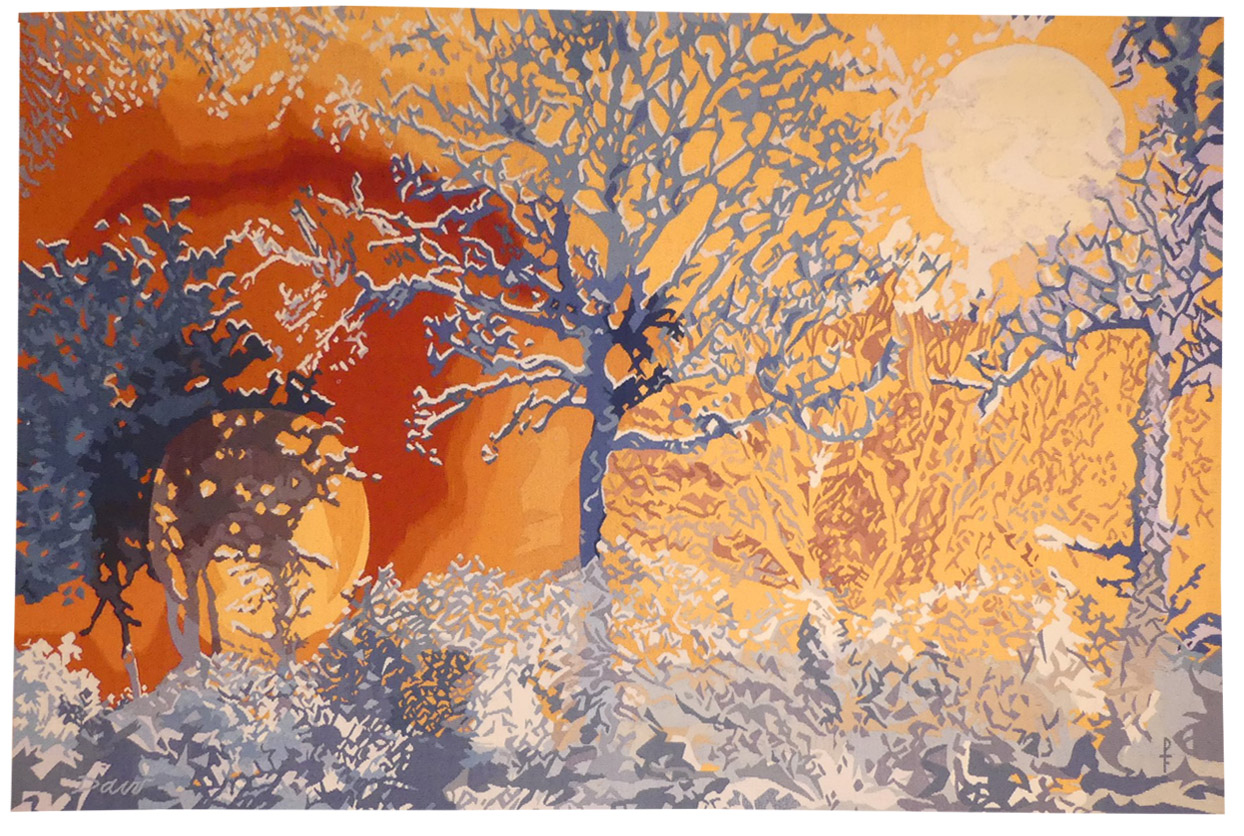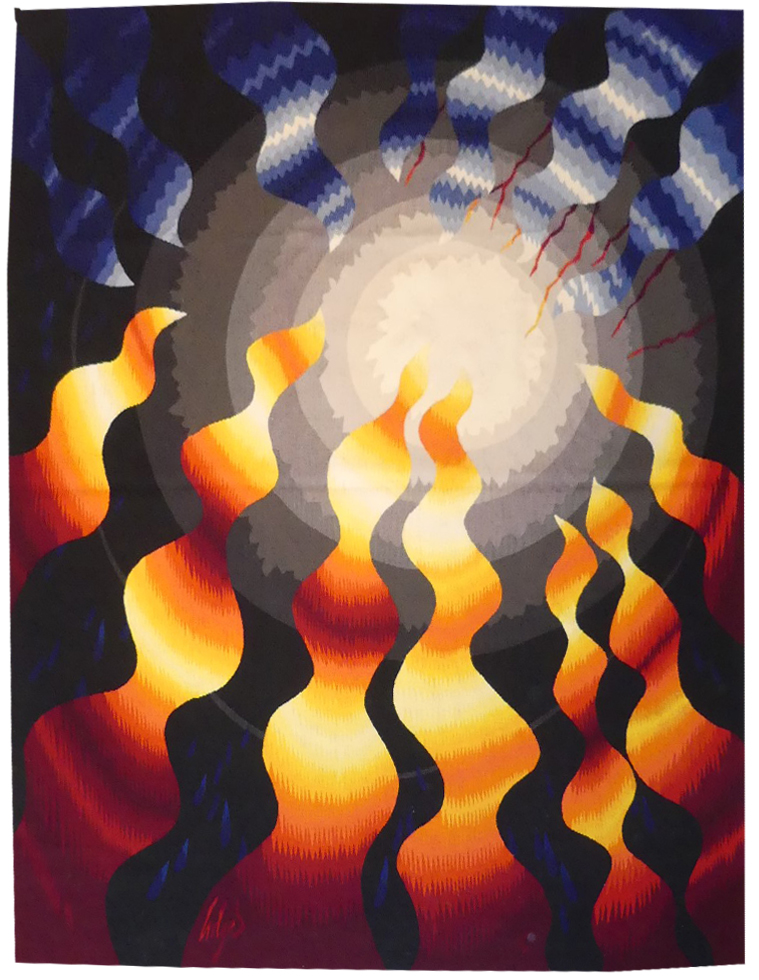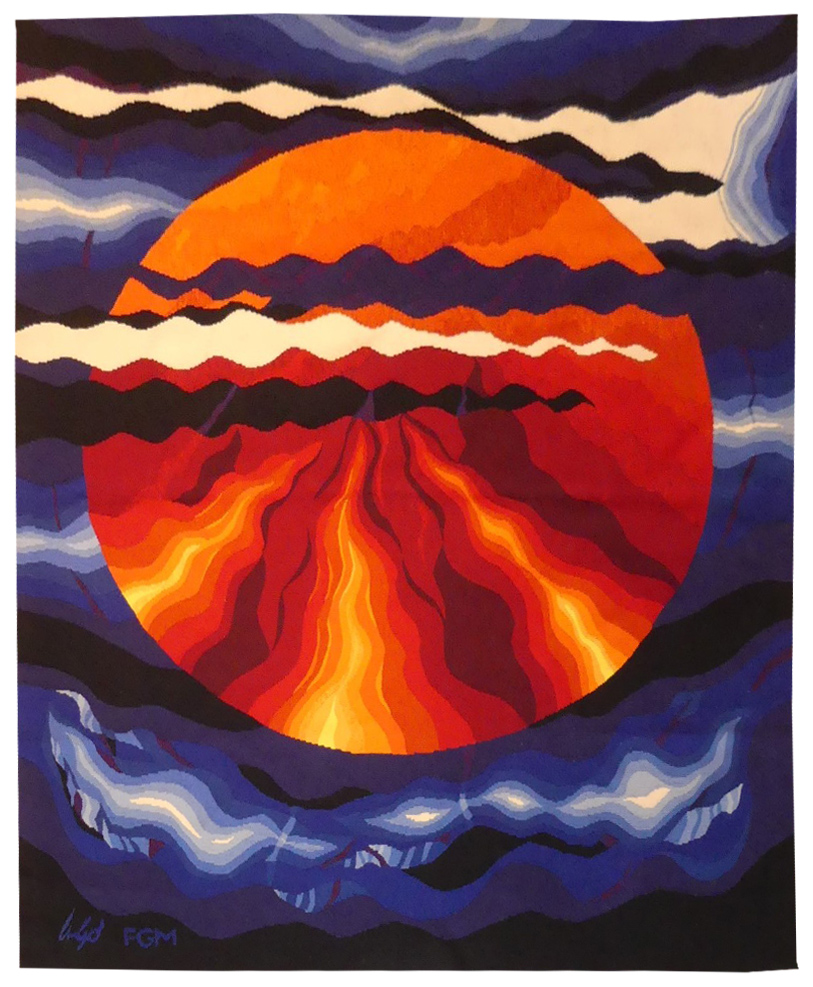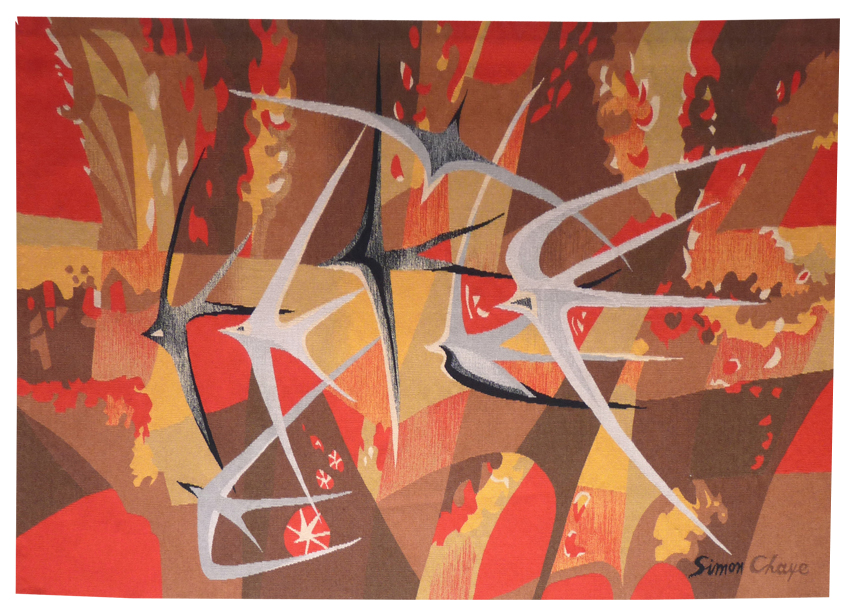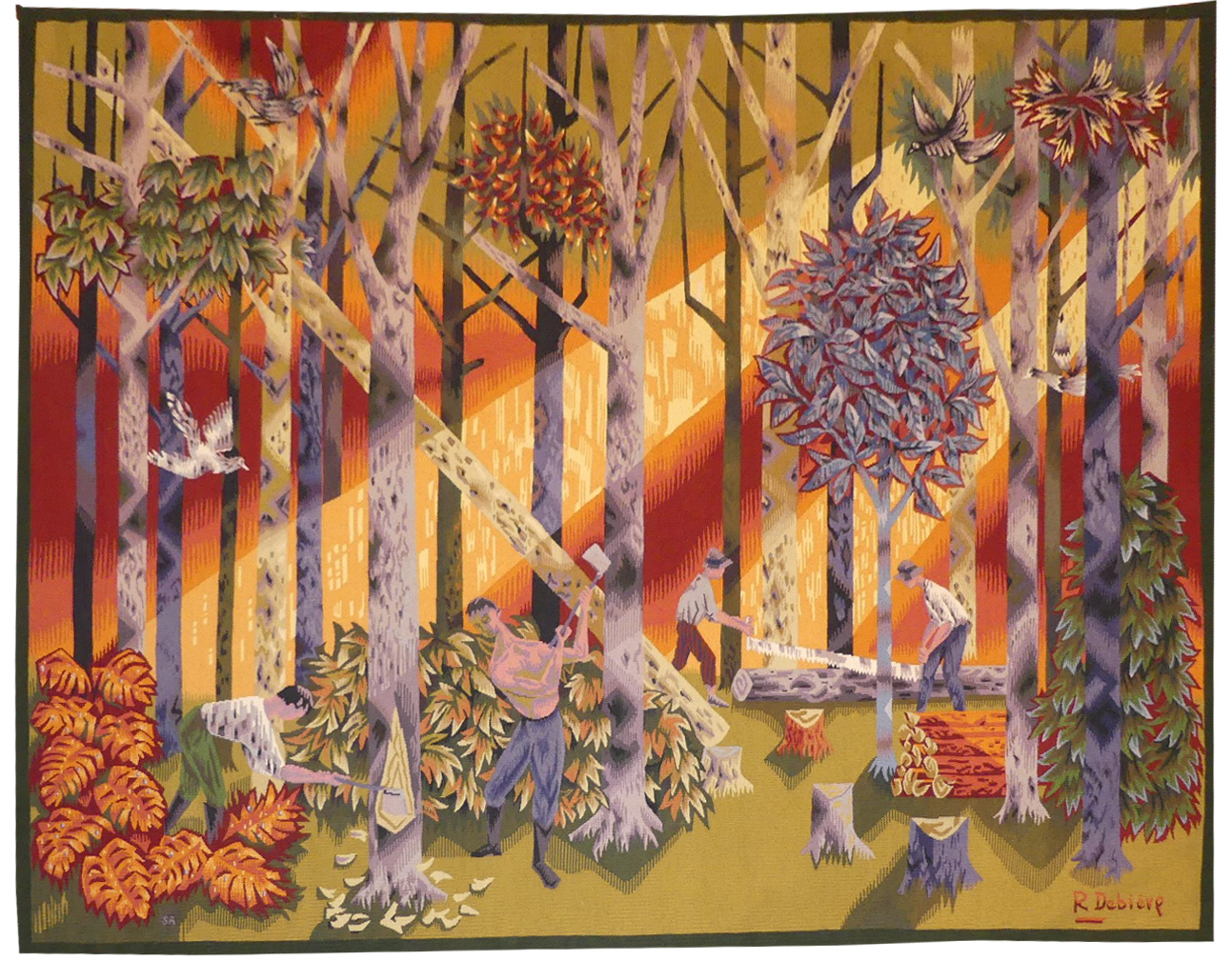-
Papillons de cocagne (ideal butterflies)
Aubusson tapestry, woven in the Picaud workshop. Complete with certificate of origin signed by the artist. Circa 1970. Michèle Van Hout le Beau designed numerous cartoons in the 1960’s and 70’s, working in collaboration with several workshops in Aubusson and receiving some state commissions (she participated along with Soulages, Lagrange, Alechinsky and others in the decoration of the transatlantic Boeing 707’s for Air France). Her style often involves the use of strident colours (very evocative of the 1970’s) from which emerge foliage, stylised human or animal figures. This cartoon, with its acidic colours is particularly characteristic of the artist’s style ; here we can also observe, on a theme abundantly developed by Lurçat, the different way in which the butterflies are evoked : the subject is here a pretext for highly coloured, geometrical evocations approaching abstraction. -
Les Dauphins (Dolphins)
Aubusson tapestry woven in the Picaud workshop. Complete with certificate of origin signed by the artist, n° 6 of 8. 1959. Jean Picart le Doux is one of the foremost figures in the renaissance of the art of tapestry. His earliest contributions to the field date back to 1943 when he designed cartoons for the passenger ship “la Marseillaise”. A close associate of Lurçat, whose theories he would adopt (limited palette, numbered cartoons...), he was a founding member of the A.P.C.T. (Association des Peintres-cartonniers de Tapisserie), and soon after, a teacher at the Ecole Nationale Supérieure des Arts Décoratifs. The state gave him several commissions most of them at the Aubusson workshop, and some at the Gobelins : the most spectacular of these being for the University of Caen, the Theatre in Le Mans, the passenger ship France or the Prefecture of the Creuse département ... In as much as Picart le Doux’s aesthetic is close to that of Lurçat, so also is his insipiration and his subject matter, although in a register which is more decorative than symbolic, where he brings together heavenly bodies (the sun, the moon, the stars...), the elements, nature (wheat, vines, fish, birds...), man, literary quotation ... Reproduced as n° 95 in Bruzeau, the latter comments : « Perfect symbolism of a theme already treat ed ». It is true that, from the very beginning, Picart le Doux made recurrent use of the theme of the sea, and particularly with “le Dauphin” (the Dolphin) in 1951 (Bruzeau n° 27). This cartoon, though rather more stylised, is typical of the symetry favoured by the artist and is executed in a colour scheme redolent of the sea bed. Bibliography : Maurice Bruzeau, Jean Picart le Doux, Murs de soleil, Editions Cercle d’art, 1972 -
Tapisserie d’Aubusson tissée par l’atelier Berthaut. Avec son bolduc signé de l'artiste. 1953. Jean Picart le Doux is one of the foremost figures in the renaissance of the art of tapestry. His earliest contributions to the field date back to 1943 when he designed cartoons for the passenger ship “la Marseillaise”. A close associate of Lurçat, whose theories he would adopt (limited palette, numbered cartoons...), he was a founding member of the A.P.C.T. (Association des Peintres-cartonniers de Tapisserie), and soon after, a teacher at the Ecole Nationale Supérieure des Arts Décoratifs. The state gave him several commissions most of them at the Aubusson workshop, and some at the Gobelins : the most spectacular of these being for the University of Caen, the Theatre in Le Mans, the passenger ship France or the Prefecture of the Creuse département ... In as much as Picart le Doux’s aesthetic is close to that of Lurçat, so also is his insipiration and his subject matter, although in a register which is more decorative than symbolic, where he brings together heavenly bodies (the sun, the moon, the stars...), the elements, nature (wheat, vines, fish, birds...), man, literary quotation ... Birds are a recurrent motif in the artist’s work in the first half of the 1950’s (“la cage ouverte” the open cage, one of the most successful works of this artist, dates from 1953, Picart le Doux here comes back to the same cartoon but with a few minimal changes), as well as the tongues of flame punctuating the edges of the cage. Added to this is the limited colour scheme which is not a little redolent of traditional foliage. Bibliography : Maurice Bruzeau, Jean Picart le Doux, Murs de soleil, Editions Cercle d’art, 1972 Exhibition catalogue Jean Picart le Doux, Musée de la Poste, 1980
-
Camargue
Aubusson tapestry woven in the Pinton workshop. Complete with certificate of origin signed by the artist n° 4 of 6. 1963. With a taste for the large-scale, influenced by Untersteller at the Ecole des Beaux Arts, Hilaire undertook numerous mural paintings. In the same vein, beginning in 1949, along with a number of other artists stimulated by Lurçat, (he would join the latter at the A.P.C.T. Association des Peintres-Cartonniers de Tapisserie) he designed a number of cartoons some of which were woven at Beauvais or at Les Gobelins. His figurative cubist-influenced style (which sometimes approaches abstraction) is immediately recognisable in his tapestry cartoons : in this one, but also for example in the one designed for the Salon Fontainebleau for the ocean liner France, “Sous-bois” (undergrowth) (190 x 988 cm, Pinton frères, reproduced in Le paquebot France, Armelle Bouchet Mazas, Paris 2006p. 169) where shapes and colours are fragmented in a kaleidoscopic fashion. “Camargue” is reproduced in the “Tapisserie d’Aubusson” sample collection of the Guéret Chamber of Commerce and Industry published in the early 1980’s to illstrate the technical competence of the Aubusson workshops. Bibliography : Exhibition catalogue Hilaire, œuvre tissé, galerie Verrière, 1970 (ill.) Exhibition catalogue, du trait à la lumière, Musée Départemental Georges de la Tour at Vic-sur-Seille, 2010. -
Nature morte (still life)
Gobelins tapestry woven by G. Bonnevialle. Complete with label. 1930-1931 (after a 1921 painting). An establishment artist of classical training, Migonney spent many long years in Algeria, which would furnish the subject of much of his work. He gave several cartoons to the Ecole Nationale d’Art Décoratif in Aubusson (along with Véra, Valtat...), whose exhibition stand at the Exposition Internationale des Arts Décoratifs in 1925 included a panel bearing one of his tapestries. This piece is a detail, woven after the artist’s death, taken from a spectacular work (137x205cm) dating from 1921 which hangs in the Musée de Brou in Bourg en Bresse, “Still life with fruit”. It reveals all the weaving detail and nuances which constituted the art of the Gobelin weavers when reproducing a painting, techniques whose use Lurcat would soon make a point of opposing. Bibliography : Exhibition Cat. Tapisseries 1925, Aubusson, Cité de la Tapisserie, 2012 -
Hommage à l'abbé Breuil (a tribute to Father Breuil)
Aubusson tapestry woven by the Pinton workshop. Complete with certificate of origin. Circa 1955. Perrot began his career as a cartoon designer at the end of the war, making almost 500 cartoons including numerous commissions from the state, most of which were woven at Aubusson. His style which is particularly rich and decorative is eminently recognisable : a crowd of butterflies or birds, most often, stands out against a background of vegetation, reminiscent of the millefleurs tapestries (which would also inspire Dom Robert). Uncharacteristic cartoon whose inspiration lies in the cave paintings at Lascaux ; here it can be said that never has a tapestry merited quite so well the term « wall art ». Perrot’s input is, in the end, relatively modest : the use of saturated colours (particularly the mauve-pink background), the overlapping of the motifs (which are more spaced out in the cave itself), superficial laid over blotching,... If Perrot is an habitué of hommage-cartoons (Pergaud, Redouté, Audubon,...) this particular example is interesting because of the well-established proximity between the artist and the dedicatee, “the Pope of Prehistory”: here the hommage owes nothing to the artificiality of an official commission. Bibliography : Tapisseries, dessins, peintures, gravures de René Perrot, Dessein et Tolra, 1982 -
Poissons de la lune (Moon fish)
Aubusson tapestry woven by the Pinton workshop. Complete with certificate of origin. Circa 1960. Fumeron designed his first cartoons (he would ultimately make over 500) in the 1940’s, in collaboration with the Pinton workshop, he was then commissioned on numerous occasions by the state before participating in the decoration of the ocean liner “France”. His work was figurative to begin with and influenced by Lurçat, then turned towards abstraction, before coming back to a style characterised by colourful figurative and realistic depictions from the 1980’s onwards. Beneath the red moon, fish, butterflies, a lobster all frolic in a dream-like composition typical of the artist : numerous examples of these motifs can be found for instance in “Avant l’homme” Before man, woven by the Gobelins (cf Exhibition Catalogue “le Mobilier National et les Manufactures Nationales des Gobelins et de Beauvais sous la IVe République”, Beauvais 1997) -
Soleils éteints (Extinct suns)
Aubusson tapestry woven in the Pinton workshop. Complete with certificate of origin signed by the artist, n°1/6. Circa 1970. Originally an engraver (Prix de Rome, intaglio technique in 1942), Jean-Louis Viard designed his first tapestry cartoons in the mid 1950’s. At first his work was figurative (he was collaborating at the time with Picart Le Doux), but then he evolved along the same lines as many other painter-cartoonists of the period (Matégot, Tourlière or Prassinos,...) towards abstraction. He produced scores of cartoons working up until the 2000’s, in parallel to his work as a painter and engraver, but throughout revealing a particular interest for the use of contrasting materials and textures in the tradition of the “Nouvelle Tapisserie” of which Pierre Daquin was one of the leading lights. The inspiration for his motifs, sometimes metaphysical (“Mémoires” Memories, “Destins” Destinies,…) is wide-reaching, from astronomical infinity « ténèbres solaires » solar darkness) to the microscopic (« Mutation végétale” Plant mutation) : a profuse and varied production, regularly exhibited at his home, in various public and private exhibition spaces and, most significantly, at the Salon Comparaison of which he was the curator for the Tapestry section. Origin : the artist’s workshop -
Destins (Destinies)
Aubusson tapestry woven in the Glaudin-Brivet workshop. Complete with certificate of origin signed by the artist, n°1/6. 1974. Originally an engraver (Prix de Rome, intaglio technique in 1942), Jean-Louis Viard designed his first tapestry cartoons in the mid 1950’s. At first his work was figurative (he was collaborating at the time with Picart Le Doux), but then he evolved along the same lines as many other painter-cartoonists of the period (Matégot, Tourlière or Prassinos,...) towards abstraction. He produced scores of cartoons working up until the 2000’s, in parallel to his work as a painter and engraver, but throughout revealing a particular interest for the use of contrasting materials and textures in the tradition of the “Nouvelle Tapisserie” of which Pierre Daquin was one of the leading lights. The inspiration for his motifs, sometimes metaphysical (“Mémoires” Memories, “Destins” Destinies,…) is wide-reaching, from astronomical infinity « ténèbres solaires » solar darkness) to the microscopic (« Mutation végétale” Plant mutation) : a profuse and varied production, regularly exhibited at his home, in various public and private exhibition spaces and, most significantly, at the Salon Comparaison of which he was the curator for the Tapestry section. Origin : the artist’s workshop -
La roue (the wheel)
Aubusson tapestry woven by the Pinton workshop. Complete with certificate of origin. Circa 1970. Perrot began his career as a cartoon designer at the end of the war, making almost 500 cartoons including numerous commissions from the state, most of which were woven at Aubusson. His style which is particularly rich and decorative is eminently recognisable : a crowd of butterflies or birds, most often, stands out against a background of vegetation, reminiscent of the millefleurs tapestries (which would also inspire Dom Robert). The mediaeval inspiration of a flower-studded, khaki background, numerous birds, all the characteristic elements of Perrot’s cartoons can be found in this particular example. Bibliography: Tapisseries, dessins, peintures, gravures de René Perrot, Dessein et Tolra, 1982 -
Danseuses cambodgiennes (Cambodian dancers)
Tapestry woven at Aubusson by the Picaud workshop. Certificate of origin, n° 1/4. Circa 1965. Although somewhat overlooked now, the contribution that Maurice Ferréol made, in the 1960’s, to the design of figurative tapestry is quite remarkable. He proposed a style redolent of popular imagery where the use of pure blocks of colour exacerbates the almost childlike outline of the figures. What connects these bright and garishly coloured, masked figures to Cambodia? They are simply a pretext for a profusion of colours and motifs in the particular characteristic style of Ferréol. -
Concert des oiseaux (concert of birds)
Tapestry woven in the Picaud workshop. Complete with certificate of origin signed by the artist, n°4/6. Circa 1975. Jean Picart le Doux is one of the foremost figures in the renaissance of the art of tapestry. His earliest contributions to the field date back to 1943 when he designed cartoons for the passenger ship “la Marseillaise”. A close associate of Lurçat, whose theories he would adopt (limited palette, numbered cartoons...), he was a founding member of the A.P.C.T. (Association des Peintres-cartonniers de Tapisserie), and soon after, a teacher at the Ecole Nationale Supérieure des Arts Décoratifs. The state gave him several commissions most of them at the Aubusson workshop, and some at the Gobelins : the most spectacular of these being for the University of Caen, the Theatre in Le Mans, the passenger ship France or the Prefecture of the Creuse département ... In as much as Picart le Doux’s aesthetic is close to that of Lurçat, so also is his inspiration and his subject matter, although in a register which is more decorative than symbolic, where he brings together heavenly bodies (the sun, the moon, the stars...), the elements, nature (wheat, vines, fish, birds...), man, literary quotation ... Music as a theme is frequently associated with birds in Picart le Doux’s work ; this particular cartoon is an extension of the « harpe des forêts” tapestry dating from 1953. Bibliography : Maurice Bruzeau, Jean Picart le Doux, Murs de soleil, Editions Cercle d’art, 1972 Exhibition Catalogue, Jean Picart le Doux, tapisseries, Musée de Saint-Denis, 1976 Exhibition Catalogue Jean Picart le Doux, Musée de la Poste, 1980 -
Poissons et grenouilles (fish and frogs)
Aubusson tapestry woven by the Picaud workshop. Complete with signed label, n°1/4. Circa 1970. Elie Grekoff, whose aesthetic is similar to that of Lurçat, designed over 300 cartons : a black background evokes an underwater world where fish and leaves are pictured with the amusing and un-Lurçat-like presence of frogs. -
Le phénix (the phoenix)
Aubusson tapestry woven in the Hamot workshop. Complete with label signed by the artist, n°EA. 1965. Jean Picart le Doux is one of the foremost figures in the renaissance of the art of tapestry. His earliest contributions to the field date back to 1943 when he designed cartoons for the passenger ship “la Marseillaise”. A close associate of Lurçat, whose theories he would adopt (limited palette, numbered cartoons...), he was a founding member of the A.P.C.T. (Association des Peintres-cartonniers de Tapisserie), and soon after, a teacher at the Ecole Nationale Supérieure des Arts Décoratifs. The state gave him several commissions most of them at the Aubusson workshop, and some at the Gobelins : the most spectacular of these being for the University of Caen, the Theatre in Le Mans, the passenger ship France or the Prefecture of the Creuse département ... In as much as Picart le Doux’s aesthetic is close to that of Lurçat, so also is his inspiration and his subject matter, although in a register which is more decorative than symbolic, where he brings together heavenly bodies (the sun, the moon, the stars...), the elements, nature (wheat, vines, fish, birds...), man, literary quotation ... « Le Phénix » (The Phoenix) (An identical lithograph exists also), a subject inspired by legend (a rare event in the work of Picard le Doux) reproduces a chromatic harmony of yellow motifs against a red background typical of this particular artist. Bibliography : Maurice Bruzeau, Jean Picart le Doux, Murs de soleil, Editions Cercle d’art, 1972, ill. n°162 Exhibition Catalogue, Jean Picart le Doux, tapisseries, Musée de Saint-Denis, 1976 Exhibition Catalogue Jean Picart le Doux, Musée de la Poste, 1980 -
Etoiles de neige (Snow Flakes)
Aubusson tapestry woven in the Berthaut workshop. N°7/8. 1962. Jean Picart le Doux is one of the foremost figures in the renaissance of the art of tapestry. His earliest contributions to the field date back to 1943 when he designed cartoons for the passenger ship “la Marseillaise”. A close associate of Lurçat, whose theories he would adopt (limited palette, numbered cartoons...), he was a founding member of the A.P.C.T. (Association des Peintres-cartonniers de Tapisserie), and soon after, a teacher at the Ecole Nationale Supérieure des Arts Décoratifs. The state gave him several commissions most of them at the Aubusson workshop, and some at the Gobelins : the most spectacular of these being for the University of Caen, the Theatre in Le Mans, the passenger ship France or the Prefecture of the Creuse département ... In as much as Picart le Doux’s aesthetic is close to that of Lurçat, so also is his inspiration and his subject matter, although in a register which is more decorative than symbolic, where he brings together heavenly bodies (the sun, the moon, the stars...), the elements, nature (wheat, vines, fish, birds...), man, literary quotation ... The theme of winter is chracterised in Picart le Doux’s work by the use of templates, colours (muted tones, browns, black, white), and motifs (bare branches, kaleidoscopic flake shapes) ; the snow flakes referred to here will also be used in “Solstice d’hiver” and “Hommage à Vivaldi”. Bibliography : Maurice Bruzeau, Jean Picart le Doux, Murs de soleil, Editions Cercle d’art, 1972, ill. n°122 Exhibition Catalogue, Jean Picart le Doux, tapisseries, Musée de Saint-Denis, 1976 Exhibition Catalogue Jean Picart le Doux, Musée de la Poste, 1980 -
Argos
Aubusson tapestry woven by the Picaud workshop. Complete with signed certificate of origin, n° 1/4. 1971. Loewer designed his first cartoon in 1953 ; his early works are first figurative before turning to abstraction (like Matégot) which is exclusively geometric in Loewer’s case. He designed over 180 cartoons, most of which were woven by his friend, Raymond Picaud. Around 1971-1972, Loewer’s style became more refined, with fewer geometric squares and a brighter, more contrasted use of colour. As is often the case with Loewer, this is a one-off piece. Bibliography : Claude Loewer, l’évasion calculée : travaux de 1939 à 1993, catalogue raisonné des tapisseries de 1953 à 1974, Sylvio Acatos, Charlotte Hug, Walter Tschopp and Marc-Olivier Wahler, Artcatos, 1994, n°128 -
Sphère et colombes (Sphere and doves)
Aubusson tapestry woven in the Berthaut workshop. Complete with signed label. Circa 1954. Jean Picart le Doux is one of the foremost figures in the renaissance of the art of tapestry. His earliest contributions to the field date back to 1943 when he designed cartoons for the passenger ship “la Marseillaise”. A close associate of Lurçat, whose theories he would adopt (limited palette, numbered cartoons...), he was a founding member of the A.P.C.T. (Association des Peintres-cartonniers de Tapisserie), and soon after, a teacher at the Ecole Nationale Supérieure des Arts Décoratifs. The state gave him several commissions most of them at the Aubusson workshop, and some at the Gobelins : the most spectacular of these being for the University of Caen, the Theatre in Le Mans, the passenger ship France or the Prefecture of the Creuse département ... In as much as Picart le Doux’s aesthetic is close to that of Lurçat, so also is his inspiration and his subject matter, although in a register which is more decorative than symbolic, where he brings together heavenly bodies (the sun, the moon, the stars...), the elements, nature (wheat, vines, fish, birds...), man, literary quotation ... Typical of the associations that characterise his work, Picart le Doux here confronts Nature (organised in a formal French garden style) peopled by doves with 3 allegories : literature (a book) the arts (a mandoline), science (a sphere) : the incarnation of a classical mind. Bibliography : Maurice Bruzeau, Jean Picart le Doux, Murs de soleil, Editions Cercle d’art, 1972 Exhibition Catalogue, Jean Picart le Doux, tapisseries, Musée de Saint-Denis, 1976 Exhibition Catalogue Jean Picart le Doux, Musée de la Poste, 1980 -
Petit bois (grove)
Aubusson tapestry woven in the Tabard workshop. With label, signed by the artist. Circa 1970. Henri Ilhe, who came to the design of tapestry cartoons late on in his career, still managed to produce from 1964 onwards a considerable number (more than 120, all woven by the Tabard workshop) in an urbane style, incorporating birds and butterflies sporting in and around the gnarled branches of trees and bushes. “Petit bois” is thus, characteristic of Ilhe’s bucolic inspiration. -
Violoncelle (cello)
Tapestry perhaps woven by the Dumontet workshop. 1947. Lurçat approached Saint-Saëns, originally a painter of murals, in 1940. And during the war the latter produced the first of his allegorical masterpieces, tapestries reflecting indignation, combat, resistance : “les Vierges folles (the foolish virgins), “Thésée et le Minotaure” (Theseus and the Minotaur). At the end of the war, as a natural development he joined up with Lurçat, whose convictions he shared (concerning a simplified palette, outlined cartoons with colours indicated by pre-ordained numbers, and the specific nature of tapestry design...) at the A.P.C.T. (Association des Peintres-cartonniers de Tapisserie). His universe, where the human figure, stretched, elongated, ooccupies an important place (particularly when compared to his companions Lurçat or Picart le Doux), pivots around traditional themes : woman, the Commedia dell’arte, Greek mythology... refined by the brilliance of the colours and the simplification of the layout. His work would evolve later, in the 1960’s, towards cartoons of a more lyrical design, almost abstract where elemental and cosmic forces would dominate. Once more a cartoon which takes music as its theme, a leitmotiv for this artist. Amusingly, and in stark contrast to the importance Saint-Saëns gives to the human figure in his work, the title evokes the instrument rather than the instrumentalist . Bibliography : Exhibition catalogue Saint-Saëns, galerie La Demeure, 1970 Exhibition catalogue Saint-Saëns, the tapestries, Aubusson, Musée départemental de la Tapisserie, 1987 Exhibition catalogue Marc Saint-Saëns, tapestries, 1935-1979, Angers, Musée Jean Lurçat et de la Tapisserie Contemporaine 1997-1998 -
Le chant du matin (morning song)
Aubusson tapestry woven in the Pinton workshop. N°5/6. 1965. Jean Picart le Doux is one of the foremost figures in the renaissance of the art of tapestry. His earliest contributions to the field date back to 1943 when he designed cartoons for the passenger ship “la Marseillaise”. A close associate of Lurçat, whose theories he would adopt (limited palette, numbered cartoons...), he was a founding member of the A.P.C.T. (Association des Peintres-cartonniers de Tapisserie), and soon after, a teacher at the Ecole Nationale Supérieure des Arts Décoratifs. The state gave him several commissions most of them at the Aubusson workshop, and some at the Gobelins : the most spectacular of these being for the University of Caen, the Theatre in Le Mans, the passenger ship France or the Prefecture of the Creuse département ... In as much as Picart le Doux’s aesthetic is close to that of Lurçat, so also is his inspiration and his subject matter, although in a register which is more decorative than symbolic, where he brings together heavenly bodies (the sun, the moon, the stars...), the elements, nature (wheat, vines, fish, birds...), man, literary quotation ... An amusing allegory of a cock-harp, luminescent and joyous : if the title and the motif itself are reminiscent of the work of Jean Lurçat, the particularly decorative character of this piece is typical of Picart le Doux. Bibliography : Maurice Bruzeau, Jean Picart le Doux, Murs de soleil, Editions Cercle d’art, 1972, ill. n°147 Exhibition Catalogue, Jean Picart le Doux, tapisseries, Musée de Saint-Denis, 1976 Exhibition Catalogue Jean Picart le Doux, Musée de la Poste, 1980 -
Hommage à Mozart (Homage to Mozart)
Jean Picart le Doux is one of the foremost figures in the renaissance of the art of tapestry. His earliest contributions to the field date back to 1943 when he designed cartoons for the passenger ship “la Marseillaise”. A close associate of Lurçat, whose theories he would adopt (limited palette, numbered cartoons...), he was a founding member of the A.P.C.T. (Association des Peintres-cartonniers de Tapisserie), and soon after, a teacher at the Ecole Nationale Supérieure des Arts Décoratifs. The state gave him several commissions most of them at the Aubusson workshop, and some at the Gobelins : the most spectacular of these being for the University of Caen, the Theatre in Le Mans, the passenger ship France or the Prefecture of the Creuse département ... In as much as Picart le Doux’s aesthetic is close to that of Lurçat, so also is his insipiration and his subject matter, although in a register which is more decorative than symbolic, where he brings together heavenly bodies (the sun, the moon, the stars...), the elements, nature (wheat, vines, fish, birds...), man, literary quotation ... Cartoons devoted to musical themes are extremely frequent in Picart le Doux’s work : forms (here the concerto), specific works (“La petite musique de nuit”, a little night music, another title for our work ; “Les 4 saisons”, the 4 seasons, for example) composers (“Hommage à Vivaldi”, “Hommage à Bach”, which was reproduced as a stamp in 1980), instruments (“Soleil-Lyre”, Sun-lyre, “Harpe des mers”, Ocean harp), mythological figures (“Orphée”, Orpheus).In most cases these thematic motifs are integrated into a bucolic natural scene animated by birds and butterflies in a decorative style typical of the artist. Bibliography : Marthe Belle-Jouffray, Jean Picart le Doux, Publications filmées d’art et d’histoire, 1966, ill. n°5 Maurice Bruzeau, Jean Picart le Doux, Murs de soleil, Editions Cercle d’art, 1972, ill. n°159 Exhibition Catalogue, Jean Picart le Doux, tapisseries, Musée de Saint-Denis, 1976 Exhibition Catalogue Jean Picart le Doux, Musée de la Poste, 1980Aubusson tapestry woven by the Hamot workshop. N° EA. 1955. -
La souche (the stump)
Fumeron designed his first cartoons (he would ultimately make over 500) in the 1940’s, in collaboration with the Pinton workshop, he was then commissioned on numerous occasions by the state before participating in the decoration of the ocean liner “France”. His work was figurative to begin with and influenced by Lurçat, then turned towards abstraction, before coming back to a style characterised by colourful figurative and realistic depictions from the 1980’s onwards. Strangely enough, despite the naturalistic title, the cartoon leans towards abstraction in a kind of refinement of Fumeron’s figurative cartoons where we can still recognise the circular yellow-sun characteristic of the artist.Aubusson tapestry woven in the Pinton workshop. With label. Circa 1960. -
Hibou (Owl)
Aubusson tapestry woven in the Pinton workshop. 1955.Perrot began his career as a cartoon designer at the end of the war, making almost 500 cartoons including numerous commissions from the state, most of which were woven at Aubusson. His style which is particularly rich and decorative is eminently recognisable : a crowd of butterflies or birds, most often, stands out against a background of vegetation, reminiscent of the millefleurs tapestries (which would also inspire Dom Robert). This tapestry is a typical example of the artist’s portraits of birds ; the owl appears, as often in his work, associated with other birds, against a background inspired by the flower-strewn mediaeval tapestries. Bibliography : Tapisseries, dessins, peintures, gravures de René Perrot, Dessein et Tolra, 1982. -
Couple génétique (Genetic couple)
Aubusson tapestry woven by the Pinton workshop. With label. 1976.In this work – which is apparently the only cartoon by this artist – the deft line and clear drawing technique of Trémois are immediately recognisable. He is best known for his work as an engraver and illustrator, albeit having won the Grand Prix de Rome for his painting. Also evident, his predilection for the nude : here a loving embrace and a meditation on modern science are found in association in a surprising, and very personal, juxtaposition. -
L’enclos (Enclosure)
Aubusson tapestry woven in the Brivet workshop. With signed label, n°4/4. 1966.It was in 1953 that Jean Picart le Doux proposed to Chaye to become his assistant and encouraged him to design tapestry cartoons : he would produce numerous bucolic cartoons, but also views of Normandy (Mont Saint Michel, Honfleur, regattas,...) from whence he came. Here is a thoroughly characteristic cartoon of this artist who specialises in pastures, hedges and woodland scenes. -
Faisan feu (Pheasant Fire)
Lurçat’s artistic production was immense : it is however his role as the renovator of the art of tapestry design which ensures his lasting renown. As early as 1917, he started producing works on canvas, then in the 20’s and 30’s, he worked with Marie Cuttoli. His first collaboration with the Gobelins workshop dates back to 1937, at the same time he discovered the tapestry of the Apocalypse which was essential in his decision to devote himself to tapestry design. He first tackled the technical aspects with François Tabard, then on his installation at Aubusson during the war, he established his technique : broad point, a simplified palette, outlined cartoons with colours indicated by pre-ordained numbers. A huge production then follows (over 1000 cartoons) amplified by his desire to include his painter friends, the creation of the A.P.C.T. (Association des Peintres-Cartonniers de Tapisserie) and the collaboration with the art gallery La Demeure and Denise Majorel, and then by his role as a tireless advocate for the medium around the world. His tapestries reveal a pictorial world which is specifically decorative, with a very personal symbolic iconography : cosmogony (the sun, the planets, the zodiac, the four elements…) stylised vegetation, fauna (rams, cocks, butterflies, chimera …) standing out against a background without perspective (voluntarily different from painting) and, in his more ambitious work, designed as an invitation to share in a poetic (he sometimes weaves quotations into his tapestries) and philosophical (the grand themes are broached from the wartime period onwards) vision whose climax is the “Chant du Monde” (Song of the World) (Jean Lurçat Museum , ancien hôpital Saint Jean, Angers) which remained unfinished at his death. This profile of the head of a cockerel appears in various cartoons (« Feux bleus », « la chanson de Roland »,…) : it appears, with its almond-shaped halo, as if in reserve, shining brightly against the black background. The title of this piece allows a play on words with the French “faire feu” an expression meaning to shoot. Bibliography : Tapisseries de Jean Lurçat 1939-1957, Pierre Vorms Editeur, 1957 Exhibition Catalogue Lurçat, 10 ans après, Musée d'Art moderne de la ville de Paris, 1976 Exhibition catalogue Les domaines de Jean Lurçat, Angers, Musée Jean Lurçat et de la tapisserie contemporaine, 1986 Symposium Jean Lurçat et la renaissance de la tapisserie in Aubusson, Aubusson, Musée départemental de la tapisserie 1992 Exhibition Catalogue Dialogues avec Lurçat, Musées de Basse-Normandie, 1992 Exhibition catalogue Jean Lurçat, Donation Simone Lurçat, Académie des Beaux-Arts, 2004 Jean Lurçat, le chant du monde Angers 2007 Gérard Denizeau, Jean Lurçat, Liénart, 2013 Exhibition Catalogue Jean Lurçat au seul bruit du soleil, Paris, galerie des Gobelins, 2016Aubusson tapestry woven in the Tabard workshop. With signed label. Circa 1960. -
Le paon (the peacock)
Tapestry woven by the Baudonnet workshop. With label. 1959.Lurçat approached Saint-Saëns, originally a painter of murals, in 1940. And during the war the latter produced the first of his allegorical masterpieces, tapestries reflecting indignation, combat, resistance : “les Vierges folles (the foolish virgins), “Thésée et le Minotaure” (Theseus and the Minotaur). At the end of the war, as a natural development he joined up with Lurçat, whose convictions he shared (concerning a simplified palette, outlined cartoons with colours indicated by pre-ordained numbers, and the specific nature of tapestry design…) at the A.P.C.T. (Association des Peintres-cartonniers de Tapisserie). His universe, where the human figure, stretched, elongated, ooccupies an important place (particularly when compared to his companions Lurçat or Picart le Doux), pivots around traditional themes : woman, the Commedia dell’arte, Greek mythology… refined by the brilliance of the colours and the simplification of the layout. His work would evolve later, in the 1960’s, towards cartoons of a more lyrical design, almost abstract where elemental and cosmic forces would dominate. The number and variety of animals used in his tapestries by Saint-Saëns is not so rich as others of his contemporaries such as Lurçat, Perrot or Dom Robert, principally known for his peacocks. Here the use, as if off the ground, of a similar motif (despite the fact that it more ressembles a cockerel than a peacock) illustrates the variety of solutions employed by the painter-cartonniers of the period. Bibliography : Exhibition catalogue Saint-Saëns, galerie La Demeure, 1970 Exhibition catalogue Saint-Saëns, the tapestries, Aubusson, Musée départemental de la Tapisserie, 1987 Exhibition catalogue Marc Saint-Saëns, tapestries, 1935-1979, Angers, Musée Jean Lurçat et de la Tapisserie Contemporaine 1997-1998 -
L’arbre de vie (Life tree)
Henri Ilhe, who came to the design of tapestry cartoons late on in his career, still managed to produce from 1964 onwards a considerable number (more than 120, all woven by the Tabard workshop) in an urbane style, incorporating birds and butterflies sporting in and around the gnarled branches of trees and bushes. Should this be taken as an interpretation of the tree of life as a symbol of Creation as mentioned in various religious traditions, or more simply as an allegory for Nature with its budding leaves irrigated by a meandering stream ?Aubusson tapestry woven in theTabard workshop. With signed label, n°5/8. Circa 1970. -
Flore des Baronnies (Baronnies's Flora)
Aubusson tapestry woven in the Andraud workshop. With label, n°1/6. 1974.A student of Léon Detroy, Gaston Thiéry is one of the last representatives of the Crozant school of painting. Established in the Creuse region of France, he started working on tapestries in 1965 with the Andraud workshop for whom he designed cartoons inspired by the local flora, in a decorative style which can be situated somewhere between that of Dom Robert and Maingonnat, a world away from his landscape paintings which were strongly influenced by the impressionists. -
Cadran solaire (Sundial)
It was in 1953 that Jean Picart le Doux proposed to Chaye to become his assistant and encouraged him to design tapestry cartoons : he would produce numerous bucolic cartoons, but also views of Normandy (Mont Saint Michel, Honfleur, regattas,…) from whence he came. In order to express Nature’s harmony, Chaye includes in this characteristic scene of a river bank animated by flowers and animals, a sign of human presence, static and discreet : a sundial.Aubusson tapestry woven in the Legoueix workshop. With signed label, n°6/6. Circa 1970. -
Petite harpe des bois (little harp of the woods)
Tapestry woven in the Picaud workshop. Complete with certificate of origin signed by the artist's widow, n°3/6. Circa 1975. Jean Picart le Doux is one of the foremost figures in the renaissance of the art of tapestry. His earliest contributions to the field date back to 1943 when he designed cartoons for the passenger ship “la Marseillaise”. A close associate of Lurçat, whose theories he would adopt (limited palette, numbered cartoons...), he was a founding member of the A.P.C.T. (Association des Peintres-cartonniers de Tapisserie), and soon after, a teacher at the Ecole Nationale Supérieure des Arts Décoratifs. The state gave him several commissions most of them at the Aubusson workshop, and some at the Gobelins : the most spectacular of these being for the University of Caen, the Theatre in Le Mans, the passenger ship France or the Prefecture of the Creuse département ... In as much as Picart le Doux’s aesthetic is close to that of Lurçat, so also is his insipiration and his subject matter, although in a register which is more decorative than symbolic, where he brings together heavenly bodies (the sun, the moon, the stars...), the elements, nature (wheat, vines, fish, birds...), man, literary quotation ... This cartoon refers back to « la harpe des forêts”, the sylvan harp, of 1953 (Bruzeau n°45). The link between music and nature is a leitmotiv in the work of Picart le Doux : these tapestries are often animated by birds outlined agains the vertical background of the strings. Bibliography : Maurice Bruzeau, Jean Picart le Doux, Murs de soleil, Editions Cercle d’art, 1972 Exhibition catalogue Jean Picart le Doux Tapisseries, Musée municipal d’Art et d’Histoire, Saint-Denis, 1976 Exhibition catalogue Jean Picart le Doux, Musée de la Poste, 1980 Exhibition Catalogue le salon de musique, église du château, Felletin, 2002, ill. p.54 -
Le compotier (the fruit stand)
Jean Picart le Doux is one of the foremost figures in the renaissance of the art of tapestry. His earliest contributions to the field date back to 1943 when he designed cartoons for the passenger ship “la Marseillaise”. A close associate of Lurçat, whose theories he would adopt (limited palette, numbered cartoons...), he was a founding member of the A.P.C.T. (Association des Peintres-cartonniers de Tapisserie), and soon after, a teacher at the Ecole Nationale Supérieure des Arts Décoratifs. The state gave him several commissions most of them at the Aubusson workshop, and some at the Gobelins : the most spectacular of these being for the University of Caen, the Theatre in Le Mans, the passenger ship France or the Prefecture of the Creuse département ... In as much as Picart le Doux’s aesthetic is close to that of Lurçat, so also is his insipiration and his subject matter, although in a register which is more decorative than symbolic, where he brings together heavenly bodies (the sun, the moon, the stars...), the elements, nature (wheat, vines, fish, birds...), man, literary quotation ... A trellis background, reguarly found in Picart le Doux’s work in the 1950’s, notably in « Nature morte à la fontaine », woven at the Gobelins in 1952, is the expression of a certain decorative inclination to a style of tapestry popular in earlier times. “Le compotier” is a reworking of “les fruits et la guitare”, a larger work, woven at the Berthaut workshop in 1955. Bibliography : Maurice Bruzeau, Jean Picart le Doux, Murs de soleil, Editions Cercle d’art, 1972, ill. n°64 Exhibition catalogue Jean Picart le Doux Tapisseries, Musée municipal d’Art et d’Histoire, Saint-Denis, 1976 Exhibition catalogue Jean Picart le Doux, Musée de la Poste, 1980Aubusson tapestry woven by the Braquenié workshop. Complete with signed label. 1956. -
Concert champêtre (Outdoor concert)
Needle-work tapestry. Circa 1965. « It is thus easy to understand that, having based my painting on my love of tapestry, it was relatively easy for me, and particularly tempting, to produce tapestries which were faithful to my painting” writes the artist in the exhibition catalogue for the 1970 show at the Galerie Verrière. It is not until 1961 that he started making designs (over 50) both for woven tapestries (at Aubusson, but also for the Mobilier National with, on occasion, the collaboration of Pierre Baudoin), but also those employing needlepoint. The artist’s very audacious palette is immediately recognisable in these cartons, with their use of primary colours or, as here, revolving around a very vivid pink with a rather dislocated storyline between the concert in the foreground and the hunting scene in the distance. Provenance : Elmina Auger collection Bibliography : Exhibition catalogue, Lapicque tapisseries, Paris, galerie Villand & Galanis, 1964-1965 Exhibition catalogue, Lapicque, Lyons, Galerie Verrière 1970 -
Solaire (solar )
Aubusson tapestry woven in Pinton workshop. With a label signed by the artist, n°2/6. Circa 1970.Odette Caly, who specialised in the depiction of bouquets, designed numerous cartoons for Aubusson, woven in the Pinton, Henry or Hamot workshops. Her inspiration, rather rural usually, has oriented here towards more exotic flowers, highlighted by the green background. Bibliography : Multi-authored, Caly, Filmed Publications of Art and History, 1972, reproduced No. 24 -
Rendez-vous des oiseaux (the bird's meeting point)
Aubusson tapestry woven in the Berthaut workshop. With label. 1951.Jean Picart le Doux is one of the foremost figures in the renaissance of the art of tapestry. His earliest contributions to the field date back to 1943 when he designed cartoons for the passenger ship “la Marseillaise”. A close associate of Lurçat, whose theories he would adopt (limited palette, numbered cartoons...), he was a founding member of the A.P.C.T. (Association des Peintres-cartonniers de Tapisserie), and soon after, a teacher at the Ecole Nationale Supérieure des Arts Décoratifs. The state gave him several commissions most of them at the Aubusson workshop, and some at the Gobelins : the most spectacular of these being for the University of Caen, the Theatre in Le Mans, the passenger ship France or the Prefecture of the Creuse département ... In as much as Picart le Doux’s aesthetic is close to that of Lurçat, so also is his insipiration and his subject matter, although in a register which is more decorative than symbolic, where he brings together heavenly bodies (the sun, the moon, the stars...), the elements, nature (wheat, vines, fish, birds...), man, literary quotation ... Birds are a recurring motif of the artist in the first half of the 50s, as well as the flames punctuated by dots on the rim, one of Picart le Doux's signatures. Moreover, the limited chromatic range is reminiscent of traditional "verdures" tapestries. This tapestry is reproduced in Bruzeau's book, as No. 30. Bibliography : Maurice Bruzeau, Jean Picart le Doux, Murs de soleil, Editions cercle d'art, 1972 -
Le petit oiseleur (the little bird-catcher)
Aubusson tapestry woven by the Picaud workshop. With label, n°1/6. Circa 1970.Elie Grekoff, whose aesthetic is similar to that of Lurçat, designed over 300 cartons.“The little bird catcher” is typical of a vein characteristic of Grekoff where melancholic children consider each other within a dream-like landscape against a background of large flat areas of colour, redolent of an illustration for a folk tale. -
Le Méridien étoilé (the starry meridian)
Aubusson tapestry woven in the Berthaut workshop. circa 1948.Jean Picart le Doux is one of the foremost figures in the renaissance of the art of tapestry. His earliest contributions to the field date back to 1943 when he designed cartoons for the passenger ship “la Marseillaise”. A close associate of Lurçat, whose theories he would adopt (limited palette, numbered cartoons…), he was a founding member of the A.P.C.T. (Association des Peintres-cartonniers de Tapisserie), and soon after, a teacher at the Ecole Nationale Supérieure des Arts Décoratifs. The state gave him several commissions most of them at the Aubusson workshop, and some at the Gobelins : the most spectacular of these being for the University of Caen, the Theatre in Le Mans, the passenger ship France or the Prefecture of the Creuse département … In as much as Picart le Doux’s aesthetic is close to that of Lurçat, so also is his inspiration and his subject matter, although in a register which is more decorative than symbolic, where he brings together heavenly bodies (the sun, the moon, the stars…), the elements, nature (wheat, vines, fish, birds…), man, literary quotation … This cartoon is extracted from « Cosmogonie » (Bruzeau n°11), from 1948, here presented in a vertical format and without featuring the quotation from Goethe. The theme of the Astrolabe will be recurrent in his work, notably his eponymous tapestry of 1955. Bibliography : Marthe Belle-Jouffray, Jean Picart le Doux, Publications filmées d’art et d’histoire, 1966 Maurice Bruzeau, Jean Picart le Doux, Murs de soleil, Editions Cercle d’art, 1972 Exhibition Catalogue, Jean Picart le Doux, tapisseries, Musée de Saint-Denis, 1976 Exhibition Catalogue Jean Picart le Doux, Musée de la Poste, 1980 -
Annick
Tapestry woven by the Angers workshop. With label, n°1/6. 1968.Elie Grekoff, whose aesthetic is similar to that of Lurçat, designed over 300 cartons The motif of a sun radiating foliage is a classic with this artist ; it is possible that the title refers to a weaver at the Atelier de Tapisserie d’Angers (Angers Tapestry Workshop), which opened in the same year of 1968 and where Grekoff was the first painter-cartonnier to be produced. -
Le réviseur (the reviser)
Aubusson tapestry woven by the Picaud workshop. With label, n°1/8. Circa 1980. Marc Petit met Jean Lurçat in 1954, went to Aubusson in 1955, exhibited his work for the first time at La Demeure in 1956, became a member of the A.P.C.T. (Association des Peintres-Cartonniers de Tapisserie) in 1958. After this lightning start to his career, he produced hundreds of cartoons, in a style all his own, where long-legged waders and acrobats wend in and out of dreamscapes. An amusing design, which could be interpreted as the illustration of the antithesis of an author and his editor : here depicted by the curious association of a bird and a fish, in an extremely lively colour scheme. -
Les nymphéas (the waterlilies)
Aubusson tapestry woven in the Pinton workshop for the Verrière gallery. With label, n°4/6. 1968.With a taste for the large-scale, influenced by Untersteller at the Ecole des Beaux Arts, Hilaire undertook numerous mural paintings. In the same vein, beginning in 1949, along with a number of other artists stimulated by Lurçat, (he would join the latter at the A.P.C.T. Association des Peintres-Cartonniers de Tapisserie) he designed a number of cartoons some of which were woven at Beauvais or at Les Gobelins. Hilaire makes the subject, previously referenced by Monet, his own in his habitual, cubist (and tending towards the abstract) style, characterised by lines and circular shapes in an exalted blue and green colour scheme. His early passion for horticulture, which was originally to be his profession, here echoes that of Monet in Giverny. Bibliography : Exhibition catalogue Hilaire, œuvre tissé, galerie Verrière, 1970, ill. Exhibition catalogue, du trait à la lumière, Musée Départemental Georges de la Tour at Vic-sur-Seille, 2010. -
Holger was a student at the Ecole Nationale d’Art Décoratif d’Aubusson and worked with Lurçat before the latter’s death in 1966. He designed numerous dream-like cartoons woven by the Aubusson workshop. Now settled in the United States, he remains a tireless advocate for, and witness to, modern tapestry design, organising exhibitions and lectures on the subject.
Feu pour Law (Fire for Law)
Aubusson tapestry woven in the Pintron frères workshop. With signed certificate of origin, n°1/6. Circa 1970. -
Soleil (Sun)
Lurçat approached Saint-Saëns, originally a painter of murals, in 1940. And during the war the latter produced the first of his allegorical masterpieces, tapestries reflecting indignation, combat, resistance : “les Vierges folles (the foolish virgins), “Thésée et le Minotaure” (Theseus and the Minotaur). At the end of the war, as a natural development he joined up with Lurçat, whose convictions he shared (concerning a simplified palette, outlined cartoons with colours indicated by pre-ordained numbers, and the specific nature of tapestry design...) at the A.P.C.T. (Association des Peintres-cartonniers de Tapisserie). His universe, where the human figure, stretched, elongated, ooccupies an important place (particularly when compared to his companions Lurçat or Picart le Doux), pivots around traditional themes : woman, the Commedia dell’arte, Greek mythology... refined by the brilliance of the colours and the simplification of the layout. His work would evolve later, in the 1960’s, towards cartoons of a more lyrical design, almost abstract where elemental and cosmic forces would dominate. In the 1960’s, Saint-Saëns moved towards a more abstract style using bright, acidic and highly contrasted colours, and accentuated his attraction to the grand themes of Nature “the seasons”, “lightning”...) Bibliography : Exhibition catalogue Saint-Saëns, galerie La Demeure, 1970 Exhibition catalogue Saint-Saëns, the tapestries, Aubusson, Musée départemental de la Tapisserie, 1987 Exhibition catalogue Marc Saint-Saëns, tapestries, 1935-1979, Angers, Musée Jean Lurçat et de la Tapisserie Contemporaine 1997-1998Tapestry woven by the Baudonnet workshop. N°1/6. Circa 1970. -
Les petites algues (Small seaweed)
Aubusson tapestry woven by the Pinton workshop Complete with certificate of origin. Circa 1950. Jean Picart le Doux is one of the foremost figures in the renaissance of the art of tapestry. His earliest contributions to the field date back to 1943 when he designed cartoons for the passenger ship “la Marseillaise”. A close associate of Lurçat, whose theories he would adopt (limited palette, numbered cartoons…), he was a founding member of the A.P.C.T. (Association des Peintres-cartonniers de Tapisserie), and soon after, a teacher at the Ecole Nationale Supérieure des Arts Décoratifs. The state gave him several commissions most of them at the Aubusson workshop, and some at the Gobelins : the most spectacular of these being for the University of Caen, the Theatre in Le Mans, the passenger ship France or the Prefecture of the Creuse département … In as much as Picart le Doux’s aesthetic is close to that of Lurçat, so also is his insipiration and his subject matter, although in a register which is more decorative than symbolic, where he brings together heavenly bodies (the sun, the moon, the stars…), the elements, nature (wheat, vines, fish, birds…), man, literary quotation … Seaweed (and more generally the underwater world) was a theme in Picart le Doux’s work throughout his career, from “les algues” in 1946 onwards ; “Spiralgues”, “Buisson d’algues”, “les algues vertes”,... to name but a few. “Les petites algues” is a treatment, on a smaller scale, of the theme of “les algues” a cartoon 260 x 250 cm, edited by Leleu. The eponymous seaweed surround, lace-like, a central square where the real subject of the cartoon, a still-life arrangement of seashells and starfish, is framed. Bibliography : Marthe Belle-Joufray, Jean Picart le Doux, Publications filmées d’art et d’histoire, 1966 Maurice Bruzeau, Jean Picart le Doux, Murs de soleil, Editions Cercle d’art, 1972 Exhibition catalogue Jean Picart le Doux Tapisseries, Musée municipal d’Art et d’Histoire, Saint-Denis, 1976 Exhibition catalogue Jean Picart le Doux, Musée de la Poste, 1980 -
Tropiques (Tropics)
On returning to France in the 1950’s after a lengthy period spent in Argentina, Berroeta produced quite a number of cartoons in a style which was first figurative (animals, human figures,...) then turned to abstraction, as in his paintings. The influence of cubism and a lyrical sense of colour cohabit here in a cartoon which could be seen as a reminiscence of South America.Aubusson tapestry woven in the Pinton workshop. Circa 1955. -
Foujita is one of a number of artists whose work was woven at Bièvres at the Moulin de Vauboyen (hence the mark MV woven into the tapestries), which was transformed by Pierre de Tartas into an arts centre in 1959 and devoted to figurative art. Many noteworthy names would pass through including Cocteau, Foujita, Erni, Volti ... among others, who would produce much work, often monumental, as well as realisations in the applied arts (notably book illustrations) Foujita realised only a few tapestry cartoons, all of which were produced at Bièvres by Pierre de Tartas. In this particular case, unlike the rest of his production, his style is different from that of his paintings : almost monochrome, stylised (quite different from the lithe brushwork of the artist); as for the biblical theme, it can be seen as the result of his recent conversion to catholicism. Another tapestry, of similar dimensions and subject matter, but in a differing, lighter colour scheme, was also woven at Bièvres.
Adam et Eve
Tapestry woven in the Moulin de Vauboyen workshop. 1967. -
Jean Picart le Doux is one of the foremost figures in the renaissance of the art of tapestry. His earliest contributions to the field date back to 1943 when he designed cartoons for the passenger ship “la Marseillaise”. A close associate of Lurçat, whose theories he would adopt (limited palette, numbered cartoons…), he was a founding member of the A.P.C.T. (Association des Peintres-cartonniers de Tapisserie), and soon after, a teacher at the Ecole Nationale Supérieure des Arts Décoratifs. The state gave him several commissions most of them at the Aubusson workshop, and some at the Gobelins : the most spectacular of these being for the University of Caen, the Theatre in Le Mans, the passenger ship France or the Prefecture of the Creuse département … In as much as Picart le Doux’s aesthetic is close to that of Lurçat, so also is his insipiration and his subject matter, although in a register which is more decorative than symbolic, where he brings together heavenly bodies (the sun, the moon, the stars…), the elements, nature (wheat, vines, fish, birds…), man, literary quotation … « Poissons-voile » reproduces the central motif of « Rouge de Chine » (Bruzeau n°178), from 1969, with its seaweed, coral and fish, one of this artist’s classic pieces. It is notable that Picart le Doux is probably the cartonnier who most often had recourse to red backgrounds of varying hues. Bibliography : Marthe Belle-Joufray, Jean Picart le Doux, Publications filmées d’art et d’histoire, 1966 Maurice Bruzeau, Jean Picart le Doux, Murs de soleil, Editions Cercle d’art, 1972 Exhibition catalogue Jean Picart le Doux Tapisseries, Musée municipal d’Art et d’Histoire, Saint-Denis, 1976 Exhibition catalogue Jean Picart le Doux, Musée de la Poste, 1980
Poissons-voile (Fish-sail)
Aubusson tapestry woven by the Pinton workshop Complete with certificate of origin signed by the artist, n°5/6. 1969. -
Jardin sauvage (wild garden)
A student of Léon Detroy, Gaston Thiéry is one of the last representatives of the Crozant school of painting. Estalished in the Creuse region of France, he started working on tapestries in 1965 with the Andraud workshop for whom he designed cartoons inspired by the local flora, in a decorative style which can be situated somewhere between that of Dom Robert and Maingonnat, a world away from his landscape paintings which were strongly influenced by the impressionists.Aubusson tapestry woven in the Andraud workshop. With label, n°6/8. 1970. -
Matines (matins)
Henri Ilhe, who came to the design of tapestry cartoons late on in his career, still managed to produce from 1964 onwards a considerable number (more than 120, all woven by the Tabard workshop) in an urbane style, incorporating birds and butterflies sporting in and around the gnarled branches of trees and bushes. The title of this piece evokes a certain community of spirit with Dom Robert in the mingling of rural concerns and monastic life.Aubusson tapestry woven in the Tabard workshop. With signed label, n°5. Circa 1970. -
Composition
It is perhaps the association with Pierre Vago, the architect who was her husband, that inspired Nicole Cormier to take an interest in mural art (cv. “Soleil levant” for the university at Villeneuve d’Ascq) ; in the 1970’s she designed and made hangings sewn from felt and cotton textiles and designed cartoons for tapestries some of which were woven by Pierre Daquin notably.Tapestry woven in the Saint-Cyr workshop. With signed label, n°EA1. Circa 1980. -
Paysage bleu aux papillons (blue landscape with butterflies)
Elie Grekoff, whose aesthetic is similar to that of Lurçat, designed over 300 cartons : here we find evidence of the artist’s evolution from the 1960’s onwards, as the human or animal figures disappear from his work. The recurrent theme is one where a heavenl_ bod_ (the sun, the moon) appears half-hidden behind foliage.Tapestry woven by the ATA (Atelier de Tapisserie d'Angers). With signed label, n°1/4. Circa 1970. -
Bouquet d'octobre (october bouquet)
Aubusson tapestry woven in the Legoueix workshop. With label, n°5/6. Circa 1980.It was in 1953 that Jean Picart le Doux proposed to Chaye to become his assistant and encouraged him to design tapestry cartoons : he would produce numerous bucolic cartoons, but also views of Normandy (Mont Saint Michel, Honfleur, regattas,...) whence he came. The theme of the bouquet is omnipresent in Chaye’s work ; it allows him seasonal or chromatic associations of great decorative value. -
Soleil rouge (Red sun)
Aubusson tapestry woven in the Legoueix workshop. With signed label, n°1/6. Circa 1980.It was in 1953 that Jean Picart le Doux proposed to Chaye to become his assistant and encouraged him to design tapestry cartoons : he would produce numerous bucolic cartoons, but also views of Normandy (Mont Saint Michel, Honfleur, regattas,…) whence he came. A design which brings together two leitmotivs characteristic of Simon Chaye, a bouquet and a flock of birds, which here detach themselves from a background formed by the red sun. -
Ville (city)
A former student at the ENAD in Aubusson, Lartigaud created his first tapestry cartoon in 1968. He went on to design hundreds more, most of them woven by the Four Workshop, in an abstract style occasionally studded with celestial bodies.Aubusson tapestry woven in the Four workshop. With signed label, n°EA. Circa 1980. -
La branche (the branch)
Aubusson tapestry woven by the Hamot workshop. Complete with certificate of origin signed by the artist. 1961. Jean Picart le Doux is one of the foremost figures in the renaissance of the art of tapestry. His earliest contributions to the field date back to 1943 when he designed cartoons for the passenger ship “la Marseillaise”. A close associate of Lurçat, whose theories he would adopt (limited palette, numbered cartoons...), he was a founding member of the A.P.C.T. (Association des Peintres-cartonniers de Tapisserie), and soon after, a teacher at the Ecole Nationale Supérieure des Arts Décoratifs. The state gave him several commissions most of them at the Aubusson workshop, and some at the Gobelins : the most spectacular of these being for the University of Caen, the Theatre in Le Mans, the passenger ship France or the Prefecture of the Creuse département ... In as much as Picart le Doux’s aesthetic is close to that of Lurçat, so also is his insipiration and his subject matter, although in a register which is more decorative than symbolic, where he brings together heavenly bodies (the sun, the moon, the stars...), the elements, nature (wheat, vines, fish, birds...), man, literary quotation ... A cartoon (Bruzeau n° 111) which is typical of the artist in the way it combines the animal and plant kingdoms. The realistic treatment of the bark is in strong contrast with the stylised graphic and dream-like nature of the composition. Bibliography : Maurice Bruzeau, Jean Picart le Doux, Murs de soleil, Editions Cercle d’art, 1972 Exhibition catalogue Jean Picart le Doux, Musée de la Poste, 1980 -
L'oeil ébloui (the dazzled eye)
Tapestry woven in the Clochard workshop. With signed label, n°1/6. Circa 1980.Originally an engraver (Prix de Rome, intaglio technique in 1942), Jean-Louis Viard designed his first tapestry cartoons in the mid 1950’s. At first his work was figurative (he was collaborating at the time with Picart Le Doux), but then he evolved along the same lines as many other painter-cartoonists of the period (Matégot, Tourlière or Prassinos,…) towards abstraction. He produced scores of cartoons working up until the 2000’s, in parallel to his work as a painter and engraver, but throughout revealing a particular interest for the use of contrasting materials and textures in the tradition of the “Nouvelle Tapisserie” of which Pierre Daquin was one of the leading lights. The inspiration for his motifs, sometimes metaphysical (“Mémoires” Memories, “Destins” Destinies,…) is wide-reaching, from astronomical infinity « ténèbres solaires » solar darkness) to the microscopic (« Mutation végétale” Plant mutation) : a profuse and varied production, regularly exhibited at his home, in various public and private exhibition spaces and, most significantly, at the Salon Comparaison of which he was the curator for the Tapestry section. -
Coq (rooster )
Lurçat’s artistic production was immense : it is however his role as the renovator of the art of tapestry design which ensures his lasting renown. As early as 1917, he started producing works on canvas, then in the 20’s and 30’s, he worked with Marie Cuttoli. His first collaboration with the Gobelins workshop dates back to 1937, at the same time he discovered the tapestry of the Apocalypse which was essential in his decision to devote himself to tapestry design. He first tackled the technical aspects with François Tabard, then on his installation at Aubusson during the war, he established his technique : broad point, a simplified palette, outlined cartoons with colours indicated by pre-ordained numbers. A huge production then follows (over 1000 cartoons) amplified by his desire to include his painter friends, the creation of the A.P.C.T. (Association des Peintres-Cartonniers de Tapisserie) and the collaboration with the art gallery La Demeure and Denise Majorel, and then by his role as a tireless advocate for the medium around the world. His tapestries reveal a pictorial world which is specifically decorative, with a very personal symbolic iconography : cosmogony (the sun, the planets, the zodiac, the four elements…) stylised vegetation, fauna (rams, cocks, butterflies, chimera …) standing out against a background without perspective (voluntarily different from painting) and, in his more ambitious work, designed as an invitation to share in a poetic (he sometimes weaves quotations into his tapestries) and philosophical (the grand themes are broached from the wartime period onwards) vision whose climax is the “Chant du Monde” (Song of the World) (Jean Lurçat Museum , ancien hôpital Saint Jean, Angers) which remained unfinished at his death. The cock, in various guises, variously bedecked, playing various roles, is an absolutely central figure in Lurçat’s bestiary, a recurrent motif reappearing in an infinite number of variations : what is particular about this version is the crown of ivy and the feather-leaves both of which are a reference to the animal-vegetable syntheses so characteristic of this artist. Bibliography : Cat. Expo. La tapisserie française, Musée d’art moderne, Paris, 1946 Tapisseries de Jean Lurçat 1939-1957, Pierre Vorms Editeur, 1957 Cat. Expo. Jean Lurçat, tapisseries de la fondation Rothmans, Musée de Metz, 1969 Exhibition Catalogue Lurçat, 10 ans après, Musée d’Art moderne de la ville de Paris, 1976 Exhibition catalogue Les domaines de Jean Lurçat, Angers, Musée Jean Lurçat et de la tapisserie contemporaine, 1986 Symposium Jean Lurçat et la renaissance de la tapisserie in Aubusson, Aubusson, Musée départemental de la tapisserie 1992 Exhibition Catalogue Dialogues avec Lurçat, Musées de Basse-Normandie, 1992 Exhibition catalogue Jean Lurçat, Donation Simone Lurçat, Académie des Beaux-Arts, 2004 Jean Lurçat, le chant du monde Angers 2007 Gérard Denizeau, Jean Lurçat, Liénart, 2013 Exhibition Catalogue Jean Lurçat, Meister der französischen Moderne, Halle, Kunsthalle Exhibition Catalogue Jean Lurçat au seul bruit du soleil, Paris, galerie des Gobelins, 2016Tapestry woven in the Goubely workshop. With faded label. Circa 1950. -
Oiseaux et grappes (birds and bunches)
Lurçat’s artistic production was immense : it is however his role as the renovator of the art of tapestry design which ensures his lasting renown. As early as 1917, he started producing works on canvas, then in the 20’s and 30’s, he worked with Marie Cuttoli. His first collaboration with the Gobelins workshop dates back to 1937, at the same time he discovered the tapestry of the Apocalypse which was essential in his decision to devote himself to tapestry design. He first tackled the technical aspects with François Tabard, then on his installation at Aubusson during the war, he established his technique : broad point, a simplified palette, outlined cartoons with colours indicated by pre-ordained numbers. A huge production then follows (over 1000 cartoons) amplified by his desire to include his painter friends, the creation of the A.P.C.T. (Association des Peintres-Cartonniers de Tapisserie) and the collaboration with the art gallery La Demeure and Denise Majorel, and then by his role as a tireless advocate for the medium around the world. His tapestries reveal a pictorial world which is specifically decorative, with a very personal symbolic iconography : cosmogony (the sun, the planets, the zodiac, the four elements…) stylised vegetation, fauna (rams, cocks, butterflies, chimera …) standing out against a background without perspective (voluntarily different from painting) and, in his more ambitious work, designed as an invitation to share in a poetic (he sometimes weaves quotations into his tapestries) and philosophical (the grand themes are broached from the wartime period onwards) vision whose climax is the “Chant du Monde” (Song of the World) (Jean Lurçat Museum , ancien hôpital Saint Jean, Angers) which remained unfinished at his death. As always, a synthesis of motifs : vines, bunches of grapes, glasses are habitually displayed on the artist’s lain tables, whilst birds are generally paired with fish. Here the vision is not symbolic but, as suggested by the title, more an evocation of the winegrower’s adversaries. Bibliography : Tapisseries de Jean Lurçat 1939-1957, Pierre Vorms Editeur, 1957 Exhibition Catalogue Lurçat, 10 ans après, Musée d’Art moderne de la ville de Paris, 1976 Exhibition catalogue Les domaines de Jean Lurçat, Angers, Musée Jean Lurçat et de la tapisserie contemporaine, 1986 Symposium Jean Lurçat et la renaissance de la tapisserie in Aubusson, Aubusson, Musée départemental de la tapisserie 1992 Exhibition Catalogue Dialogues avec Lurçat, Musées de Basse-Normandie, 1992 Exhibition catalogue Jean Lurçat, Donation Simone Lurçat, Académie des Beaux-Arts, 2004 Jean Lurçat, le chant du monde Angers 2007 Gérard Denizeau, Jean Lurçat, Liénart, 2013 Exhibition Catalogue Jean Lurçat, Meister der französischen Moderne, Halle, Kunsthalle Exhibition Catalogue Jean Lurçat au seul bruit du soleil, Paris, galerie des Gobelins, 2016Tapestry woven in the Pinton workshop. With label. Circa 1950. -
Le merle blanc (the white blackbird)
Henri Ilhe, who came to the design of tapestry cartoons late on in his career, still managed to produce from 1964 onwards a considerable number (more than 120, all woven by the Tabard workshop) in an urbane style, incorporating birds and butterflies sporting in and around the gnarled branches of trees and bushes. With this representation of a bird whose rarity value is equal to that of a five-legged sheep, Ilhe expresses no ornithological pretention, merely an illustration of the natural world as a collection of singular phenomena.Aubusson tapestry woven in the Tabard workshop. With signed label. Circa 1965. -
Garrigue de printemps (spring garrigue)
Debiève designed numerous cartoons in a style that is typical of the 1940’s (« le remailleur de filets” the mender of nets, “le potier” the potter,...) although the vast majority were printed on fabric. A notably smaller number of his designs were produced as tapestries in Aubusson and his cartoons are close to the aesthetic of his paintings inspired by Provence.Aubusson tapestry woven by the Jean Laurent workshop. With label, n°3/8. 1976. -
Composition
On returning to France in the 1950’s after a lengthy period spent in Argentina, Berroeta produced quite a number of cartoons in a style which was first figurative (animals, human figures,...) then turned to abstraction, as in his paintings. If he adopts here the motif of fish, very common at the time in contemporary tapestry (cf. Lurçat, Picart le Doux), Berroeta can be considered to have a certain legitimacy in exploiting this subject as it is one he has used on several occasions, in “Mer du Sud” (the south sea) for example.Aubusson tapestry woven by the Pinton workshop. With label. Circa 1950. -
Coq rouge (red rooster)
Lurçat approached Saint-Saëns, originally a painter of murals, in 1940. And during the war the latter produced the first of his allegorical masterpieces, tapestries reflecting indignation, combat, resistance : “les Vierges folles (the foolish virgins), “Thésée et le Minotaure” (Theseus and the Minotaur). At the end of the war, as a natural development he joined up with Lurçat, whose convictions he shared (concerning a simplified palette, outlined cartoons with colours indicated by pre-ordained numbers, and the specific nature of tapestry design…) at the A.P.C.T. (Association des Peintres-cartonniers de Tapisserie). His universe, where the human figure, stretched, elongated, ooccupies an important place (particularly when compared to his companions Lurçat or Picart le Doux), pivots around traditional themes : woman, the Commedia dell’arte, Greek mythology… refined by the brilliance of the colours and the simplification of the layout. His work would evolve later, in the 1960’s, towards cartoons of a more lyrical design, almost abstract where elemental and cosmic forces would dominate. The theme of the cockerel, already present in « réveille-matin » (the alarm clock) in 1959, is something of a rarity in Saint-Saëns’s work (notably when compared with that of Lurçat). In this case the style has much evolved : the forms are supple and sinuous, the colours vivid, the lines uncluttered as if drawn in (red) chalk on a blackboard. Bibliography : Exhibition catalogue Saint-Saëns, oeuvre tissé, Aubusson, Musée départemental de la Tapisserie, 1987 Exhibition catalogue Marc Saint-Saëns, tapisseries, 1935-1979, Angers, Musée Jean Lurçat et de la Tapisserie Contemporaine, 1997-1998, ill. p.22Aubusson tapestry woven by the Glaudin-Brivet workshop. n°1/6. 1974. -
Nachtsonne (Nightsun)
Tapestry woven by the Münchener Gobelin Manufaktur. With signed label. Circa 1970.Holger was a student at the Ecole Nationale d’Art Décoratif d’Aubusson and worked with Lurçat before the latter’s death in 1966. He designed numerous dream-like cartoons woven by the Aubusson workshop. Now settled in the United States, he remains a tireless advocate for, and witness to, modern tapestry design, organising exhibitions and lectures on the subject. Some of his cartoons have been woven in the two workshops active in Germany, in Nuremberg and Munich, using Aubusson techniques. -
Source claire (clear spring)
Aubusson tapestry woven in the Bonjour workshop. With signed label, n°3/4. Circa 1960.It was in 1953 that Jean Picart le Doux proposed to Chaye to become his assistant and encouraged him to design tapestry cartoons : he would produce numerous bucolic cartoons, but also views of Normandy (Mont Saint Michel, Honfleur, regattas,…) whence he came.A classic cartoon in the naturalistic vein of this particular artist, who made a speciality of enclosures, hedges and riverbanks with animals. -
L'étang (the pond)
Aubusson tapestry woven in the Legoueix workshop. With signed label, n°6/6. Circa 1970.It was in 1953 that Jean Picart le Doux proposed to Chaye to become his assistant and encouraged him to design tapestry cartoons : he would produce numerous bucolic cartoons, but also views of Normandy (Mont Saint Michel, Honfleur, regattas,…) whence he came. An exact reproduction of the cartoon “Nénuphars” (waterlilies), the only difference being the change of the background colour from the original green. -
Jeux interplanétaires (interplanetary games)
A former student at the ENAD in Aubusson, Lartigaud created his first tapestry cartoon in 1968. He went on to design hundreds more, most of them woven by the Four Workshop, in an abstract style occasionally studded with celestial bodies.Aubusson tapestry woven in the Four workshop. With label, n°EA. Circa 1970. -
Coq sabreur (fighting cock)
Lurçat’s artistic production was immense : it is however his role as the renovator of the art of tapestry design which ensures his lasting renown. As early as 1917, he started producing works on canvas, then in the 20’s and 30’s, he worked with Marie Cuttoli. His first collaboration with the Gobelins workshop dates back to 1937, at the same time he discovered the tapestry of the Apocalypse which was essential in his decision to devote himself to tapestry design. He first tackled the technical aspects with François Tabard, then on his installation at Aubusson during the war, he established his technique : broad point, a simplified palette, outlined cartoons with colours indicated by pre-ordained numbers. A huge production then follows (over 1000 cartoons) amplified by his desire to include his painter friends, the creation of the A.P.C.T. (Association des Peintres-Cartonniers de Tapisserie) and the collaboration with the art gallery La Demeure and Denise Majorel, and then by his role as a tireless advocate for the medium around the world. His tapestries reveal a pictorial world which is specifically decorative, with a very personal symbolic iconography : cosmogony (the sun, the planets, the zodiac, the four elements…) stylised vegetation, fauna (rams, cocks, butterflies, chimera …) standing out against a background without perspective (voluntarily different from painting) and, in his more ambitious work, designed as an invitation to share in a poetic (he sometimes weaves quotations into his tapestries) and philosophical (the grand themes are broached from the wartime period onwards) vision whose climax is the “Chant du Monde” (Song of the World) (Jean Lurçat Museum , ancien hôpital Saint Jean, Angers) which remained unfinished at his death. In the long and varied genealogy of Lurçat's representations of the cock, this « fighting cock » (possible tautology?) is a late production (1961), but it is in fact a partial (and reversed) reproduction of « Guerrier » (warrior) a much earlier piece, which explains the presence of tricolour elements typical of Lurçat's productions of the war years. Another copy of this piece is kept at the Cité de la Tapisserie in Aubusson. Bibliography : Tapisseries de Jean Lurçat 1939-1957, Pierre Vorms Editeur, 1957 Exhibition Catalogue Lurçat, 10 ans après, Musée d’Art moderne de la ville de Paris, 1976 Exhibition catalogue Les domaines de Jean Lurçat, Angers, Musée Jean Lurçat et de la tapisserie contemporaine, 1986 Symposium Jean Lurçat et la renaissance de la tapisserie in Aubusson, Aubusson, Musée départemental de la tapisserie 1992 Exhibition Catalogue Dialogues avec Lurçat, Musées de Basse-Normandie, 1992 Exhibition catalogue Jean Lurçat, Donation Simone Lurçat, Académie des Beaux-Arts, 2004 Jean Lurçat, le chant du monde Angers 2007 Gérard Denizeau, Denise Majorel, une vie pour la tapisserie, Aubusson, Musée départemental de la tapisserie, ill. p.59 Gérard Denizeau, Jean Lurçat, Liénart, 2013, ill. fig. 154 Exhibition Catalogue Jean Lurçat, Meister der französischen Moderne, Halle, Kunsthalle Exhibition Catalogue Jean Lurçat au seul bruit du soleil, Paris, galerie des Gobelins, 2016Tapestry woven in the Picaud workshop. With signed label. 1961. -
Féérie automnale (automn wonder)
A student of Léon Detroy, Gaston Thiéry is one of the last representatives of the Crozant school of painting. Estalished in the Creuse region of France, he started working on tapestries in 1965 with the Andraud workshop for whom he designed cartoons inspired by the local flora, in a decorative style which can be situated somewhere between that of Dom Robert and Maingonnat, a world away from his landscape paintings which were strongly influenced by the impressionists.Aubusson tapestry woven in the Andraud workshop. With label, n°EA2. 1977. -
Marchande d'illusions (the dream vendor)
Elie Grekoff, whose aesthetic is similar to that of Lurçat, designed over 300 cartons “The dream vendor” is typical of a vein characteristic of Grekoff where melancholic children consider each other, as in a scene on a stage, redolent of an illustration for a folk tale.Aubusson tapestry woven by the Pinton workshop. With label. Circa 1955. -
Le village d'Eze (the village of Eze)
In a decorative post-cubist style redolent of Toffoli, Raymond Poulet here interprets one of the most spectacular locations on the côteAubusson tapestry woven by the Jean Laurent workshop. N°3/6. Circa 1980. -
Jardin sauvage (wild garden)
Aubusson tapestry woven by the Glaudin-Brivet workshop. With signed label, n°4/4. Circa 1970. It was in 1953 that Jean Picart le Doux proposed to Chaye to become his assistant and encouraged him to design tapestry cartoons : he would produce numerous bucolic cartoons, but also views of Normandy (Mont Saint Michel, Honfleur, regattas,…) from whence he came. Here is a thoroughly characteristic cartoon of this artist who specialises in pastures, hedges and woodland scenes. -
Sirocco
Despite considering herself first and foremost a sculptor, Hedva Ser also produced some cartoons, woven at the Four workshop in Aubusson, which evoke atmospheric scenes (there are also “Esterel”, “Pampa”, “Océan”...), where clouds, reflections, waves and dunes... are represented by the effective use of different threads and stitches.Aubusson tapestry woven by the Four workshop. N°2/6. Circa 1990. -
L'oiseau flamme (the flame bird)
Aubusson tapestry woven by the Berthaut workshop. With signed label. Circa 1960. Jean Picart le Doux is one of the foremost figures in the renaissance of the art of tapestry. His earliest contributions to the field date back to 1943 when he designed cartoons for the passenger ship “la Marseillaise”. A close associate of Lurçat, whose theories he would adopt (limited palette, numbered cartoons...), he was a founding member of the A.P.C.T. (Association des Peintres-cartonniers de Tapisserie), and soon after, a teacher at the Ecole Nationale Supérieure des Arts Décoratifs. The state gave him several commissions most of them at the Aubusson workshop, and some at the Gobelins : the most spectacular of these being for the University of Caen, the Theatre in Le Mans, the passenger ship France or the Prefecture of the Creuse département ... In as much as Picart le Doux’s aesthetic is close to that of Lurçat, so also is his inspiration and his subject matter, although in a register which is more decorative than symbolic, where he brings together heavenly bodies (the sun, the moon, the stars...), the elements, nature (wheat, vines, fish, birds...), man, literary quotation ... This lyrebird motif dates from 1954 and is taken from a larger and richer design incorporating a garden « à la française ». Picart le Doux habitually recycled elements from earlier designs. Bibliography : Marthe Belle-Joufray, Jean Picart le Doux, Publications filmées d’art et d’histoire, 1966 Maurice Bruzeau, Jean Picart le Doux, Murs de soleil, Editions Cercle d’art, 1972 Exhibition Catalogue, Jean Picart le Doux, tapisseries, Musée de Saint-Denis, 1976 Exhibition Catalogue Jean Picart le Doux, Musée de la Poste, 1980 -
Le royal (King pheasant)
Edmond Dubrunfaut can be considered as the great 20th century renovator of the Belgian tapestry tradition. He founded a weavers’ workshop in Tournai as early as 1942, then, in 1947, created the Centre de Rénovation de la Tapisserie de Tournai. He produced for various Belgian workshops (Chaudoir, de Wit,...) numerous cartoons destined notably to adorn Belgian embassies throughout the world. Moreover, Dubrunfaut was a teacher of monumental art forms at the Academie des Beaux-Arts de Mons from 1947 to 1978 and then, in 1979, contributed to the creation of the Fondation de la tapisserie, des arts du tissu et des arts muraux de Tournai, a veritable heritage centre for the art of the tapestry in Wallonie. His style, characterised by figuration, strong colour contrasts, draws direct inspiration from nature and animal life (as with Perrot, for example, this artist has a net predilection for birdlife). Both the subject and the bright blue background are an echo of Perrot’s work. Also characteristic of Dubrunfaut are the feather-leaves : the animal clothes itself in vegetation.Aubusson tapestry woven in the Simone André workshop. With signed label. Circa 1965. -
Le grand tétras (Capercaillie)
Aubusson tapestry woven by the Legoueix workshop. With signed label, n°2/6. Circa 1970. It was in 1953 that Jean Picart le Doux proposed to Chaye to become his assistant and encouraged him to design tapestry cartoons : he would produce numerous bucolic cartoons, but also views of Normandy (Mont Saint Michel, Honfleur, regattas,…) from whence he came. Here is a thoroughly characteristic cartoon of this artist who specialises in pastures, hedges and woodland scenes. -
Eclosion (hatching)
Aubusson tapestry woven by the Legoueix workshop. With signed label, n°1/6. Circa 1970. It was in 1953 that Jean Picart le Doux proposed to Chaye to become his assistant and encouraged him to design tapestry cartoons : he would produce numerous bucolic cartoons, but also views of Normandy (Mont Saint Michel, Honfleur, regattas,…) from whence he came. Here is a thoroughly characteristic cartoon of this artist who specialises in pastures, hedges and woodland scenes. -
Fleurs et feuilles (flowers and leaves)
Multi-talented artist (poet, lyricist, painter and even antiques dealer,…) Saint-Martin, who assisted Lurçat at the beginning of the 1950’s, started designing his own cartoons in 1956 and they were woven in the Braquenié workshop. His is a dream-like, stylised and dramatised world : here, symbols of order and discipline (the still life composition, the wrought iron balustrade...) contrast with the unsettling, unfettered profusion of the branches on each side.Aubusson tapestry woven by the Braquenié workshop. With label. Circa 1960. -
Sérénade
Aubusson tapestry woven in the Pinton workshop. Circa 1950. With a taste for the large-scale, influenced by Untersteller at the Ecole des Beaux Arts, Hilaire undertook numerous mural paintings. In the same vein, beginning in 1949, along with a number of other artists stimulated by Lurçat, (he would join the latter at the A.P.C.T. Association des Peintres-Cartonniers de Tapisserie) he designed a number of cartoons some of which were woven at Beauvais or at Les Gobelins. This tapestry is probably one of Hilaire’s first cartoons for the medium, at a period in his work when the human figure was still omnipresent (before disappearing completely around 1960), and he was being regularly commissioned for works in public spaces : this bucolic « Serenade » can be seen to refer to « Quatuor » a cartoon dating from 1950 and woven by Pinton for the Mobilier National. Bibliography : Exhibition catalogue Hilaire, œuvre tissé, galerie Verrière, 1970 Exhibition catalogue, du trait à la lumière, Musée Départemental Georges de la Tour at Vic-sur-Seille, 2010. -
Fleurs éclatées (shattered flowers)
Known essentially as a sculptor, Segeron produced a certain number of cartoons, woven by Legoueix in Aubusson. In a variety of colours and under a number of different titles, we are confronted by a scattering, almost as though torn, of similar shape-designs rather like strange rhizomes or capillary networks.Aubusson tapestry woven by the Legoueix workshop. With label, n°1/6. Circa 1980. -
La grâce (grace)
Kozo Inoué moved to Paris in 1960 and devoted himself mainly to screen printing. His work was woven by the Four workshop from 1984 onwards. In his works, all of which present “grace” unfolding petals, leaves or butterflies, as if suspended, single (or occasionally multiple) motifs against a contrasting, shaded background.Aubusson tapestry woven by the Four workshop. With signed label, n°5/6. Circa 1990. -
Gestation
Known essentially as a sculptor, Segeron produced a certain number of cartoons, woven by Legoueix in Aubusson. In a variety of colours and under a number of different titles, we are confronted by a scattering, almost as though torn, of similar shape-designs rather like strange rhizomes or capillary networks.Aubusson tapestry woven by the Legoueix workshop. With label, n°2/6. Circa 1980. -
Coqthon (Cocktuna)
Lurçat’s artistic production was immense : it is however his role as the renovator of the art of tapestry design which ensures his lasting renown. As early as 1917, he started producing works on canvas, then in the 20’s and 30’s, he worked with Marie Cuttoli. His first collaboration with the Gobelins workshop dates back to 1937, at the same time he discovered the tapestry of the Apocalypse which was essential in his decision to devote himself to tapestry design. He first tackled the Gobelins, 2016technical aspects with François Tabard, then on his installation at Aubusson during the war, he established his technique : broad point, a simplified palette, outlined cartoons with colours indicated by pre-ordained numbers. A huge production then follows (over 1000 cartoons) amplified by his desire to include his painter friends, the creation of the A.P.C.T. (Association des Peintres-Cartonniers de Tapisserie) and the collaboration with the art gallery La Demeure and Denise Majorel, and then by his role as a tireless advocate for the medium around the world. His tapestries reveal a pictorial world which is specifically decorative, with a very personal symbolic iconography : cosmogony (the sun, the planets, the zodiac, the four elements…) stylised vegetation, fauna (rams, cocks, butterflies, chimera …) standing out against a background without perspective (voluntarily different from painting) and, in his more ambitious work, designed as an invitation to share in a poetic (he sometimes weaves quotations into his tapestries) and philosophical (the grand themes are broached from the wartime period onwards) vision whose climax is the “Chant du Monde” (Song of the World) (Jean Lurçat Museum , ancien hôpital Saint Jean, Angers) which remained unfinished at his death. If there is one motif that is omnipresent in Lurçat’s work over the years it is that of the cockerel, in an infinite variety of interpretations. It can be used in many and various associations, syntheses (cocktuna rather than cock and tuna) bridging different elements, hierarchies, natural worlds. Bibliography : Tapisseries de Jean Lurçat 1939-1957, Pierre Vorms Editeur, 1957 Exhibition Catalogue Lurçat, 10 ans après, Musée d’Art moderne de la ville de Paris, 1976 Exhibition catalogue Les domaines de Jean Lurçat, Angers, Musée Jean Lurçat et de la tapisserie contemporaine, 1986 Symposium Jean Lurçat et la renaissance de la tapisserie in Aubusson, Aubusson, Musée départemental de la tapisserie 1992 Exhibition Catalogue Dialogues avec Lurçat, Musées de Basse-Normandie, 1992 Exhibition catalogue Jean Lurçat, Donation Simone Lurçat, Académie des Beaux-Arts, 2004 Jean Lurçat, le chant du monde Angers 2007 Gérard Denizeau, Denise Majorel, une vie pour la tapisserie, Aubusson, Musée départemental de la tapisserie Gérard Denizeau, Jean Lurçat, Liénart, 2013 Exhibition Catalogue Jean Lurçat, Meister der französischen Moderne, Halle, Kunsthalle Exhibition Catalogue Jean Lurçat au seul bruit du soleil, Paris, galerie des Gobelins, 2016Tapestry probably woven in Aubusson, in the Goubely workshop. Circa 1950. -
Aubusson
Aubusson tapestry woven in the Andraud-Dethève workshop. 1943.Maurice André settled in Aubusson for the duration of the second world war. A founding member of the group “Tapisserie de France” and a member of the A.P.C.T. (Association des Peintres-Cartonniers de Tapisserie), he developed a personal style, different from that of Lurçat, characterised by rigorous, cubist-influenced flat areas of colour, often using a limited palette ; he received large-scale public commissions for the Council of Europe in Strasbourg (“L’Europe unie dans le Travail et la Paix”) or for the French pavilion at the Brussels Exhibition in 1958 (“La Technique moderne au service de l’Homme”). Gradually (as with Wogensky and Prassinos,...) his style evolved towards more abstraction, firstly lyrical and then more and more geometric, in a way very similar to Matégot. « Aubusson », Maurice André’s first tapestry cartoon, illustrates both how he adheres to Lurçat’s principles of technique (counted threads, large flat areas of colour...) and how his aesthetic can be seen to be different (as it is from Gromaire’s own treatment of the same subject some years earlier). His closest influence at the time is in fact Dubrueil, his father-in-law, his own stylistic emancipation would come a little later. The historical importance of the cartoon is undeniable : it is one of the rare illustrations of the town (even more synthesised than Gromaire’s version) at a time when the Tapestry Renaissance was in its infancy. -
Jonques (junks)
In a similar vein to Toffoli, Raymond Poulet criss-crossed the world and his travels provided the themes that inspired his work.Aubusson tapestry woven by the Jean Laurent workshop. N°3/6. Circa 1990. -
Germination
Aubusson tapestry woven by the Henry workshop. With signed label, n°2/6. Circa 1980. Jean Picart le Doux is one of the foremost figures in the renaissance of the art of tapestry. His earliest contributions to the field date back to 1943 when he designed cartoons for the passenger ship “la Marseillaise”. A close associate of Lurçat, whose theories he would adopt (limited palette, numbered cartoons...), he was a founding member of the A.P.C.T. (Association des Peintres-cartonniers de Tapisserie), and soon after, a teacher at the Ecole Nationale Supérieure des Arts Décoratifs. The state gave him several commissions most of them at the Aubusson workshop, and some at the Gobelins : the most spectacular of these being for the University of Caen, the Theatre in Le Mans, the passenger ship France or the Prefecture of the Creuse département ... In as much as Picart le Doux’s aesthetic is close to that of Lurçat, so also is his inspiration and his subject matter, although in a register which is more decorative than symbolic, where he brings together heavenly bodies (the sun, the moon, the stars...), the elements, nature (wheat, vines, fish, birds...), man, literary quotation ... The association of two elements is extremely common in the work of Picart le Doux : it allows for the complementary presentation of two elements day/night , sea/sky, land/sea…. In the association presented here we see Nature as one and unified, the sun warms the plant and thus produces « Germination » Bibliography : Marthe Belle-Joufray, Jean Picart le Doux, Publications filmées d’art et d’histoire, 1966 Maurice Bruzeau, Jean Picart le Doux, Murs de soleil, Editions Cercle d’art, 1972 Exhibition Catalogue, Jean Picart le Doux, tapisseries, Musée de Saint-Denis, 1976 Exhibition Catalogue Jean Picart le Doux, Musée de la Poste, 1980 -
Poisson cardinal (cardinal fish)
Tapestry woven in the Saint-Cyr workshop. With signed label, n°EA2. 1978.Roger Bezombes was a proponent of monumental art from the beginning. He received numerous commissions for tapestries on behalf of the state which were woven first at the Gobelins and then at Aubusson, particularly with the Hamot workshop whose dyers were able to produce for him wools to match exactly the colours used for his cartons (which he painted himself to scale). In 1952-53, he produced a monumental set (300 m2) for the pavilion of the French colonies at the Cité Universitaire de Paris. He abandoned the weaving technique at the end of the 1950’s in favour of hangings made of assembled fabrics. These murals (one of the first of which « la Musique », 25m long, was commissioned for France’s broadcasting headquarters La Maison de la Radio) are patchworks made from assembled fragments of cloth, and sometimes other materials, sewn, stuck or stapled together. However, as here, some of his murals were reproduced in tapestry form by the Saint Cyr workshop belonging to Pierre Daquin. In these cases the theme of the fish is omnipresent ; Bezombes however is no ichthyologist, rather a poet : it is the colour, cardinal red, which concerns him here and not the fish of the same name. -
Kalinka
Aubusson tapestry woven in the Andraud workshop. With label, n°4/6. 1980.Established in the Creuse region of France, he started working on tapestries in 1965 with the Andraud workshop for whom he designed cartoons inspired by the local flora, in a decorative style which can be situated somewhere between that of Dom Robert and Maingonnat, a world away from his landscape paintings which were strongly influenced by the impressionists. The title of this piece, which will be evocative to lovers of folk-song, is the name (but in Russian !) of the subject illustrated : kalinka meaning guelder-rose. -
Chantelune
Henri Ilhe, who came to the design of tapestry cartoons late on in his career, still managed to produce from 1964 onwards a considerable number (more than 120, all woven by the Tabard workshop) in an urbane style, incorporating birds and butterflies sporting in and around the gnarled branches of trees and bushes. “Chantelune” is thus, characteristic of Ilhe’s bucolic inspiration.Aubusson tapestry woven in the Tabard workshop. With signed label, n°EA II. Circa 1970. -
Composition
Aubusson tapestry woven in the Four workshop. N°6/6. Circa 1980.A former student at the ENAD in Aubusson, Lartigaud created his first tapestry cartoon in 1968. He went on to design hundreds more, most of them woven by the Four Workshop, in a, more often than not, abstract style, with a few exceptions, as shown here by the presence of 2 birds. -
Flore des tropiques (tropical flora)
Aubusson tapestry woven in the Four workshop. With label, n°EA. Circa 1975.Bibliography : Exhibition catalogue Dubrunfaut et la renaissance de la tapisserie, tableaux, dessins, peintures, Musée des Beaux-Arts de Mons, 1982-1983Edmond Dubrunfaut can be considered as the great 20th century renovator of the Belgian tapestry tradition. He founded a weavers’ workshop in Tournai as early as 1942, then, in 1947, created the Centre de Rénovation de la Tapisserie de Tournai. He produced for various Belgian workshops (Chaudoir, de Wit,...) numerous cartoons destined notably to adorn Belgian embassies throughout the world. Moreover, Dubrunfaut was a teacher of monumental art forms at the Academie des Beaux-Arts de Mons from 1947 to 1978 and then, in 1979, contributed to the creation of the Fondation de la tapisserie, des arts du tissu et des arts muraux de Tournai, a veritable heritage centre for the art of the tapestry in Wallonie. His style, characterised by figuration, strong colour contrasts, draws direct inspiration from nature and animal life (as with Perrot, for example, this artist has a net predilection for birdlife). Towards the end of his career, Dubrunfaut tended to a language of fantasy (whose sharpened forms are reminiscent of Marc Petit), and whose use of motif (humming birds and exotic vegetation) looks over its shoulder at Lurçat. -
Bouquet d'anniversaire (Birthday bouquet)
Van Vlasselaer (1907-1982) is known for having created numerous monumental wall paintings as well as stain glass windows. From 1950 onwards he created tapestry cartoons inspired by scenes of everyday life, traditional Flemish folklore and natural subjects in keeping with the aesthetic of the group “Forces Murales”. He evolved from the figurative of his early work towards dense designs incorporating sharp-edged foliage laid out against geometrically inspired backgrounds influenced by Cubism. “From 1969 onwards, his style became ever more flamboyant. One of the most remarkable examples is without doubt “Bouquet d’anniversaire”... on a monumental scale... Each detail is strikingly original. The foliage and the blossoms are rendered in such a way to take them beyond their natural condition in a fantastical style that still retains a certain rigour...” (R. Avermaete, van Vlasselaer Tapisseries, p.97) Bibliography : R. Avermaete, van Vlasselaer Tapisseries, Editions Arcade, 1973, ill. p.88Tapestry woven by the Braquenié workshop. 1969. -
Les épées d'or (the golden swords)
Aubusson tapestry woven in the Braquenié workshop. With label. 1955.Jacques Brachet was an important protagonist of the « New Tapestry » movement ; woven by Pierre Daquin, exhibited by the « La Demeure » gallery in the 1970’s, his innovative and experimental approach to the medium, from the 1950’s onwards, was recognised by the Centre International d’études pédagogiques in Sèvres, by the scenography of “La Tapisserie en France, 1945 – 1985, la tradition vivante” at the Ecole Nationale Supérieure des Beaux-Arts, and by his inclusion in various promotional events right up to the present day. Before his explorations of the 70s, Brachet produced 6 cartoons in the 50s, which met with modest success (they are all unique pieces). While the martial theme, linked to the practice of fencing, is unprecedented, the aesthetic is close to that of other peintres-cartonniers of the period, such as Jullien. Bibliography : Exhibition catalogue Jacques Brachet, mémoires océanes, Angers, Musée Jean Lurçat et de la tapisserie contemporaine, 1996 -
Lente approche (slow approach)
Aubusson tapestry woven in the Braquenié workshop. With label. Circa 1960. -
Composition
Aubusson tapestry woven in the Henry workshop. With signed label, n°1/1. 1984.Like other sculptors (Gilioli, Adam, Ubac...), Hairabédian turned to tapestry (his studio was located in Creuse from 1975 to 1985). In the absence of volume, his spectacular composition plays on the size of weaving stitches, the hollowing out of space with the blank warp... processes typical of the ‘New Tapestry’. -
Le clown (the clown)
Aubusson tapestry woven by the Hecquet workshop. With signed label, n°1/1. 1974. -
Paysage au flamboyant (landscape with flamboyant)
In a similar vein to Toffoli, Raymond Poulet criss-crossed the world and his travels provided the themes that inspired his work.Aubusson tapestry woven by the Jean Laurent workshop. N°6/6. Circa 1990. -
Sérénade à la lune (moon serenade)
Aubusson tapestry woven by the Braquenié workshop. N°IV/VI. 1952.Initiated into the art of tapestry design by Jean Picart le Doux, Poirier produced his first cartoon in 1951 : he was to produce twenty-odd cartoons during the 1950's, which led him to be considered as one of the great hopes for the new Tapestry movement. However from the 60's onwards, he returned to painting. ‘Sérénade à la lune’ was originally a large-scale cartoon (190 x 285 cm) commissioned by Jacques Adnet in 1952. Our tapestry uses the left-hand side of the composition, reduced in height and inverted, without the moon. This fragmentation met the needs of a clientele eager for small formats. Bibliography : J. Cassou, M. Damain, R. Moutard-Uldry, la tapisserie française et les peintres cartonniers, Tel, 1957, ill. p.182 -
Sumatra
Aubusson tapestry woven by the Four workshop. With signed label, n°EA. Circa 1960.Fumeron designed his first cartoons (he would ultimately make over 500) in the 1940’s, in collaboration with the Pinton workshop, he was then commissioned on numerous occasions by the state before participating in the decoration of the ocean liner “France”. His work was figurative to begin with and influenced by Lurçat, then turned towards abstraction, before coming back to a style characterised by colourful figurative and realistic depictions from the 1980’s onwards Fumeron's work in the 60s had a touch of the exotic about it, with his ‘Osaka’, ‘Samurai’ and ‘Monsoon’ cartoons coming to mind. But there's no literal evocation: the partially obstructed circle (Sun?) remains a leitmotif, whatever the title. -
Horizon bleu (blue horizon)
Tapestry woven by the Atelier 3 workshop for the Attali gallery. With label, n°1/6. 1976.A protagonist of geometric abstraction and, as such, championed by the Denise René gallery, a major promoter of abstract tapestry (‘Distances’, was woven in 1973, one of the last cartoons to be woven by Tabard for the gallery), Morisson stands out for his compositions in bands chromatically harmonised in gradations. This is the aesthetic that prevails in our tapestry; although the A3 studio has been best known for weaving lyrical abstracts (Alechinsky, Arthus-Bertrand, Miotte...), which are more conducive to technical side-steps, the spectrum of its creations is actually very broad : Cathelin, Malel, Lindström, Druillet.... or, geometrical too, Mortensen. -
Chardons aux papillons blancs (Thistles with white butterflies)
Elie Grekoff, whose aesthetic is similar to that of Lurçat, designed over 300 cartons until the early 1980s. Here we find the sharp shapes typical of tapestry in the immediate post-war period. Note the motif which, amusingly enough, goes beyond the border-frame.Aubusson tapestry woven by the Caron workshop. With signed label, n°EA. Circa 1970. -
Composition
Little is known about the artist, but she created a number of cartoons, which would be woven in the 60’s by Tabard and Pinton.Aubusson tapestry woven by the Pinton workshop. With label. Circa 1965. -
Les fruits d'or (the golden fruits)
Aubusson tapestry woven in the Tabard workshop. With signed label. Circa 1965.Henri Ilhe, who came to the design of tapestry cartoons late on in his career, still managed to produce from 1964 onwards a considerable number (more than 120, all woven by the Tabard workshop) in an urbane style, incorporating birds and butterflies sporting in and around the gnarled branches of trees and bushes. “Les fruits d'or” is thus, characteristic of Ilhe’s bucolic inspiration. -
Fleurs (flowers)
Edmond Dubrunfaut can be considered as the great 20th century renovator of the Belgian tapestry tradition. He founded a weavers’ workshop in Tournai as early as 1942, then, in 1947, created the Centre de Rénovation de la Tapisserie de Tournai. He produced for various Belgian workshops (Chaudoir, de Wit,...) numerous cartoons destined notably to adorn Belgian embassies throughout the world. Moreover, Dubrunfaut was a teacher of monumental art forms at the Academie des Beaux-Arts de Mons from 1947 to 1978 and then, in 1979, contributed to the creation of the Fondation de la tapisserie, des arts du tissu et des arts muraux de Tournai, a veritable heritage centre for the art of the tapestry in Wallonie. His style, characterised by figuration, strong colour contrasts, draws direct inspiration from nature and animal life (as with Perrot, for example, this artist has a net predilection for birdlife). A late tapestry by Dubrunfaut, in an ever-renewed decorative vein, woven at the CRECIT in Tournai, where the artist gave many cartoons . Bibliography : Exhibition catalogue Dubrunfaut et la renaissance de la tapisserie, tableaux, dessins, peintures, Musée des Beaux-Arts de Mons, 1982-1983.Tapestry woven by the CRECIT. With label. 1999. -
Faisan (phaesant)
Perrot began his career as a cartoon designer at the end of the war, making almost 500 cartoons including numerous commissions from the state, most of which were woven at Aubusson. His style which is particularly rich and decorative is eminently recognisable : a crowd of butterflies or birds, most often, stands out against a background of vegetation, reminiscent of the millefleurs tapestries (which would also inspire Dom Robert). The ornithological subject, the abundance of motifs inspired by medieval « mille-fleurs » tapestries and the plain background (in this case, using the famous ‘Perrot blue’ as it was known in the Pinton workshops, repeatedly used in numerous cartoons) make our tapestry an exemplary model of Perrot's art from the 1960s onwards. Bibliography : Tapisseries, dessins, peintures, gravures de René Perrot, Dessein et Tolra, 1982 Cat. Expo. René Perrot, mon pauvre cœur est un hibou, Aubusson, Cité de la Tapisserie, 2023Aubusson tapestry woven by the Pinton workshop. With signed label. Circa 1960. -
Paysage (landscape)
Aubusson tapestry woven by the Legoueix workshop. N°4/6. Circa 1970. It was in 1953 that Jean Picart le Doux proposed to Chaye to become his assistant and encouraged him to design tapestry cartoons : he would produce numerous bucolic cartoons, but also views of Normandy (Mont Saint Michel, Honfleur, regattas,…) whence he came. These compositions “as the bird flies” are typical of the artist. Here, the fields beneath their wings, in a geometrical evocation of the countryside in summer, are associated with a magnified (or metaphorical) representation of the crops planted therein (wheat, corn,…). -
Le hibou (the owl)
Elie Maingonnat governed the Ecole Nationale des Arts Décoratifs d’Aubusson from 1930 until 1958 where he took over from Marium Martin (who already recommended the use of a limited number of colours and the use of hachures, a similar technique to hatching) of whom he was a pupil. As well as assuming the responsibilities of his position, Maingonnat devoted himself to designing cartoons : motifs of dense vegetation animated by the presence of a few animals, both of which were inspired by the flora and fauna of the Limousin area of France revitalising the traditional theme of the Aubusson "verdures" used in the XVIIth and XVIIIth centuries. Our carton is typical of Maingonnat's work: the local flora and fauna, as if in symbiosis, are illustrated in a reduced range of autumnal colours. Bibliography : Exhibition catalogue Elie Maingonnat, Aubusson, Musée départemental de la Tapisserie, 1986-1987Aubusson tapestry woven by the Avignon workshop. With label signed by the artist's beneficiary. 1959. -
Pampa
Aubusson tapestry woven by the Four workshop. With label, n°2/6. Circa 1990.Despite considering herself first and foremost a sculptor, Hedva Ser also produced some cartoons, woven at the Four workshop in Aubusson, which evoke atmospheric scenes (there are also “Esterel”, “Sinaï”, “Océan”...), where clouds, reflections, waves and dunes... are represented by the effective use of different threads and stitches. -
Les grands pins (the tall pines)
Aubusson tapestry woven in the Pinton workshop for the Verrière gallery. With label, n°1/1. Circa 1965. With a taste for the large-scale, influenced by Untersteller at the Ecole des Beaux Arts, Hilaire undertook numerous mural paintings. In the same vein, beginning in 1949, along with a number of other artists stimulated by Lurçat, (he would join the latter at the A.P.C.T. Association des Peintres-Cartonniers de Tapisserie) he designed a number of cartoons ( over a score) some of which were woven at Beauvais or at Les Gobelins. In this piece we come upon one of the artist’s leitmotivs in his tapestry cartoons : tracing light rays as they fall through foliage in a forest, found for example in “Soleil dans les arbres” (Sun in the trees), (but it was already the subject of “Forêt de france” for the “France” ocean liner). Here the concentrated colour scheme gives an effect of stained glass which is particularly striking, and which is redolent of the artist’s many realisations in this medium, notably in the churches of Moselle. Bibliography : Exhibition catalogue, Hilaire œuvre tissé, galerie Verrière 1970 Exhibition catalogue, Hilaire, du trait à la lumière, Musée Départemental Georges de la Tour à Vic-sur-Seille, 2010. -
Le jardin d'amour (the garden of love)
Tapestry, probably woven in Aubusson. 1947. Lurçat approached Saint-Saëns, originally a painter of murals, in 1940. And during the war the latter produced the first of his allegorical masterpieces, tapestries reflecting indignation, combat, resistance : “les Vierges folles (the foolish virgins), “Thésée et le Minotaure” (Theseus and the Minotaur). At the end of the war, as a natural development he joined up with Lurçat, whose convictions he shared (concerning a simplified palette, outlined cartoons with colours indicated by pre-ordained numbers, and the specific nature of tapestry design…) at the A.P.C.T. (Association des Peintres-cartonniers de Tapisserie). His universe, where the human figure, stretched, elongated, ooccupies an important place (particularly when compared to his companions Lurçat or Picart le Doux), pivots around traditional themes : woman, the Commedia dell’arte, Greek mythology… refined by the brilliance of the colours and the simplification of the layout. His work would evolve later, in the 1960’s, towards cartoons of a more lyrical design, almost abstract where elemental and cosmic forces would dominate. ‘Le jardin d'amour’, an evocative allegory of the terrestrial paradise sometimes illustrated in the Middle Ages and the Renaissance, bears witness to the classical references of Saint-Saëns who, in the same year, conceived "Orphée" and "La Comédie italienne" : theatre, ancient myths and biblical references (the “Vierges folles” cartoon also comes to mind) were omnipresent sources of inspiration. Bibliography : Exhibition catalogue Saint-Saëns, the tapestries, Aubusson, Musée départemental de la Tapisserie, 1987 Exhibition catalogue Marc Saint-Saëns, tapestries, 1935-1979, Angers, Musée Jean Lurçat et de la Tapisserie Contemporaine 1997-1998 -
Le luth et le chandelier (the lute and the candelabra)
Aubusson tapestry woven by the Hamot workshop. With signed label, n°2/8. Circa 1955. Jean Picart le Doux is one of the foremost figures in the renaissance of the art of tapestry. His earliest contributions to the field date back to 1943 when he designed cartoons for the passenger ship “la Marseillaise”. A close associate of Lurçat, whose theories he would adopt (limited palette, numbered cartoons...), he was a founding member of the A.P.C.T. (Association des Peintres-cartonniers de Tapisserie), and soon after, a teacher at the Ecole Nationale Supérieure des Arts Décoratifs. The state gave him several commissions most of them at the Aubusson workshop, and some at the Gobelins : the most spectacular of these being for the University of Caen, the Theatre in Le Mans, the passenger ship France or the Prefecture of the Creuse département ... In as much as Picart le Doux’s aesthetic is close to that of Lurçat, so also is his inspiration and his subject matter, although in a register which is more decorative than symbolic, where he brings together heavenly bodies (the sun, the moon, the stars...), the elements, nature (wheat, vines, fish, birds...), man, literary quotation ... In this cartoon (strangely absent from Bruzeau’s book), the accent is squarely placed by the title on the chandelier itself, but there are familiar aspects of the artist’s habitual repertoire, reflecting a past, ideal golden age, with the viola da gamba and the butterflies. The inclusion of these motifs and the red background are both reminiscent of the 1955 tapestry Damier (checkerboard) (Bruzeau n° 68) Bibliography : Marthe Belle-Joufray, Jean Picart le Doux, Publications filmées d’art et d’histoire, 1966 Maurice Bruzeau, Jean Picart le Doux, Murs de soleil, Editions Cercle d’art, 1972 Exhibition Catalogue, Jean Picart le Doux, tapisseries, Musée de Saint-Denis, 1976 Exhibition Catalogue Jean Picart le Doux, Musée de la Poste, 1980 -
Les enfants (children)
Toffoli produced a large number of tapestries in collaboration with the Robert Four workshop from 1976 onwards, designing several hundred cartoons. In them we find post-cubist transparent effects which are characteristic of the artist, as indeed are the subjects treated. Thus Toffoli’s tapestries do not differ from his painting : travelling for inspiration, here he illustrates children playing in a street on the other side of the planet.Aubusson tapestry woven by the Four workshop. With illegible label, n°EA. Circa 1980. -
Les chouettes (the owls)
Edmond Dubrunfaut can be considered as the great 20th century renovator of the Belgian tapestry tradition. He founded a weavers’ workshop in Tournai as early as 1942, then, in 1947, created the Centre de Rénovation de la Tapisserie de Tournai. He produced for various Belgian workshops (Chaudoir, de Wit,...) numerous cartoons destined notably to adorn Belgian embassies throughout the world. Moreover, Dubrunfaut was a teacher of monumental art forms at the Academie des Beaux-Arts de Mons from 1947 to 1978 and then, in 1979, contributed to the creation of the Fondation de la tapisserie, des arts du tissu et des arts muraux de Tournai, a veritable heritage centre for the art of the tapestry in Wallonie. His style, characterised by figuration, strong colour contrasts, draws direct inspiration from nature and animal life (as with Perrot, for example, this artist has a net predilection for birdlife). From 1955 and throughout the 1960s, the Wit manufactory wove a considerable number of tapestries after Dubrunfaut, the human figure soon giving way to floral subjects and, above all, of birds. Bibliography : Exhibition catalogue Dubrunfaut et la renaissance de la tapisserie, tableaux, dessins, peintures, Musée des Beaux-Arts de Mons, 1982-1983.Tapestry woven by the de Wit workshop. Circa 1960. -
Vendémiaire
The story is well known: following the commission for the ‘4 Parts of the World’ to be woven at the Gobelins, Dubreuil was one of the 3 artists, along with Gromaire and Lurçat, sent by Guiillaume Janneau, administrator of the Manufactures Nationales, to Aubusson at the end of 1939, to renovate local tapestry production (with the commission for a set of tapestries on the theme of Gardens). Although he shared Lurçat's ideas on the influence that medieval tapestry should have in revitalising the medium, his abundant and resolutely naturalistic cartoons (lacking the dreamlike quality of Coutaud, for example) distanced him from his colleague, in favour of a closer relationship with the work of Maingonnat. Our tapestry bears witness to Dubreuil's collaboration with Antoine Behna's A.R.T. (Atelier de Rénovation de la Tapisserie), of which Janneau, discredited for his role during the War, was the artistic and technical adviser. The allegorical register bears witness to Dubreuil's classicism, between academic nudes and still lifes reflecting the History of Painting. This workshop wove in both high and low heddle : the 1990 sale catalogue included one example woven in each technique. Bibliography : G. Janneau, A. Behna, Tapisseries de notre temps, 1950, ill. n°64 Millon-Robert sale catalogue 3.10.1990 n°28-29, 64Tapestry woven by Coffinet for Ami de la Paix. Circa 1945. -
Rives (shores)
Lurçat’s artistic production was immense : it is however his role as the renovator of the art of tapestry design which ensures his lasting renown. As early as 1917, he started producing works on canvas, then in the 20’s and 30’s, he worked with Marie Cuttoli. His first collaboration with the Gobelins workshop dates back to 1937, at the same time he discovered the tapestry of the Apocalypse which was essential in his decision to devote himself to tapestry design. He first tackled the technical aspects with François Tabard, then on his installation at Aubusson during the war, he established his technique : broad point, a simplified palette, outlined cartoons with colours indicated by pre-ordained numbers. A huge production then follows (over 1000 cartoons) amplified by his desire to include his painter friends, the creation of the A.P.C.T. (Association des Peintres-Cartonniers de Tapisserie) and the collaboration with the art gallery La Demeure and Denise Majorel, and then by his role as a tireless advocate for the medium around the world. His tapestries reveal a pictorial world which is specifically decorative, with a very personal symbolic iconography : cosmogony (the sun, the planets, the zodiac, the four elements…) stylised vegetation, fauna (rams, cocks, butterflies, chimera …) standing out against a background without perspective (voluntarily different from painting) and, in his more ambitious work, designed as an invitation to share in a poetic (he sometimes weaves quotations into his tapestries) and philosophical (the grand themes are broached from the wartime period onwards) vision whose climax is the “Chant du Monde” (Song of the World) (Jean Lurçat Museum , ancien hôpital Saint Jean, Angers) which remained unfinished at his death. The abundant plant and fish motifs respond to each other, but in a typical Lurçat inversion, with the aquatic element above the banks. Bibliography : Tapisseries de Jean Lurçat 1939-1957, Pierre Vorms Editeur, 1957 Exhibition Catalogue Lurçat, 10 ans après, Musée d'Art moderne de la ville de Paris, 1976 Exhibition catalogue Les domaines de Jean Lurçat, Angers, Musée Jean Lurçat et de la tapisserie contemporaine, 1986 Symposium Jean Lurçat et la renaissance de la tapisserie in Aubusson, Aubusson, Musée départemental de la tapisserie 1992 Exhibition Catalogue Dialogues avec Lurçat, Musées de Basse-Normandie, 1992 Exhibition catalogue Jean Lurçat, Donation Simone Lurçat, Académie des Beaux-Arts, 2004 Jean Lurçat, le chant du monde Angers 2007 Gérard Denizeau, Jean Lurçat, Liénart, 2013 Exhibition Catalogue Jean Lurçat au seul bruit du soleil, Paris, galerie des Gobelins, 2016Aubusson tapestry woven in the Goubely workshop. With label. Circa 1955. -
Papillon (butterfly)
Edmond Dubrunfaut can be considered as the great 20th century renovator of the Belgian tapestry tradition. He founded a weavers’ workshop in Tournai as early as 1942, then, in 1947, created the Centre de Rénovation de la Tapisserie de Tournai. He produced for various Belgian workshops (Chaudoir, de Wit,...) numerous cartoons destined notably to adorn Belgian embassies throughout the world. Moreover, Dubrunfaut was a teacher of monumental art forms at the Academie des Beaux-Arts de Mons from 1947 to 1978 and then, in 1979, contributed to the creation of the Fondation de la tapisserie, des arts du tissu et des arts muraux de Tournai, a veritable heritage centre for the art of the tapestry in Wallonie. His style, characterised by figuration, strong colour contrasts, draws direct inspiration from nature and animal life (as with Perrot, for example, this artist has a net predilection for birdlife). Dubrunfaut, as well as having his works woven in Belgium, gave numerous cartoons to the Four manufacture in Aubusson : birds and butterflies combine with exotic flowers in sharp, bright colours on a midnight blue background. Bibliography : Exhibition catalogue Dubrunfaut et la renaissance de la tapisserie, tableaux, dessins, peintures, Musée des Beaux-Arts de Mons, 1982-1983Aubusson tapestry woven by the Four workshop. N°3/6. Circa 1970. -
Procyon
Aubusson tapestry woven by the Legoueix workshop. With signed label, n°3/4. 1968.A member of the A.P.C.T. (Association des Peintres-Cartonniers de Tapisserie), Wogensky is one of the many artists who would follow in Lurçat’s footsteps immediately after the war. At first influenced by his predecessor, Wogensky’s subsequent work (159 cartoons according to the 1989 exhibition catalogue) would evolve during the 1960’s towards a, not completely self-avowed, lyrical abstraction, from cosmic-astronomical themes expressed in decomposed, moving, birdlike shapes to cartoons both more refined and less dense. Although always claiming to be a painter, the artist’s conception of tapestry is extremely well thought out : “the realisation of a mural cartoon.... requires the consideration of a space which is no longer ours alone, by the nature of its dimensions, its scale, it also imposes a grand gesture which transforms and accentuates our presence.” « Procyon » is a work inspired by Wogensky’s « cosmic » vein (it’s title alone bears witness to the fact) which lasted through the 1960’s and of which “Cosmos” (1968 Strasbourg University) and “Galaxy” (1970, Sénat Palais du Luxembourg) would be the high points. Shading (omnipresent) and blocks of colour co-exist in a subtle harmony, evoking a curious, unknown world with elements of the infinitely small as seen through a microscope and the infinitely large. A similar tapestry is kept at the Musée Jean Lurçat et de la Tapisserie Contemporaine in Angers. Bibliography : Exhibition catalogue Robert Wogensky, Aubusson, Musée départemental de la tapisserie, 1989 Exhibition catalogue Robert Wogensky, Angers, Musée Jean Lurçat et de la Tapisserie Contemporaine, 1989 Exhibition catalogue Tissages d’ateliers, tissages d’artistes, 10 ans d’enrichissement des Collections, Angers, Musée Jean Lurçat et de la Tapisserie Contemporaine, 2004, ill. p.101 Exhibition catalogue Collections ! Collections !, Angers, Musée Jean Lurçat et de la Tapisserie Contemporaine, 2019-2020, ill. p.11 -
Le pêcheur (the fisherman)
Lurçat’s artistic production was immense : it is however his role as the renovator of the art of tapestry design which ensures his lasting renown. As early as 1917, he started producing works on canvas, then in the 20’s and 30’s, he worked with Marie Cuttoli. His first collaboration with the Gobelins workshop dates back to 1937, at the same time he discovered the tapestry of the Apocalypse which was essential in his decision to devote himself to tapestry design. He first tackled the technical aspects with François Tabard, then on his installation at Aubusson during the war, he established his technique : broad point, a simplified palette, outlined cartoons with colours indicated by pre-ordained numbers. A huge production then follows (over 1000 cartoons) amplified by his desire to include his painter friends, the creation of the A.P.C.T. (Association des Peintres-Cartonniers de Tapisserie) and the collaboration with the art gallery La Demeure and Denise Majorel, and then by his role as a tireless advocate for the medium around the world. His tapestries reveal a pictorial world which is specifically decorative, with a very personal symbolic iconography : cosmogony (the sun, the planets, the zodiac, the four elements…) stylised vegetation, fauna (rams, cocks, butterflies, chimera …) standing out against a background without perspective (voluntarily different from painting) and, in his more ambitious work, designed as an invitation to share in a poetic (he sometimes weaves quotations into his tapestries) and philosophical (the grand themes are broached from the wartime period onwards) vision whose climax is the “Chant du Monde” (Song of the World) (Jean Lurçat Museum , ancien hôpital Saint Jean, Angers) which remained unfinished at his death. This is an inverted fragment of a larger cartoon (250 x 180 cm). The themes of fishing and hunting, often echoing each other (the net itself is sometimes used to catch birds), are recurrent (see the ‘Hunting and fishing’ cartoon, Fraysse auction 19.10.2011 n°10 for example), illustrating a confrontation between Man and Nature. Bibliography : Tapisseries de Jean Lurçat 1939-1957, Pierre Vorms Editeur, 1957, ill. n°17 Exhibition Catalogue Lurçat, 10 ans après, Musée d'Art moderne de la ville de Paris, 1976 Exhibition catalogue Les domaines de Jean Lurçat, Angers, Musée Jean Lurçat et de la tapisserie contemporaine, 1986 Symposium Jean Lurçat et la renaissance de la tapisserie in Aubusson, Aubusson, Musée départemental de la tapisserie 1992 Exhibition Catalogue Dialogues avec Lurçat, Musées de Basse-Normandie, 1992 Exhibition catalogue Jean Lurçat, Donation Simone Lurçat, Académie des Beaux-Arts, 2004 Jean Lurçat, le chant du monde Angers 2007 Gérard Denizeau, Jean Lurçat, Liénart, 2013 Exhibition Catalogue Jean Lurçat au seul bruit du soleil, Paris, galerie des Gobelins, 2016Aubusson tapestry woven in the Braquenié workshop. With a certificate from the artist's widow. Circa 1955. -
Le grand large (the wide, open sea)
Toffoli produced a large number of tapestries in collaboration with the Robert Four workshop from 1976 onwards, designing several hundred cartoons. In them we find post-cubist transparent effects which are characteristic of the artist, as indeed are the subjects treated. Thus Toffoli’s tapestries do not differ from his painting : travelling for inspiration, here he illustrates a junk observed during trips to the far East.Aubusson tapestry woven by the Four workshop. N°1/6. Circa 1980. -
Composition orange
Aubusson tapestry woven by le mur du nomade workshop. N°1/6. Circa 1970. -
Kenya
Aubusson tapestry woven by the Pinton workshop. With signed label. Circa 1960. -
Moulin (mill)
Aubusson tapestry woven by the Glaudin-Brivet workshop. With label, n°3/6. Circa 1970. It was in 1953 that Jean Picart le Doux proposed to Chaye to become his assistant and encouraged him to design tapestry cartoons : he would produce numerous bucolic cartoons, but also views of Normandy (Mont Saint Michel, Honfleur, regattas,...) whence he came. ‘Source’, “Fraîcheur” and “Nénuphars” are cartoons that testify to the artist's interest in the aquatic element. This closeness to Nature is tempered here by the mechanical use made of it by Man. -
Feuer und Wasser (Fire and Water)
Tapestry woven by the Münchener Gobelin Manufaktur. With signed label. Circa 1970. -
Mond und Wasser (Moon and Water)
Tapestry woven by the Münchener Gobelin Manufaktur. Circa 1970. -
Survol (flying over)
Aubusson tapestry woven by the Legoueix workshop. With signed label, n°5/6. Circa 1980. It was in 1953 that Jean Picart le Doux proposed to Chaye to become his assistant and encouraged him to design tapestry cartoons : he would produce numerous bucolic cartoons, but also views of Normandy (Mont Saint Michel, Honfleur, regattas,...) whence he came. These compositions “as the bird flies” are typical of the artist. -
Les bûcherons (the lumberjacks)
Aubusson tapestry woven by the Simone André workshop. With label. Circa 1960.


